Exploring the Role of Social Justice in Community School Principals' Practice
VerifiedAdded on 2022/12/19
|36
|11614
|37
AI Summary
This study aims to understand how social justice informs and affects the practice of community school principals. It explores the lived experiences of these principals and their efforts to transform their schools into effective centers of learning for their students. The study focuses on the role of social justice in guiding ethical leadership principles such as equity, equality, fairness, diversity, and inclusiveness.
Contribute Materials
Your contribution can guide someone’s learning journey. Share your
documents today.
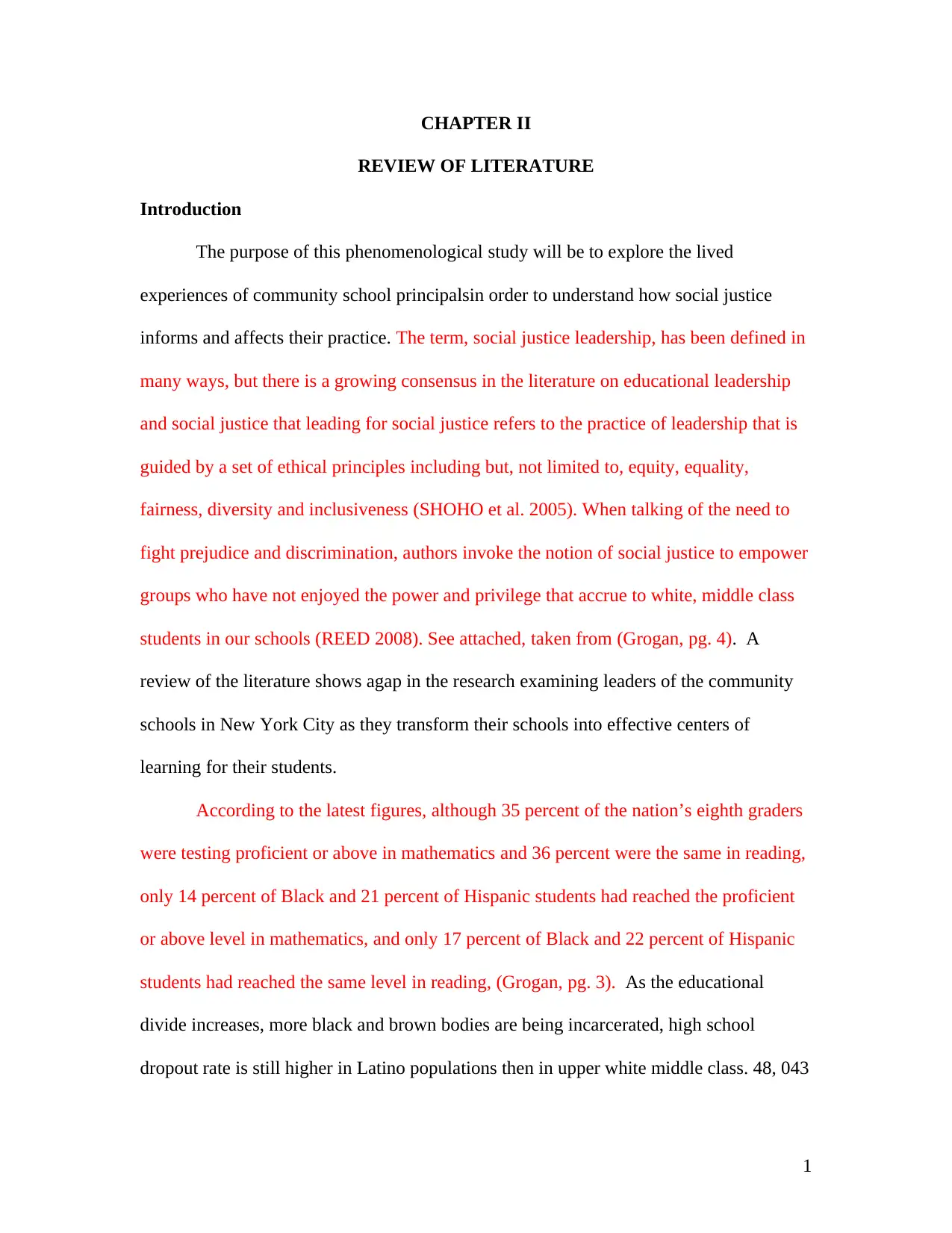
CHAPTER II
REVIEW OF LITERATURE
Introduction
The purpose of this phenomenological study will be to explore the lived
experiences of community school principalsin order to understand how social justice
informs and affects their practice. The term, social justice leadership, has been defined in
many ways, but there is a growing consensus in the literature on educational leadership
and social justice that leading for social justice refers to the practice of leadership that is
guided by a set of ethical principles including but, not limited to, equity, equality,
fairness, diversity and inclusiveness (SHOHO et al. 2005). When talking of the need to
fight prejudice and discrimination, authors invoke the notion of social justice to empower
groups who have not enjoyed the power and privilege that accrue to white, middle class
students in our schools (REED 2008). See attached, taken from (Grogan, pg. 4). A
review of the literature shows agap in the research examining leaders of the community
schools in New York City as they transform their schools into effective centers of
learning for their students.
According to the latest figures, although 35 percent of the nation’s eighth graders
were testing proficient or above in mathematics and 36 percent were the same in reading,
only 14 percent of Black and 21 percent of Hispanic students had reached the proficient
or above level in mathematics, and only 17 percent of Black and 22 percent of Hispanic
students had reached the same level in reading, (Grogan, pg. 3). As the educational
divide increases, more black and brown bodies are being incarcerated, high school
dropout rate is still higher in Latino populations then in upper white middle class. 48, 043
1
REVIEW OF LITERATURE
Introduction
The purpose of this phenomenological study will be to explore the lived
experiences of community school principalsin order to understand how social justice
informs and affects their practice. The term, social justice leadership, has been defined in
many ways, but there is a growing consensus in the literature on educational leadership
and social justice that leading for social justice refers to the practice of leadership that is
guided by a set of ethical principles including but, not limited to, equity, equality,
fairness, diversity and inclusiveness (SHOHO et al. 2005). When talking of the need to
fight prejudice and discrimination, authors invoke the notion of social justice to empower
groups who have not enjoyed the power and privilege that accrue to white, middle class
students in our schools (REED 2008). See attached, taken from (Grogan, pg. 4). A
review of the literature shows agap in the research examining leaders of the community
schools in New York City as they transform their schools into effective centers of
learning for their students.
According to the latest figures, although 35 percent of the nation’s eighth graders
were testing proficient or above in mathematics and 36 percent were the same in reading,
only 14 percent of Black and 21 percent of Hispanic students had reached the proficient
or above level in mathematics, and only 17 percent of Black and 22 percent of Hispanic
students had reached the same level in reading, (Grogan, pg. 3). As the educational
divide increases, more black and brown bodies are being incarcerated, high school
dropout rate is still higher in Latino populations then in upper white middle class. 48, 043
1
Secure Best Marks with AI Grader
Need help grading? Try our AI Grader for instant feedback on your assignments.
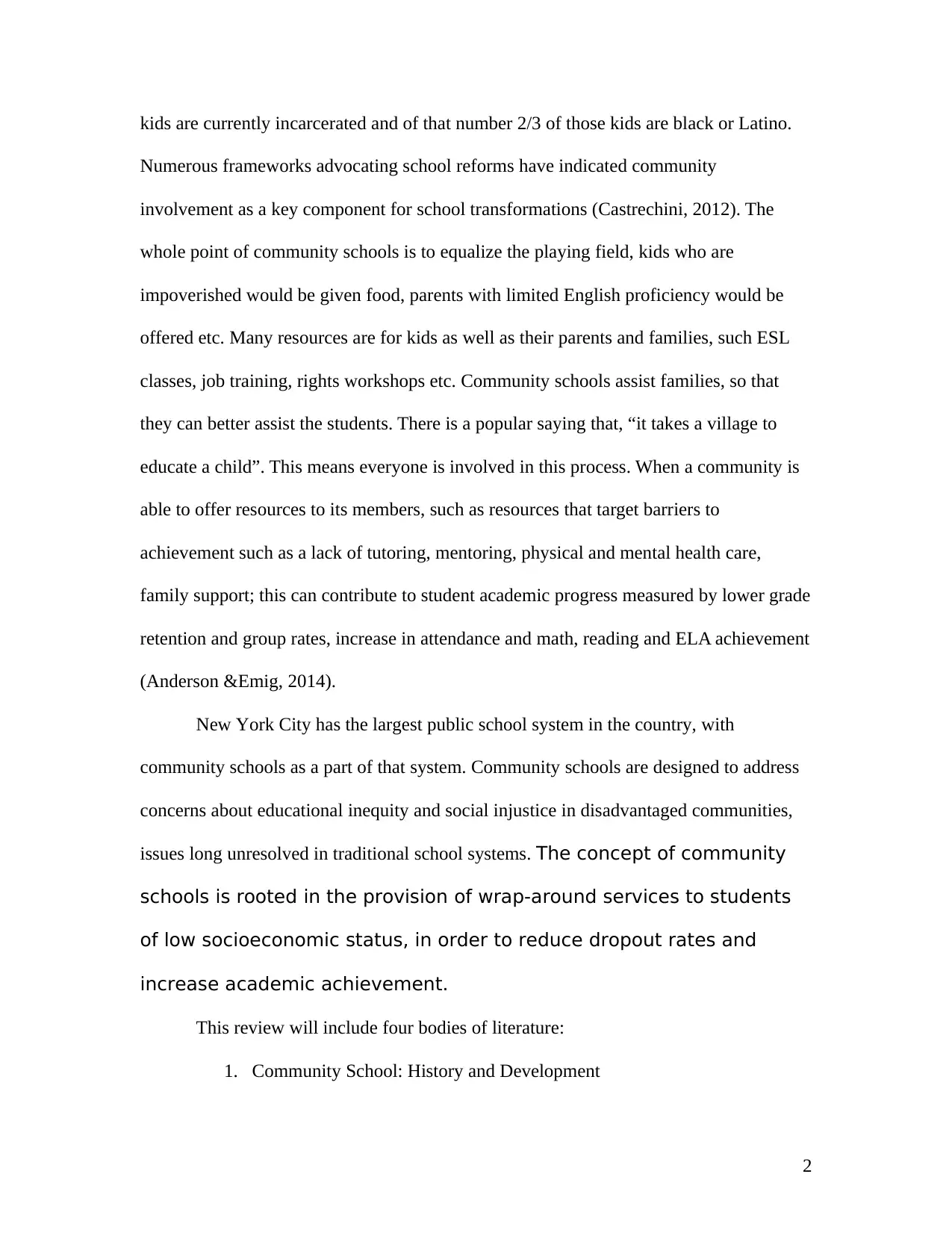
kids are currently incarcerated and of that number 2/3 of those kids are black or Latino.
Numerous frameworks advocating school reforms have indicated community
involvement as a key component for school transformations (Castrechini, 2012). The
whole point of community schools is to equalize the playing field, kids who are
impoverished would be given food, parents with limited English proficiency would be
offered etc. Many resources are for kids as well as their parents and families, such ESL
classes, job training, rights workshops etc. Community schools assist families, so that
they can better assist the students. There is a popular saying that, “it takes a village to
educate a child”. This means everyone is involved in this process. When a community is
able to offer resources to its members, such as resources that target barriers to
achievement such as a lack of tutoring, mentoring, physical and mental health care,
family support; this can contribute to student academic progress measured by lower grade
retention and group rates, increase in attendance and math, reading and ELA achievement
(Anderson &Emig, 2014).
New York City has the largest public school system in the country, with
community schools as a part of that system. Community schools are designed to address
concerns about educational inequity and social injustice in disadvantaged communities,
issues long unresolved in traditional school systems. The concept of community
schools is rooted in the provision of wrap-around services to students
of low socioeconomic status, in order to reduce dropout rates and
increase academic achievement.
This review will include four bodies of literature:
1. Community School: History and Development
2
Numerous frameworks advocating school reforms have indicated community
involvement as a key component for school transformations (Castrechini, 2012). The
whole point of community schools is to equalize the playing field, kids who are
impoverished would be given food, parents with limited English proficiency would be
offered etc. Many resources are for kids as well as their parents and families, such ESL
classes, job training, rights workshops etc. Community schools assist families, so that
they can better assist the students. There is a popular saying that, “it takes a village to
educate a child”. This means everyone is involved in this process. When a community is
able to offer resources to its members, such as resources that target barriers to
achievement such as a lack of tutoring, mentoring, physical and mental health care,
family support; this can contribute to student academic progress measured by lower grade
retention and group rates, increase in attendance and math, reading and ELA achievement
(Anderson &Emig, 2014).
New York City has the largest public school system in the country, with
community schools as a part of that system. Community schools are designed to address
concerns about educational inequity and social injustice in disadvantaged communities,
issues long unresolved in traditional school systems. The concept of community
schools is rooted in the provision of wrap-around services to students
of low socioeconomic status, in order to reduce dropout rates and
increase academic achievement.
This review will include four bodies of literature:
1. Community School: History and Development
2
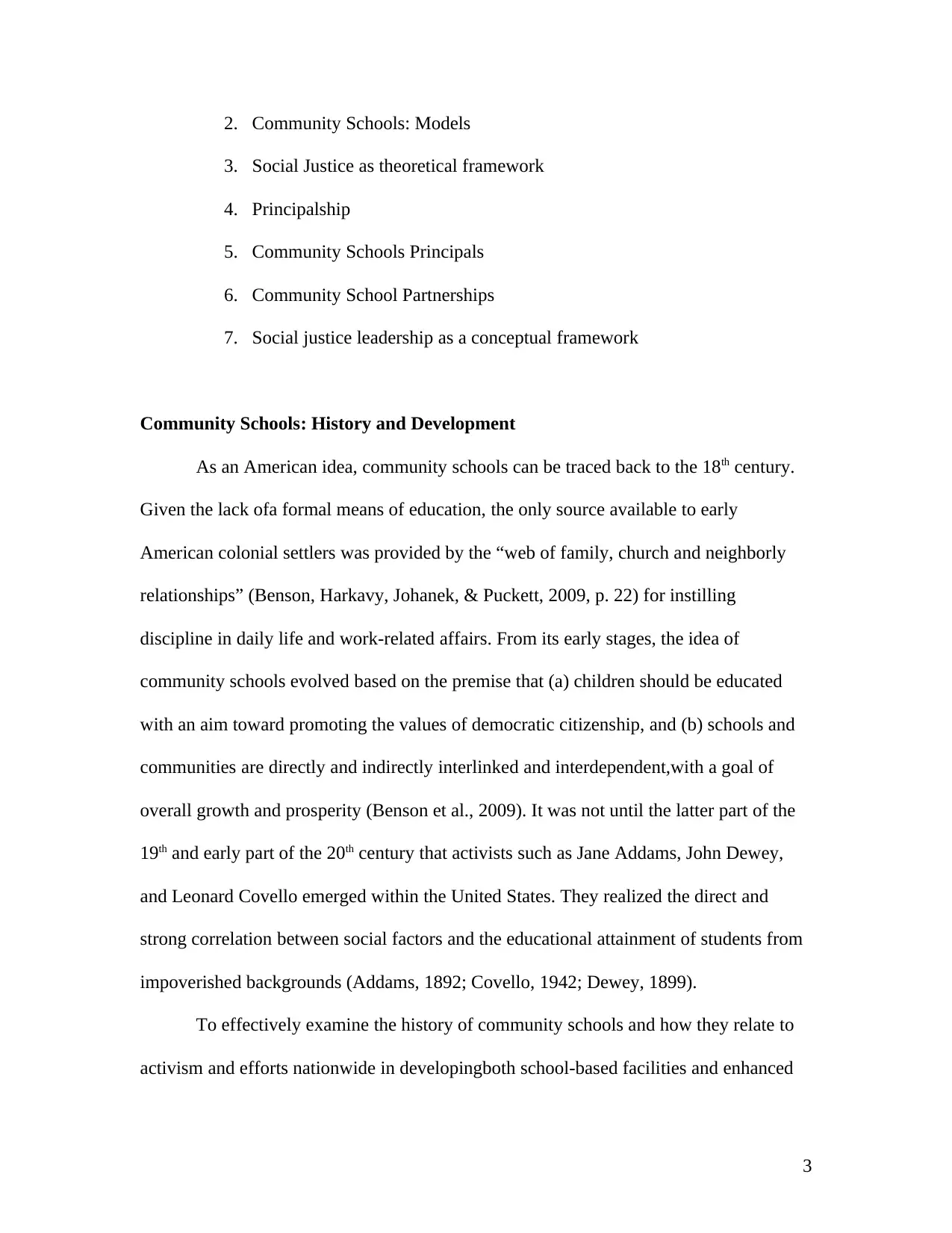
2. Community Schools: Models
3. Social Justice as theoretical framework
4. Principalship
5. Community Schools Principals
6. Community School Partnerships
7. Social justice leadership as a conceptual framework
Community Schools: History and Development
As an American idea, community schools can be traced back to the 18th century.
Given the lack ofa formal means of education, the only source available to early
American colonial settlers was provided by the “web of family, church and neighborly
relationships” (Benson, Harkavy, Johanek, & Puckett, 2009, p. 22) for instilling
discipline in daily life and work-related affairs. From its early stages, the idea of
community schools evolved based on the premise that (a) children should be educated
with an aim toward promoting the values of democratic citizenship, and (b) schools and
communities are directly and indirectly interlinked and interdependent,with a goal of
overall growth and prosperity (Benson et al., 2009). It was not until the latter part of the
19th and early part of the 20th century that activists such as Jane Addams, John Dewey,
and Leonard Covello emerged within the United States. They realized the direct and
strong correlation between social factors and the educational attainment of students from
impoverished backgrounds (Addams, 1892; Covello, 1942; Dewey, 1899).
To effectively examine the history of community schools and how they relate to
activism and efforts nationwide in developingboth school-based facilities and enhanced
3
3. Social Justice as theoretical framework
4. Principalship
5. Community Schools Principals
6. Community School Partnerships
7. Social justice leadership as a conceptual framework
Community Schools: History and Development
As an American idea, community schools can be traced back to the 18th century.
Given the lack ofa formal means of education, the only source available to early
American colonial settlers was provided by the “web of family, church and neighborly
relationships” (Benson, Harkavy, Johanek, & Puckett, 2009, p. 22) for instilling
discipline in daily life and work-related affairs. From its early stages, the idea of
community schools evolved based on the premise that (a) children should be educated
with an aim toward promoting the values of democratic citizenship, and (b) schools and
communities are directly and indirectly interlinked and interdependent,with a goal of
overall growth and prosperity (Benson et al., 2009). It was not until the latter part of the
19th and early part of the 20th century that activists such as Jane Addams, John Dewey,
and Leonard Covello emerged within the United States. They realized the direct and
strong correlation between social factors and the educational attainment of students from
impoverished backgrounds (Addams, 1892; Covello, 1942; Dewey, 1899).
To effectively examine the history of community schools and how they relate to
activism and efforts nationwide in developingboth school-based facilities and enhanced
3
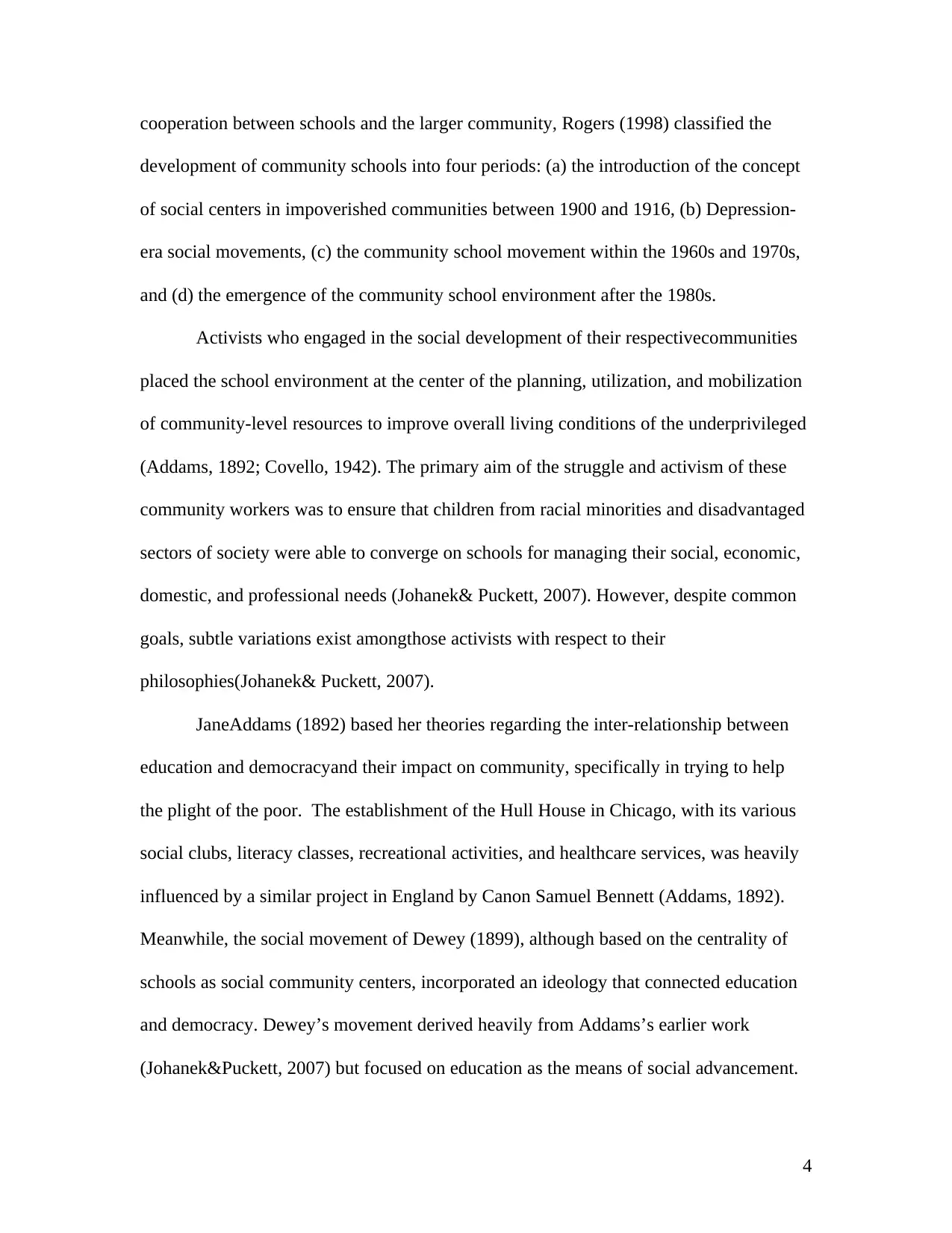
cooperation between schools and the larger community, Rogers (1998) classified the
development of community schools into four periods: (a) the introduction of the concept
of social centers in impoverished communities between 1900 and 1916, (b) Depression-
era social movements, (c) the community school movement within the 1960s and 1970s,
and (d) the emergence of the community school environment after the 1980s.
Activists who engaged in the social development of their respectivecommunities
placed the school environment at the center of the planning, utilization, and mobilization
of community-level resources to improve overall living conditions of the underprivileged
(Addams, 1892; Covello, 1942). The primary aim of the struggle and activism of these
community workers was to ensure that children from racial minorities and disadvantaged
sectors of society were able to converge on schools for managing their social, economic,
domestic, and professional needs (Johanek& Puckett, 2007). However, despite common
goals, subtle variations exist amongthose activists with respect to their
philosophies(Johanek& Puckett, 2007).
JaneAddams (1892) based her theories regarding the inter-relationship between
education and democracyand their impact on community, specifically in trying to help
the plight of the poor. The establishment of the Hull House in Chicago, with its various
social clubs, literacy classes, recreational activities, and healthcare services, was heavily
influenced by a similar project in England by Canon Samuel Bennett (Addams, 1892).
Meanwhile, the social movement of Dewey (1899), although based on the centrality of
schools as social community centers, incorporated an ideology that connected education
and democracy. Dewey’s movement derived heavily from Addams’s earlier work
(Johanek&Puckett, 2007) but focused on education as the means of social advancement.
4
development of community schools into four periods: (a) the introduction of the concept
of social centers in impoverished communities between 1900 and 1916, (b) Depression-
era social movements, (c) the community school movement within the 1960s and 1970s,
and (d) the emergence of the community school environment after the 1980s.
Activists who engaged in the social development of their respectivecommunities
placed the school environment at the center of the planning, utilization, and mobilization
of community-level resources to improve overall living conditions of the underprivileged
(Addams, 1892; Covello, 1942). The primary aim of the struggle and activism of these
community workers was to ensure that children from racial minorities and disadvantaged
sectors of society were able to converge on schools for managing their social, economic,
domestic, and professional needs (Johanek& Puckett, 2007). However, despite common
goals, subtle variations exist amongthose activists with respect to their
philosophies(Johanek& Puckett, 2007).
JaneAddams (1892) based her theories regarding the inter-relationship between
education and democracyand their impact on community, specifically in trying to help
the plight of the poor. The establishment of the Hull House in Chicago, with its various
social clubs, literacy classes, recreational activities, and healthcare services, was heavily
influenced by a similar project in England by Canon Samuel Bennett (Addams, 1892).
Meanwhile, the social movement of Dewey (1899), although based on the centrality of
schools as social community centers, incorporated an ideology that connected education
and democracy. Dewey’s movement derived heavily from Addams’s earlier work
(Johanek&Puckett, 2007) but focused on education as the means of social advancement.
4
Secure Best Marks with AI Grader
Need help grading? Try our AI Grader for instant feedback on your assignments.
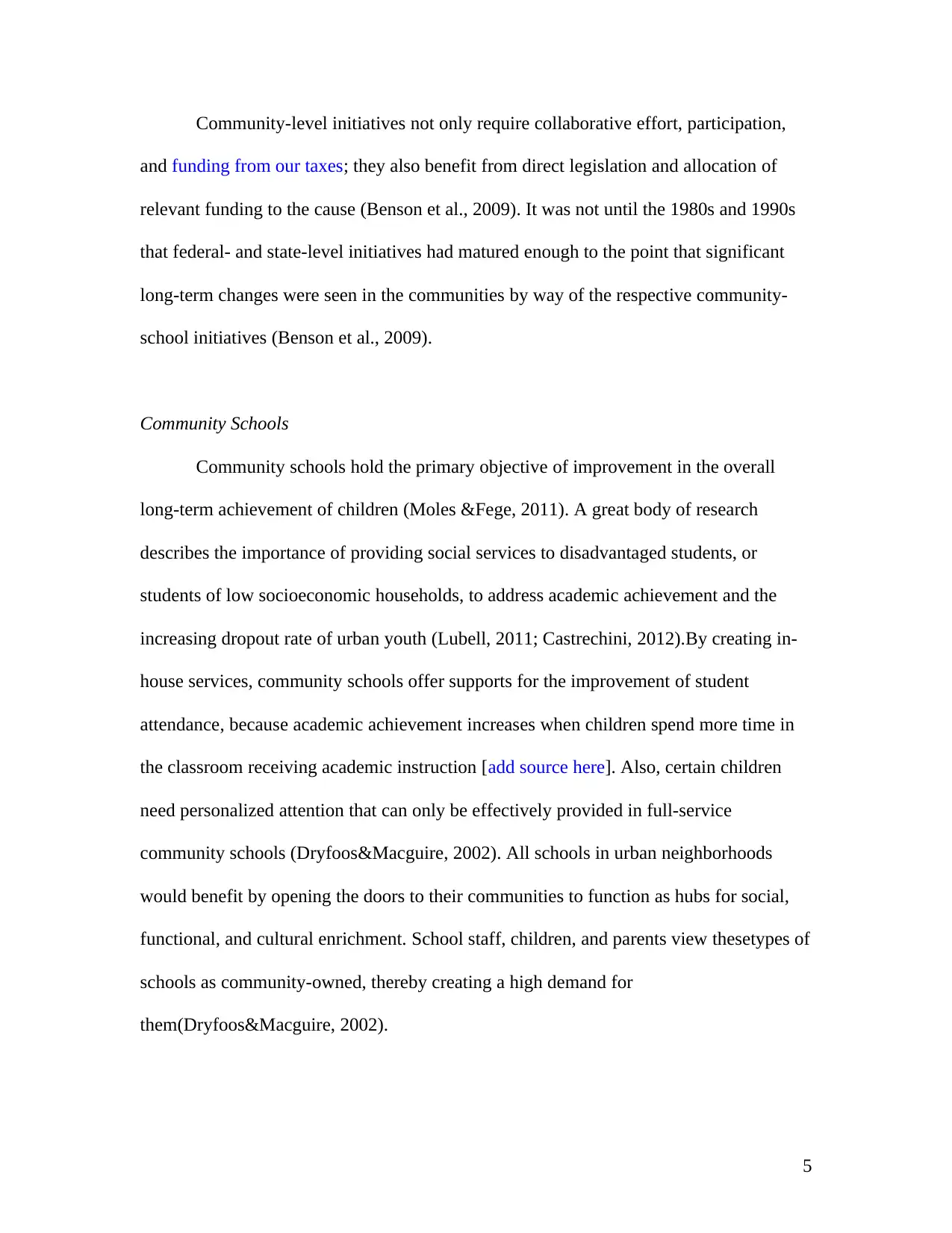
Community-level initiatives not only require collaborative effort, participation,
and funding from our taxes; they also benefit from direct legislation and allocation of
relevant funding to the cause (Benson et al., 2009). It was not until the 1980s and 1990s
that federal- and state-level initiatives had matured enough to the point that significant
long-term changes were seen in the communities by way of the respective community-
school initiatives (Benson et al., 2009).
Community Schools
Community schools hold the primary objective of improvement in the overall
long-term achievement of children (Moles &Fege, 2011). A great body of research
describes the importance of providing social services to disadvantaged students, or
students of low socioeconomic households, to address academic achievement and the
increasing dropout rate of urban youth (Lubell, 2011; Castrechini, 2012).By creating in-
house services, community schools offer supports for the improvement of student
attendance, because academic achievement increases when children spend more time in
the classroom receiving academic instruction [add source here]. Also, certain children
need personalized attention that can only be effectively provided in full-service
community schools (Dryfoos&Macguire, 2002). All schools in urban neighborhoods
would benefit by opening the doors to their communities to function as hubs for social,
functional, and cultural enrichment. School staff, children, and parents view thesetypes of
schools as community-owned, thereby creating a high demand for
them(Dryfoos&Macguire, 2002).
5
and funding from our taxes; they also benefit from direct legislation and allocation of
relevant funding to the cause (Benson et al., 2009). It was not until the 1980s and 1990s
that federal- and state-level initiatives had matured enough to the point that significant
long-term changes were seen in the communities by way of the respective community-
school initiatives (Benson et al., 2009).
Community Schools
Community schools hold the primary objective of improvement in the overall
long-term achievement of children (Moles &Fege, 2011). A great body of research
describes the importance of providing social services to disadvantaged students, or
students of low socioeconomic households, to address academic achievement and the
increasing dropout rate of urban youth (Lubell, 2011; Castrechini, 2012).By creating in-
house services, community schools offer supports for the improvement of student
attendance, because academic achievement increases when children spend more time in
the classroom receiving academic instruction [add source here]. Also, certain children
need personalized attention that can only be effectively provided in full-service
community schools (Dryfoos&Macguire, 2002). All schools in urban neighborhoods
would benefit by opening the doors to their communities to function as hubs for social,
functional, and cultural enrichment. School staff, children, and parents view thesetypes of
schools as community-owned, thereby creating a high demand for
them(Dryfoos&Macguire, 2002).
5
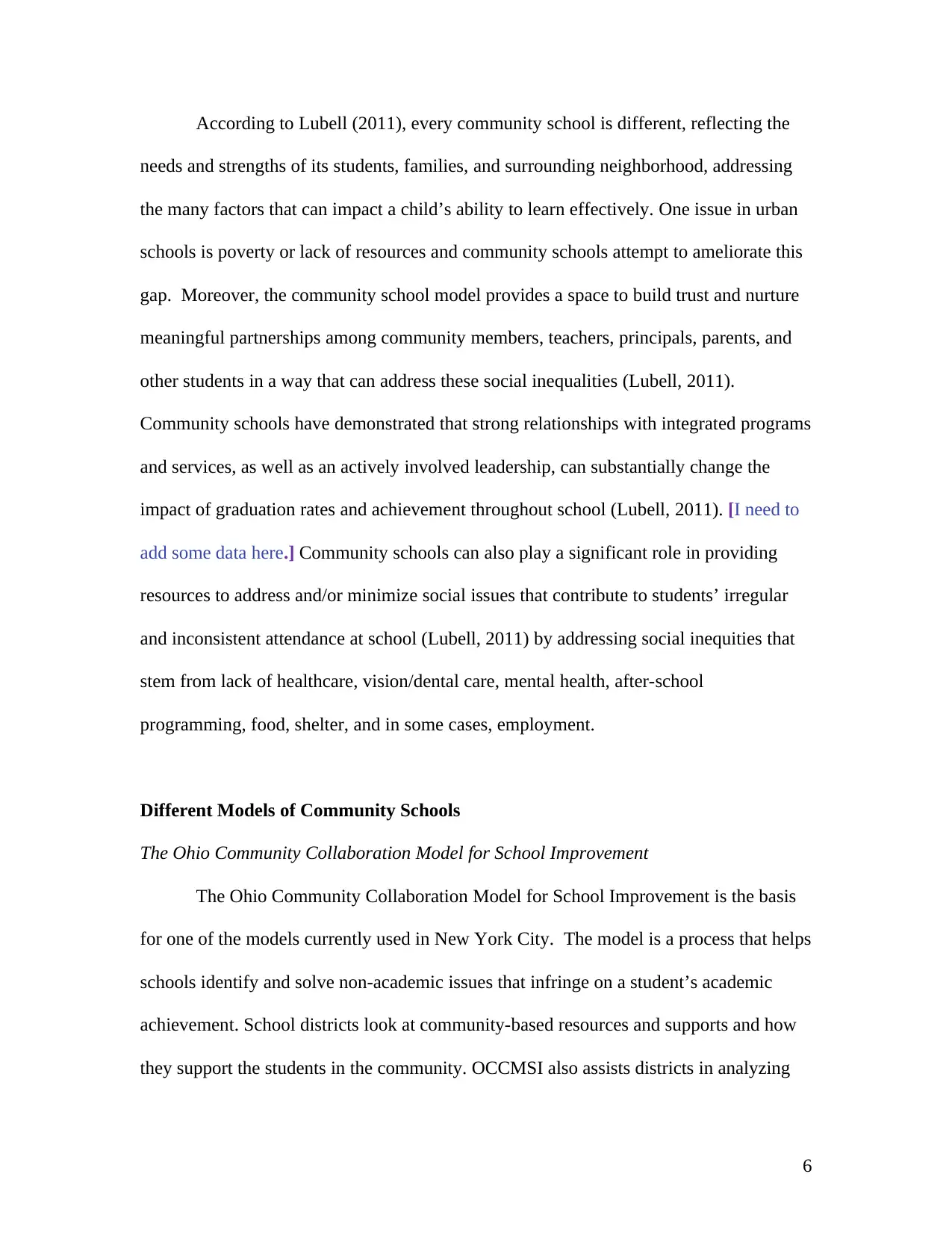
According to Lubell (2011), every community school is different, reflecting the
needs and strengths of its students, families, and surrounding neighborhood, addressing
the many factors that can impact a child’s ability to learn effectively. One issue in urban
schools is poverty or lack of resources and community schools attempt to ameliorate this
gap. Moreover, the community school model provides a space to build trust and nurture
meaningful partnerships among community members, teachers, principals, parents, and
other students in a way that can address these social inequalities (Lubell, 2011).
Community schools have demonstrated that strong relationships with integrated programs
and services, as well as an actively involved leadership, can substantially change the
impact of graduation rates and achievement throughout school (Lubell, 2011). [I need to
add some data here.] Community schools can also play a significant role in providing
resources to address and/or minimize social issues that contribute to students’ irregular
and inconsistent attendance at school (Lubell, 2011) by addressing social inequities that
stem from lack of healthcare, vision/dental care, mental health, after-school
programming, food, shelter, and in some cases, employment.
Different Models of Community Schools
The Ohio Community Collaboration Model for School Improvement
The Ohio Community Collaboration Model for School Improvement is the basis
for one of the models currently used in New York City. The model is a process that helps
schools identify and solve non-academic issues that infringe on a student’s academic
achievement. School districts look at community-based resources and supports and how
they support the students in the community. OCCMSI also assists districts in analyzing
6
needs and strengths of its students, families, and surrounding neighborhood, addressing
the many factors that can impact a child’s ability to learn effectively. One issue in urban
schools is poverty or lack of resources and community schools attempt to ameliorate this
gap. Moreover, the community school model provides a space to build trust and nurture
meaningful partnerships among community members, teachers, principals, parents, and
other students in a way that can address these social inequalities (Lubell, 2011).
Community schools have demonstrated that strong relationships with integrated programs
and services, as well as an actively involved leadership, can substantially change the
impact of graduation rates and achievement throughout school (Lubell, 2011). [I need to
add some data here.] Community schools can also play a significant role in providing
resources to address and/or minimize social issues that contribute to students’ irregular
and inconsistent attendance at school (Lubell, 2011) by addressing social inequities that
stem from lack of healthcare, vision/dental care, mental health, after-school
programming, food, shelter, and in some cases, employment.
Different Models of Community Schools
The Ohio Community Collaboration Model for School Improvement
The Ohio Community Collaboration Model for School Improvement is the basis
for one of the models currently used in New York City. The model is a process that helps
schools identify and solve non-academic issues that infringe on a student’s academic
achievement. School districts look at community-based resources and supports and how
they support the students in the community. OCCMSI also assists districts in analyzing
6
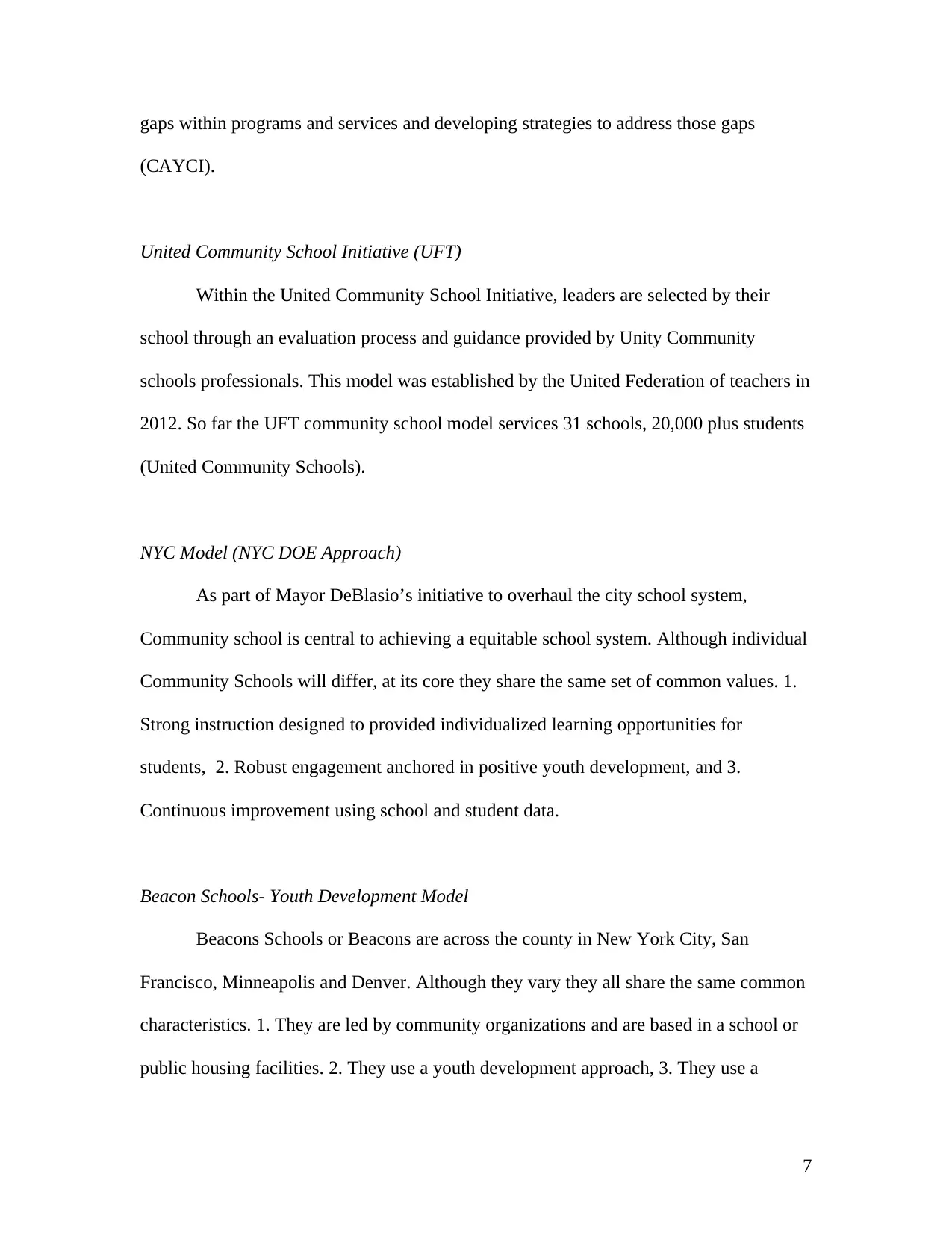
gaps within programs and services and developing strategies to address those gaps
(CAYCI).
United Community School Initiative (UFT)
Within the United Community School Initiative, leaders are selected by their
school through an evaluation process and guidance provided by Unity Community
schools professionals. This model was established by the United Federation of teachers in
2012. So far the UFT community school model services 31 schools, 20,000 plus students
(United Community Schools).
NYC Model (NYC DOE Approach)
As part of Mayor DeBlasio’s initiative to overhaul the city school system,
Community school is central to achieving a equitable school system. Although individual
Community Schools will differ, at its core they share the same set of common values. 1.
Strong instruction designed to provided individualized learning opportunities for
students, 2. Robust engagement anchored in positive youth development, and 3.
Continuous improvement using school and student data.
Beacon Schools- Youth Development Model
Beacons Schools or Beacons are across the county in New York City, San
Francisco, Minneapolis and Denver. Although they vary they all share the same common
characteristics. 1. They are led by community organizations and are based in a school or
public housing facilities. 2. They use a youth development approach, 3. They use a
7
(CAYCI).
United Community School Initiative (UFT)
Within the United Community School Initiative, leaders are selected by their
school through an evaluation process and guidance provided by Unity Community
schools professionals. This model was established by the United Federation of teachers in
2012. So far the UFT community school model services 31 schools, 20,000 plus students
(United Community Schools).
NYC Model (NYC DOE Approach)
As part of Mayor DeBlasio’s initiative to overhaul the city school system,
Community school is central to achieving a equitable school system. Although individual
Community Schools will differ, at its core they share the same set of common values. 1.
Strong instruction designed to provided individualized learning opportunities for
students, 2. Robust engagement anchored in positive youth development, and 3.
Continuous improvement using school and student data.
Beacon Schools- Youth Development Model
Beacons Schools or Beacons are across the county in New York City, San
Francisco, Minneapolis and Denver. Although they vary they all share the same common
characteristics. 1. They are led by community organizations and are based in a school or
public housing facilities. 2. They use a youth development approach, 3. They use a
7
Paraphrase This Document
Need a fresh take? Get an instant paraphrase of this document with our AI Paraphraser
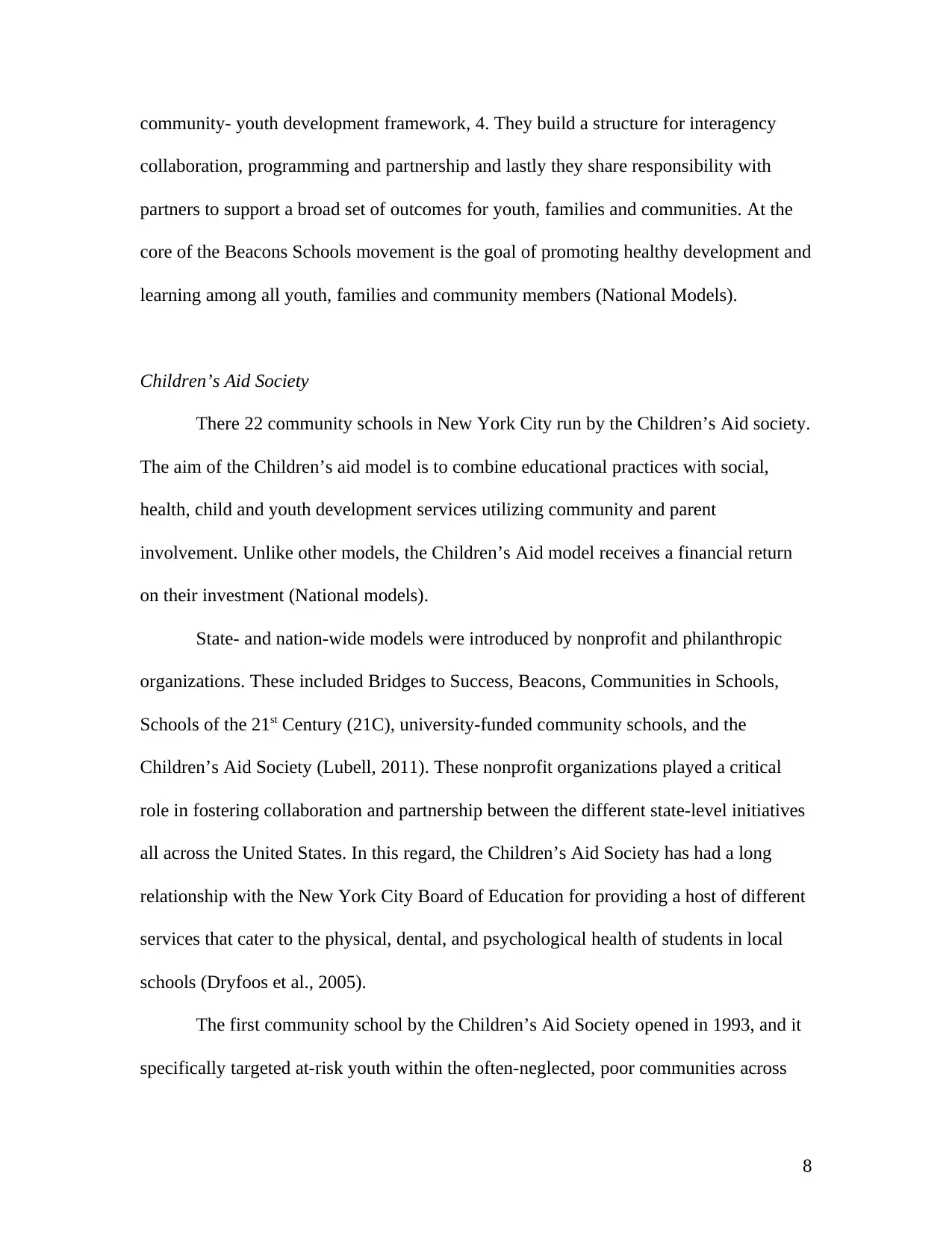
community- youth development framework, 4. They build a structure for interagency
collaboration, programming and partnership and lastly they share responsibility with
partners to support a broad set of outcomes for youth, families and communities. At the
core of the Beacons Schools movement is the goal of promoting healthy development and
learning among all youth, families and community members (National Models).
Children’s Aid Society
There 22 community schools in New York City run by the Children’s Aid society.
The aim of the Children’s aid model is to combine educational practices with social,
health, child and youth development services utilizing community and parent
involvement. Unlike other models, the Children’s Aid model receives a financial return
on their investment (National models).
State- and nation-wide models were introduced by nonprofit and philanthropic
organizations. These included Bridges to Success, Beacons, Communities in Schools,
Schools of the 21st Century (21C), university-funded community schools, and the
Children’s Aid Society (Lubell, 2011). These nonprofit organizations played a critical
role in fostering collaboration and partnership between the different state-level initiatives
all across the United States. In this regard, the Children’s Aid Society has had a long
relationship with the New York City Board of Education for providing a host of different
services that cater to the physical, dental, and psychological health of students in local
schools (Dryfoos et al., 2005).
The first community school by the Children’s Aid Society opened in 1993, and it
specifically targeted at-risk youth within the often-neglected, poor communities across
8
collaboration, programming and partnership and lastly they share responsibility with
partners to support a broad set of outcomes for youth, families and communities. At the
core of the Beacons Schools movement is the goal of promoting healthy development and
learning among all youth, families and community members (National Models).
Children’s Aid Society
There 22 community schools in New York City run by the Children’s Aid society.
The aim of the Children’s aid model is to combine educational practices with social,
health, child and youth development services utilizing community and parent
involvement. Unlike other models, the Children’s Aid model receives a financial return
on their investment (National models).
State- and nation-wide models were introduced by nonprofit and philanthropic
organizations. These included Bridges to Success, Beacons, Communities in Schools,
Schools of the 21st Century (21C), university-funded community schools, and the
Children’s Aid Society (Lubell, 2011). These nonprofit organizations played a critical
role in fostering collaboration and partnership between the different state-level initiatives
all across the United States. In this regard, the Children’s Aid Society has had a long
relationship with the New York City Board of Education for providing a host of different
services that cater to the physical, dental, and psychological health of students in local
schools (Dryfoos et al., 2005).
The first community school by the Children’s Aid Society opened in 1993, and it
specifically targeted at-risk youth within the often-neglected, poor communities across
8
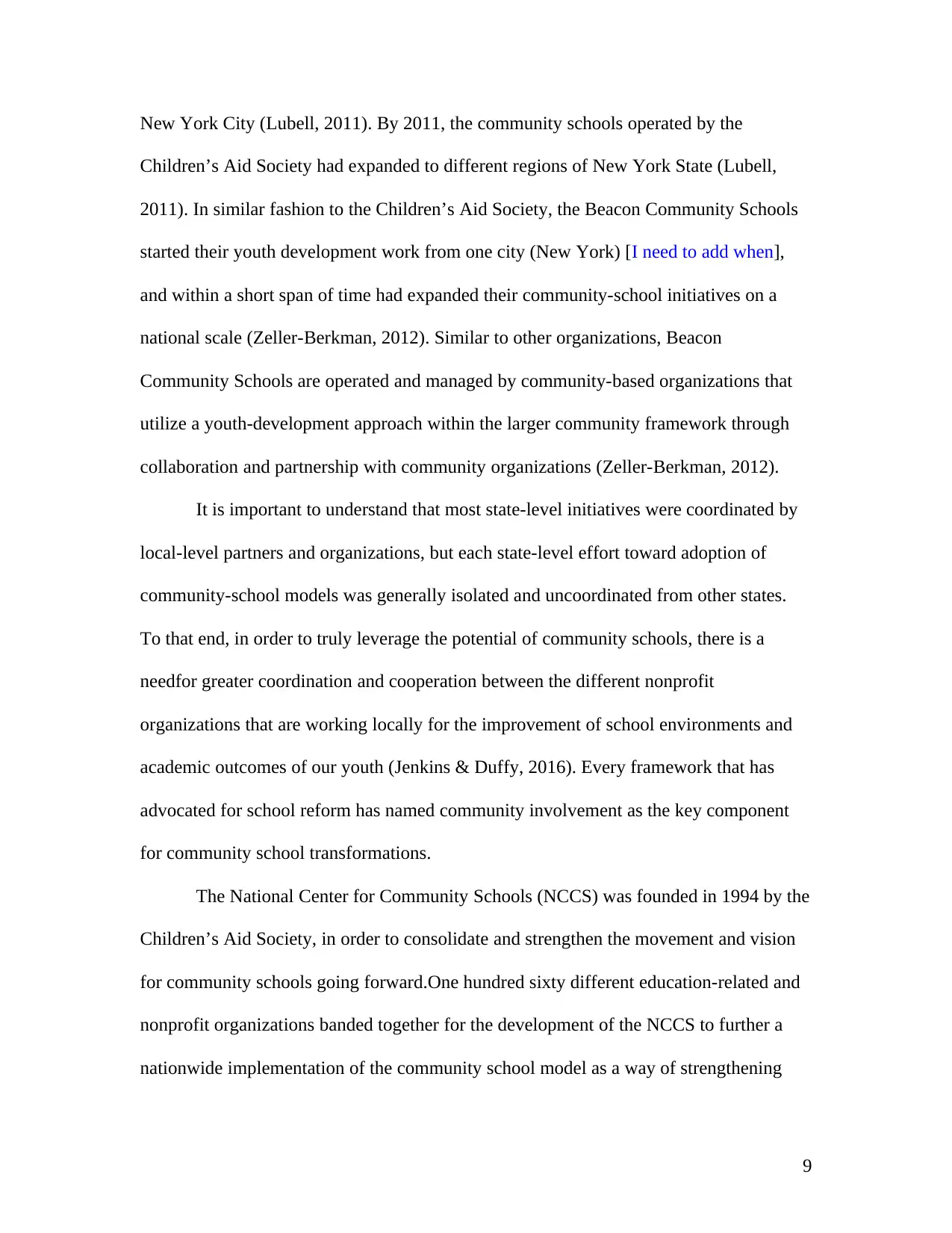
New York City (Lubell, 2011). By 2011, the community schools operated by the
Children’s Aid Society had expanded to different regions of New York State (Lubell,
2011). In similar fashion to the Children’s Aid Society, the Beacon Community Schools
started their youth development work from one city (New York) [I need to add when],
and within a short span of time had expanded their community-school initiatives on a
national scale (Zeller-Berkman, 2012). Similar to other organizations, Beacon
Community Schools are operated and managed by community-based organizations that
utilize a youth-development approach within the larger community framework through
collaboration and partnership with community organizations (Zeller-Berkman, 2012).
It is important to understand that most state-level initiatives were coordinated by
local-level partners and organizations, but each state-level effort toward adoption of
community-school models was generally isolated and uncoordinated from other states.
To that end, in order to truly leverage the potential of community schools, there is a
needfor greater coordination and cooperation between the different nonprofit
organizations that are working locally for the improvement of school environments and
academic outcomes of our youth (Jenkins & Duffy, 2016). Every framework that has
advocated for school reform has named community involvement as the key component
for community school transformations.
The National Center for Community Schools (NCCS) was founded in 1994 by the
Children’s Aid Society, in order to consolidate and strengthen the movement and vision
for community schools going forward.One hundred sixty different education-related and
nonprofit organizations banded together for the development of the NCCS to further a
nationwide implementation of the community school model as a way of strengthening
9
Children’s Aid Society had expanded to different regions of New York State (Lubell,
2011). In similar fashion to the Children’s Aid Society, the Beacon Community Schools
started their youth development work from one city (New York) [I need to add when],
and within a short span of time had expanded their community-school initiatives on a
national scale (Zeller-Berkman, 2012). Similar to other organizations, Beacon
Community Schools are operated and managed by community-based organizations that
utilize a youth-development approach within the larger community framework through
collaboration and partnership with community organizations (Zeller-Berkman, 2012).
It is important to understand that most state-level initiatives were coordinated by
local-level partners and organizations, but each state-level effort toward adoption of
community-school models was generally isolated and uncoordinated from other states.
To that end, in order to truly leverage the potential of community schools, there is a
needfor greater coordination and cooperation between the different nonprofit
organizations that are working locally for the improvement of school environments and
academic outcomes of our youth (Jenkins & Duffy, 2016). Every framework that has
advocated for school reform has named community involvement as the key component
for community school transformations.
The National Center for Community Schools (NCCS) was founded in 1994 by the
Children’s Aid Society, in order to consolidate and strengthen the movement and vision
for community schools going forward.One hundred sixty different education-related and
nonprofit organizations banded together for the development of the NCCS to further a
nationwide implementation of the community school model as a way of strengthening
9

partnerships between schools, parents, and communities at large (Benson et al., 2009).
These local partnerships play an integral role in the status and success of community
schools, and this relationship can be seen throughout the literature (Lubell, 2011; Zeller-
Berkman, 2012; Dryfoos&Macguire, 2002). Therefore, recent efforts by federal- and
community-level stakeholders are bound to have widespread, positive changes in the
educational system, specifically within the state of New York, which will serve as an
exemplary case of community school initiatives for other states to follow and replicate
(NYC Community School Advisory Board [CSAB], 2015). Federal legislation such as
The No Child Left Behind Act (2001) was created for the purpose of addressing the
achievement gap that exits between white students and minority students. Such
legislation will be the driving force behind the Community Schools movement.
Federal- and State-Level Initiatives for Community Schools
Benson et al. (2009) noted that community schools cannot be examined without
the lens of federal and state initiatives that shape legislation and educational policy. [I
need to develop this some more]Moles and Fege (2011) noted that some of the major
elements of a successful, long-term reform in [I need to develop this some more]
community schools include federal-level legislationmeaning that this initiative has
national priority. Federal funding and support, along with a shared visionand collective
action by different community stakeholders, fosters capacity-building in schools,
facilitating parent-school engagement, and community-level support and
coordination.Federal involvement also includes continuous research for assessing
performance and proposing improvements.
10
These local partnerships play an integral role in the status and success of community
schools, and this relationship can be seen throughout the literature (Lubell, 2011; Zeller-
Berkman, 2012; Dryfoos&Macguire, 2002). Therefore, recent efforts by federal- and
community-level stakeholders are bound to have widespread, positive changes in the
educational system, specifically within the state of New York, which will serve as an
exemplary case of community school initiatives for other states to follow and replicate
(NYC Community School Advisory Board [CSAB], 2015). Federal legislation such as
The No Child Left Behind Act (2001) was created for the purpose of addressing the
achievement gap that exits between white students and minority students. Such
legislation will be the driving force behind the Community Schools movement.
Federal- and State-Level Initiatives for Community Schools
Benson et al. (2009) noted that community schools cannot be examined without
the lens of federal and state initiatives that shape legislation and educational policy. [I
need to develop this some more]Moles and Fege (2011) noted that some of the major
elements of a successful, long-term reform in [I need to develop this some more]
community schools include federal-level legislationmeaning that this initiative has
national priority. Federal funding and support, along with a shared visionand collective
action by different community stakeholders, fosters capacity-building in schools,
facilitating parent-school engagement, and community-level support and
coordination.Federal involvement also includes continuous research for assessing
performance and proposing improvements.
10
Secure Best Marks with AI Grader
Need help grading? Try our AI Grader for instant feedback on your assignments.
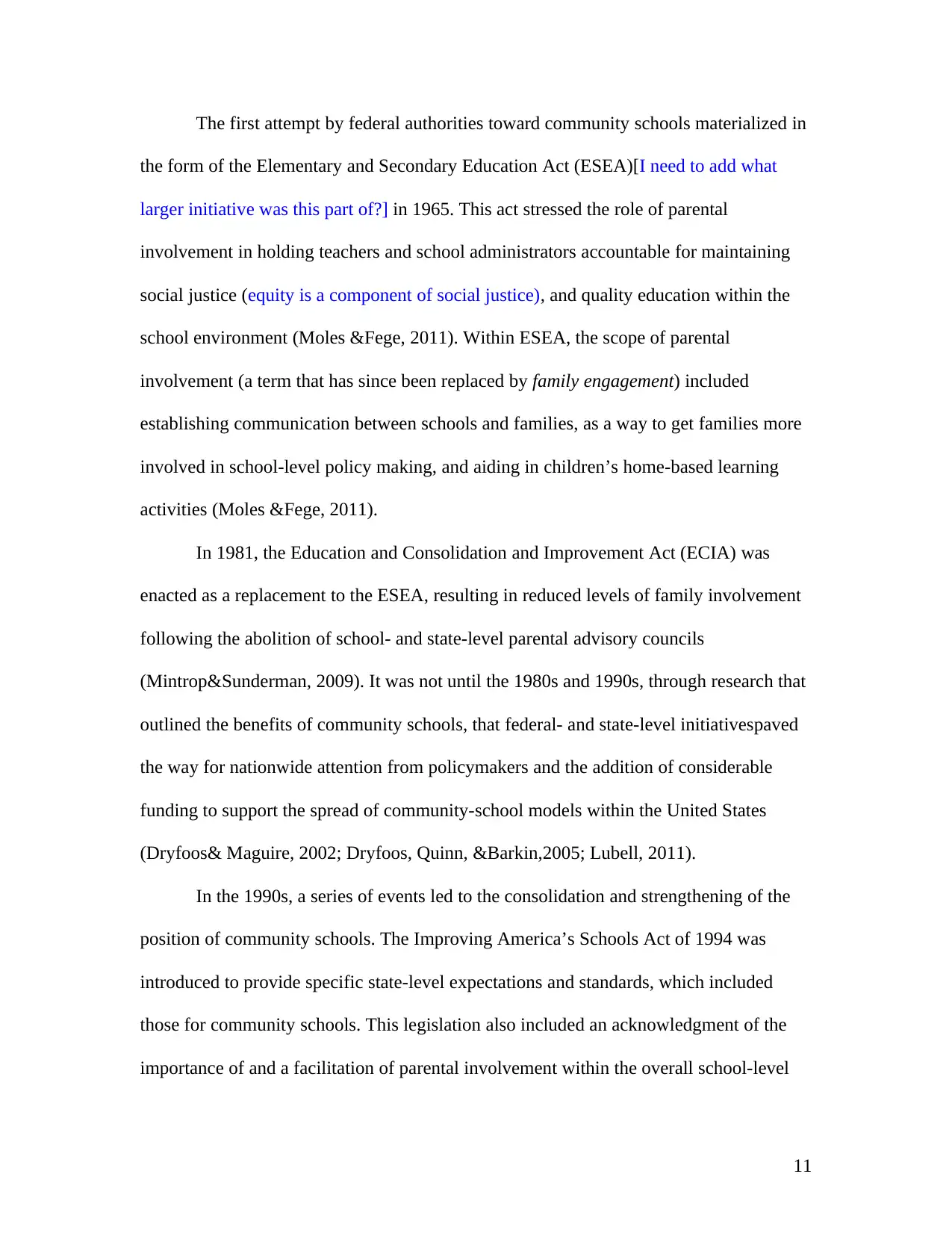
The first attempt by federal authorities toward community schools materialized in
the form of the Elementary and Secondary Education Act (ESEA)[I need to add what
larger initiative was this part of?] in 1965. This act stressed the role of parental
involvement in holding teachers and school administrators accountable for maintaining
social justice (equity is a component of social justice), and quality education within the
school environment (Moles &Fege, 2011). Within ESEA, the scope of parental
involvement (a term that has since been replaced by family engagement) included
establishing communication between schools and families, as a way to get families more
involved in school-level policy making, and aiding in children’s home-based learning
activities (Moles &Fege, 2011).
In 1981, the Education and Consolidation and Improvement Act (ECIA) was
enacted as a replacement to the ESEA, resulting in reduced levels of family involvement
following the abolition of school- and state-level parental advisory councils
(Mintrop&Sunderman, 2009). It was not until the 1980s and 1990s, through research that
outlined the benefits of community schools, that federal- and state-level initiativespaved
the way for nationwide attention from policymakers and the addition of considerable
funding to support the spread of community-school models within the United States
(Dryfoos& Maguire, 2002; Dryfoos, Quinn, &Barkin,2005; Lubell, 2011).
In the 1990s, a series of events led to the consolidation and strengthening of the
position of community schools. The Improving America’s Schools Act of 1994 was
introduced to provide specific state-level expectations and standards, which included
those for community schools. This legislation also included an acknowledgment of the
importance of and a facilitation of parental involvement within the overall school-level
11
the form of the Elementary and Secondary Education Act (ESEA)[I need to add what
larger initiative was this part of?] in 1965. This act stressed the role of parental
involvement in holding teachers and school administrators accountable for maintaining
social justice (equity is a component of social justice), and quality education within the
school environment (Moles &Fege, 2011). Within ESEA, the scope of parental
involvement (a term that has since been replaced by family engagement) included
establishing communication between schools and families, as a way to get families more
involved in school-level policy making, and aiding in children’s home-based learning
activities (Moles &Fege, 2011).
In 1981, the Education and Consolidation and Improvement Act (ECIA) was
enacted as a replacement to the ESEA, resulting in reduced levels of family involvement
following the abolition of school- and state-level parental advisory councils
(Mintrop&Sunderman, 2009). It was not until the 1980s and 1990s, through research that
outlined the benefits of community schools, that federal- and state-level initiativespaved
the way for nationwide attention from policymakers and the addition of considerable
funding to support the spread of community-school models within the United States
(Dryfoos& Maguire, 2002; Dryfoos, Quinn, &Barkin,2005; Lubell, 2011).
In the 1990s, a series of events led to the consolidation and strengthening of the
position of community schools. The Improving America’s Schools Act of 1994 was
introduced to provide specific state-level expectations and standards, which included
those for community schools. This legislation also included an acknowledgment of the
importance of and a facilitation of parental involvement within the overall school-level
11
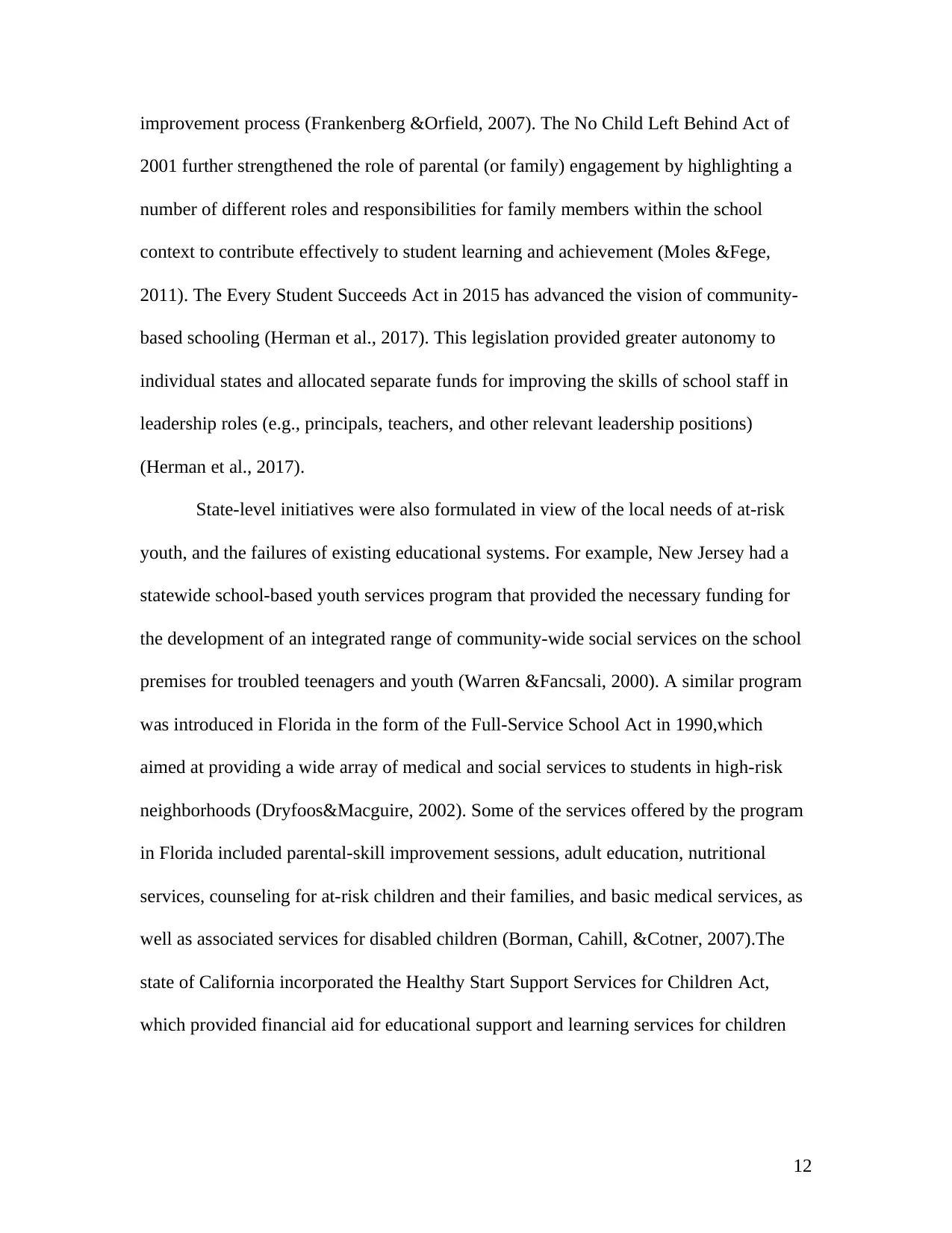
improvement process (Frankenberg &Orfield, 2007). The No Child Left Behind Act of
2001 further strengthened the role of parental (or family) engagement by highlighting a
number of different roles and responsibilities for family members within the school
context to contribute effectively to student learning and achievement (Moles &Fege,
2011). The Every Student Succeeds Act in 2015 has advanced the vision of community-
based schooling (Herman et al., 2017). This legislation provided greater autonomy to
individual states and allocated separate funds for improving the skills of school staff in
leadership roles (e.g., principals, teachers, and other relevant leadership positions)
(Herman et al., 2017).
State-level initiatives were also formulated in view of the local needs of at-risk
youth, and the failures of existing educational systems. For example, New Jersey had a
statewide school-based youth services program that provided the necessary funding for
the development of an integrated range of community-wide social services on the school
premises for troubled teenagers and youth (Warren &Fancsali, 2000). A similar program
was introduced in Florida in the form of the Full-Service School Act in 1990,which
aimed at providing a wide array of medical and social services to students in high-risk
neighborhoods (Dryfoos&Macguire, 2002). Some of the services offered by the program
in Florida included parental-skill improvement sessions, adult education, nutritional
services, counseling for at-risk children and their families, and basic medical services, as
well as associated services for disabled children (Borman, Cahill, &Cotner, 2007).The
state of California incorporated the Healthy Start Support Services for Children Act,
which provided financial aid for educational support and learning services for children
12
2001 further strengthened the role of parental (or family) engagement by highlighting a
number of different roles and responsibilities for family members within the school
context to contribute effectively to student learning and achievement (Moles &Fege,
2011). The Every Student Succeeds Act in 2015 has advanced the vision of community-
based schooling (Herman et al., 2017). This legislation provided greater autonomy to
individual states and allocated separate funds for improving the skills of school staff in
leadership roles (e.g., principals, teachers, and other relevant leadership positions)
(Herman et al., 2017).
State-level initiatives were also formulated in view of the local needs of at-risk
youth, and the failures of existing educational systems. For example, New Jersey had a
statewide school-based youth services program that provided the necessary funding for
the development of an integrated range of community-wide social services on the school
premises for troubled teenagers and youth (Warren &Fancsali, 2000). A similar program
was introduced in Florida in the form of the Full-Service School Act in 1990,which
aimed at providing a wide array of medical and social services to students in high-risk
neighborhoods (Dryfoos&Macguire, 2002). Some of the services offered by the program
in Florida included parental-skill improvement sessions, adult education, nutritional
services, counseling for at-risk children and their families, and basic medical services, as
well as associated services for disabled children (Borman, Cahill, &Cotner, 2007).The
state of California incorporated the Healthy Start Support Services for Children Act,
which provided financial aid for educational support and learning services for children
12
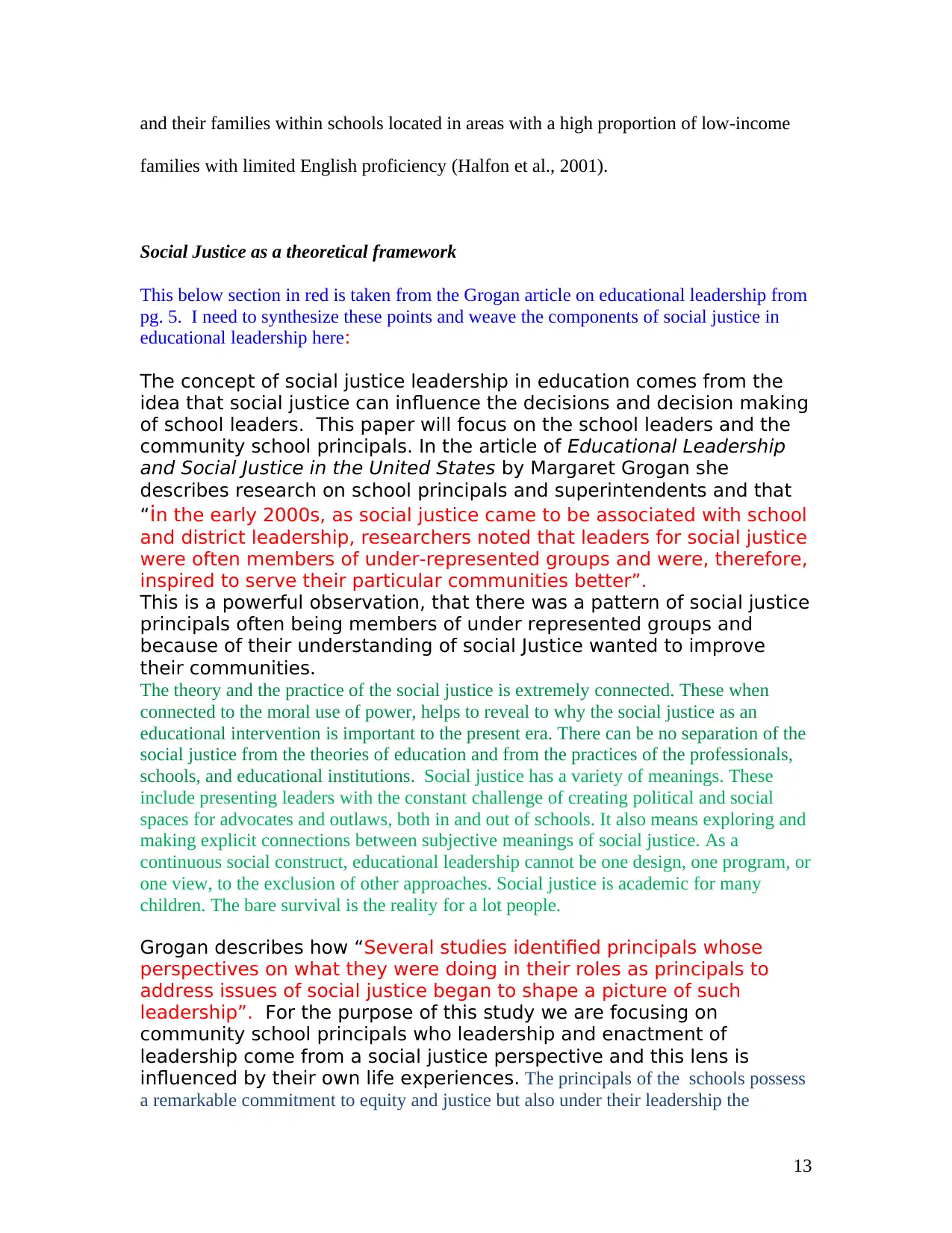
and their families within schools located in areas with a high proportion of low-income
families with limited English proficiency (Halfon et al., 2001).
Social Justice as a theoretical framework
This below section in red is taken from the Grogan article on educational leadership from
pg. 5. I need to synthesize these points and weave the components of social justice in
educational leadership here:
The concept of social justice leadership in education comes from the
idea that social justice can influence the decisions and decision making
of school leaders. This paper will focus on the school leaders and the
community school principals. In the article of Educational Leadership
and Social Justice in the United States by Margaret Grogan she
describes research on school principals and superintendents and that
“in the early 2000s, as social justice came to be associated with school
and district leadership, researchers noted that leaders for social justice
were often members of under-represented groups and were, therefore,
inspired to serve their particular communities better”.
This is a powerful observation, that there was a pattern of social justice
principals often being members of under represented groups and
because of their understanding of social Justice wanted to improve
their communities.
The theory and the practice of the social justice is extremely connected. These when
connected to the moral use of power, helps to reveal to why the social justice as an
educational intervention is important to the present era. There can be no separation of the
social justice from the theories of education and from the practices of the professionals,
schools, and educational institutions. Social justice has a variety of meanings. These
include presenting leaders with the constant challenge of creating political and social
spaces for advocates and outlaws, both in and out of schools. It also means exploring and
making explicit connections between subjective meanings of social justice. As a
continuous social construct, educational leadership cannot be one design, one program, or
one view, to the exclusion of other approaches. Social justice is academic for many
children. The bare survival is the reality for a lot people.
Grogan describes how “Several studies identified principals whose
perspectives on what they were doing in their roles as principals to
address issues of social justice began to shape a picture of such
leadership”. For the purpose of this study we are focusing on
community school principals who leadership and enactment of
leadership come from a social justice perspective and this lens is
influenced by their own life experiences. The principals of the schools possess
a remarkable commitment to equity and justice but also under their leadership the
13
families with limited English proficiency (Halfon et al., 2001).
Social Justice as a theoretical framework
This below section in red is taken from the Grogan article on educational leadership from
pg. 5. I need to synthesize these points and weave the components of social justice in
educational leadership here:
The concept of social justice leadership in education comes from the
idea that social justice can influence the decisions and decision making
of school leaders. This paper will focus on the school leaders and the
community school principals. In the article of Educational Leadership
and Social Justice in the United States by Margaret Grogan she
describes research on school principals and superintendents and that
“in the early 2000s, as social justice came to be associated with school
and district leadership, researchers noted that leaders for social justice
were often members of under-represented groups and were, therefore,
inspired to serve their particular communities better”.
This is a powerful observation, that there was a pattern of social justice
principals often being members of under represented groups and
because of their understanding of social Justice wanted to improve
their communities.
The theory and the practice of the social justice is extremely connected. These when
connected to the moral use of power, helps to reveal to why the social justice as an
educational intervention is important to the present era. There can be no separation of the
social justice from the theories of education and from the practices of the professionals,
schools, and educational institutions. Social justice has a variety of meanings. These
include presenting leaders with the constant challenge of creating political and social
spaces for advocates and outlaws, both in and out of schools. It also means exploring and
making explicit connections between subjective meanings of social justice. As a
continuous social construct, educational leadership cannot be one design, one program, or
one view, to the exclusion of other approaches. Social justice is academic for many
children. The bare survival is the reality for a lot people.
Grogan describes how “Several studies identified principals whose
perspectives on what they were doing in their roles as principals to
address issues of social justice began to shape a picture of such
leadership”. For the purpose of this study we are focusing on
community school principals who leadership and enactment of
leadership come from a social justice perspective and this lens is
influenced by their own life experiences. The principals of the schools possess
a remarkable commitment to equity and justice but also under their leadership the
13
Paraphrase This Document
Need a fresh take? Get an instant paraphrase of this document with our AI Paraphraser
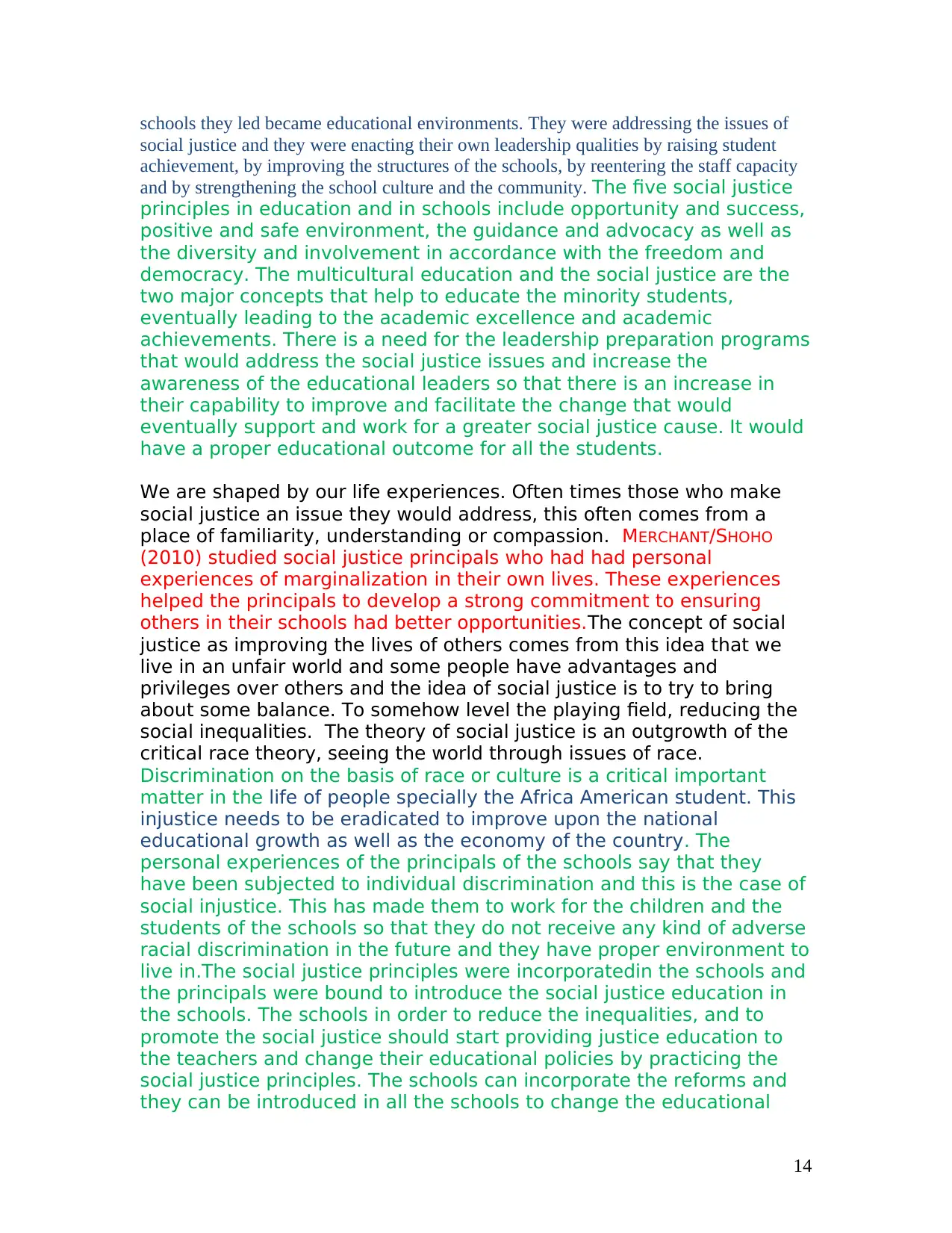
schools they led became educational environments. They were addressing the issues of
social justice and they were enacting their own leadership qualities by raising student
achievement, by improving the structures of the schools, by reentering the staff capacity
and by strengthening the school culture and the community. The five social justice
principles in education and in schools include opportunity and success,
positive and safe environment, the guidance and advocacy as well as
the diversity and involvement in accordance with the freedom and
democracy. The multicultural education and the social justice are the
two major concepts that help to educate the minority students,
eventually leading to the academic excellence and academic
achievements. There is a need for the leadership preparation programs
that would address the social justice issues and increase the
awareness of the educational leaders so that there is an increase in
their capability to improve and facilitate the change that would
eventually support and work for a greater social justice cause. It would
have a proper educational outcome for all the students.
We are shaped by our life experiences. Often times those who make
social justice an issue they would address, this often comes from a
place of familiarity, understanding or compassion. MERCHANT/SHOHO
(2010) studied social justice principals who had had personal
experiences of marginalization in their own lives. These experiences
helped the principals to develop a strong commitment to ensuring
others in their schools had better opportunities.The concept of social
justice as improving the lives of others comes from this idea that we
live in an unfair world and some people have advantages and
privileges over others and the idea of social justice is to try to bring
about some balance. To somehow level the playing field, reducing the
social inequalities. The theory of social justice is an outgrowth of the
critical race theory, seeing the world through issues of race.
Discrimination on the basis of race or culture is a critical important
matter in the life of people specially the Africa American student. This
injustice needs to be eradicated to improve upon the national
educational growth as well as the economy of the country. The
personal experiences of the principals of the schools say that they
have been subjected to individual discrimination and this is the case of
social injustice. This has made them to work for the children and the
students of the schools so that they do not receive any kind of adverse
racial discrimination in the future and they have proper environment to
live in.The social justice principles were incorporatedin the schools and
the principals were bound to introduce the social justice education in
the schools. The schools in order to reduce the inequalities, and to
promote the social justice should start providing justice education to
the teachers and change their educational policies by practicing the
social justice principles. The schools can incorporate the reforms and
they can be introduced in all the schools to change the educational
14
social justice and they were enacting their own leadership qualities by raising student
achievement, by improving the structures of the schools, by reentering the staff capacity
and by strengthening the school culture and the community. The five social justice
principles in education and in schools include opportunity and success,
positive and safe environment, the guidance and advocacy as well as
the diversity and involvement in accordance with the freedom and
democracy. The multicultural education and the social justice are the
two major concepts that help to educate the minority students,
eventually leading to the academic excellence and academic
achievements. There is a need for the leadership preparation programs
that would address the social justice issues and increase the
awareness of the educational leaders so that there is an increase in
their capability to improve and facilitate the change that would
eventually support and work for a greater social justice cause. It would
have a proper educational outcome for all the students.
We are shaped by our life experiences. Often times those who make
social justice an issue they would address, this often comes from a
place of familiarity, understanding or compassion. MERCHANT/SHOHO
(2010) studied social justice principals who had had personal
experiences of marginalization in their own lives. These experiences
helped the principals to develop a strong commitment to ensuring
others in their schools had better opportunities.The concept of social
justice as improving the lives of others comes from this idea that we
live in an unfair world and some people have advantages and
privileges over others and the idea of social justice is to try to bring
about some balance. To somehow level the playing field, reducing the
social inequalities. The theory of social justice is an outgrowth of the
critical race theory, seeing the world through issues of race.
Discrimination on the basis of race or culture is a critical important
matter in the life of people specially the Africa American student. This
injustice needs to be eradicated to improve upon the national
educational growth as well as the economy of the country. The
personal experiences of the principals of the schools say that they
have been subjected to individual discrimination and this is the case of
social injustice. This has made them to work for the children and the
students of the schools so that they do not receive any kind of adverse
racial discrimination in the future and they have proper environment to
live in.The social justice principles were incorporatedin the schools and
the principals were bound to introduce the social justice education in
the schools. The schools in order to reduce the inequalities, and to
promote the social justice should start providing justice education to
the teachers and change their educational policies by practicing the
social justice principles. The schools can incorporate the reforms and
they can be introduced in all the schools to change the educational
14
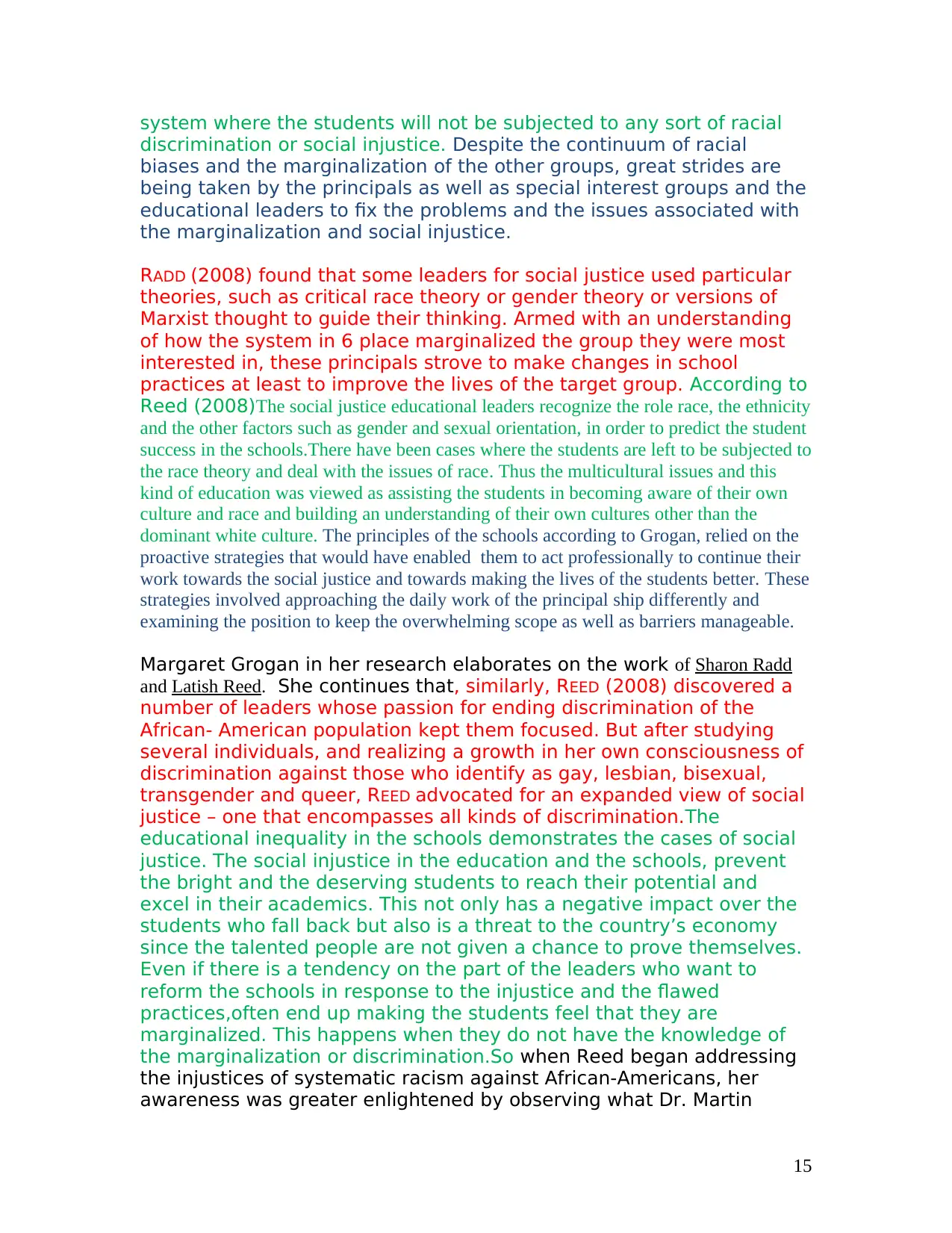
system where the students will not be subjected to any sort of racial
discrimination or social injustice. Despite the continuum of racial
biases and the marginalization of the other groups, great strides are
being taken by the principals as well as special interest groups and the
educational leaders to fix the problems and the issues associated with
the marginalization and social injustice.
RADD (2008) found that some leaders for social justice used particular
theories, such as critical race theory or gender theory or versions of
Marxist thought to guide their thinking. Armed with an understanding
of how the system in 6 place marginalized the group they were most
interested in, these principals strove to make changes in school
practices at least to improve the lives of the target group. According to
Reed (2008)The social justice educational leaders recognize the role race, the ethnicity
and the other factors such as gender and sexual orientation, in order to predict the student
success in the schools.There have been cases where the students are left to be subjected to
the race theory and deal with the issues of race. Thus the multicultural issues and this
kind of education was viewed as assisting the students in becoming aware of their own
culture and race and building an understanding of their own cultures other than the
dominant white culture. The principles of the schools according to Grogan, relied on the
proactive strategies that would have enabled them to act professionally to continue their
work towards the social justice and towards making the lives of the students better. These
strategies involved approaching the daily work of the principal ship differently and
examining the position to keep the overwhelming scope as well as barriers manageable.
Margaret Grogan in her research elaborates on the work of Sharon Radd
and Latish Reed. She continues that, similarly, REED (2008) discovered a
number of leaders whose passion for ending discrimination of the
African- American population kept them focused. But after studying
several individuals, and realizing a growth in her own consciousness of
discrimination against those who identify as gay, lesbian, bisexual,
transgender and queer, REED advocated for an expanded view of social
justice – one that encompasses all kinds of discrimination.The
educational inequality in the schools demonstrates the cases of social
justice. The social injustice in the education and the schools, prevent
the bright and the deserving students to reach their potential and
excel in their academics. This not only has a negative impact over the
students who fall back but also is a threat to the country’s economy
since the talented people are not given a chance to prove themselves.
Even if there is a tendency on the part of the leaders who want to
reform the schools in response to the injustice and the flawed
practices,often end up making the students feel that they are
marginalized. This happens when they do not have the knowledge of
the marginalization or discrimination.So when Reed began addressing
the injustices of systematic racism against African-Americans, her
awareness was greater enlightened by observing what Dr. Martin
15
discrimination or social injustice. Despite the continuum of racial
biases and the marginalization of the other groups, great strides are
being taken by the principals as well as special interest groups and the
educational leaders to fix the problems and the issues associated with
the marginalization and social injustice.
RADD (2008) found that some leaders for social justice used particular
theories, such as critical race theory or gender theory or versions of
Marxist thought to guide their thinking. Armed with an understanding
of how the system in 6 place marginalized the group they were most
interested in, these principals strove to make changes in school
practices at least to improve the lives of the target group. According to
Reed (2008)The social justice educational leaders recognize the role race, the ethnicity
and the other factors such as gender and sexual orientation, in order to predict the student
success in the schools.There have been cases where the students are left to be subjected to
the race theory and deal with the issues of race. Thus the multicultural issues and this
kind of education was viewed as assisting the students in becoming aware of their own
culture and race and building an understanding of their own cultures other than the
dominant white culture. The principles of the schools according to Grogan, relied on the
proactive strategies that would have enabled them to act professionally to continue their
work towards the social justice and towards making the lives of the students better. These
strategies involved approaching the daily work of the principal ship differently and
examining the position to keep the overwhelming scope as well as barriers manageable.
Margaret Grogan in her research elaborates on the work of Sharon Radd
and Latish Reed. She continues that, similarly, REED (2008) discovered a
number of leaders whose passion for ending discrimination of the
African- American population kept them focused. But after studying
several individuals, and realizing a growth in her own consciousness of
discrimination against those who identify as gay, lesbian, bisexual,
transgender and queer, REED advocated for an expanded view of social
justice – one that encompasses all kinds of discrimination.The
educational inequality in the schools demonstrates the cases of social
justice. The social injustice in the education and the schools, prevent
the bright and the deserving students to reach their potential and
excel in their academics. This not only has a negative impact over the
students who fall back but also is a threat to the country’s economy
since the talented people are not given a chance to prove themselves.
Even if there is a tendency on the part of the leaders who want to
reform the schools in response to the injustice and the flawed
practices,often end up making the students feel that they are
marginalized. This happens when they do not have the knowledge of
the marginalization or discrimination.So when Reed began addressing
the injustices of systematic racism against African-Americans, her
awareness was greater enlightened by observing what Dr. Martin
15
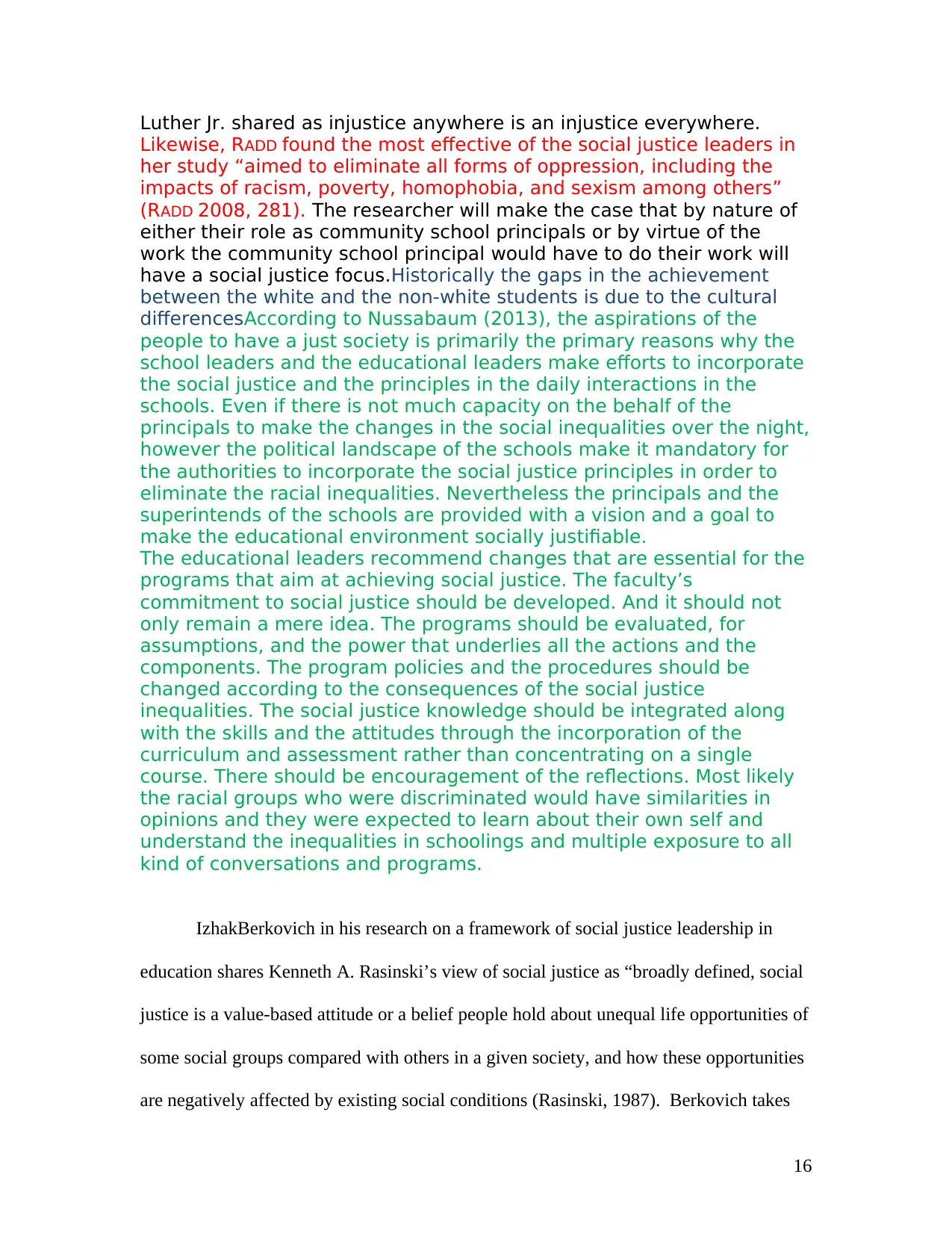
Luther Jr. shared as injustice anywhere is an injustice everywhere.
Likewise, RADD found the most effective of the social justice leaders in
her study “aimed to eliminate all forms of oppression, including the
impacts of racism, poverty, homophobia, and sexism among others”
(RADD 2008, 281). The researcher will make the case that by nature of
either their role as community school principals or by virtue of the
work the community school principal would have to do their work will
have a social justice focus.Historically the gaps in the achievement
between the white and the non-white students is due to the cultural
differencesAccording to Nussabaum (2013), the aspirations of the
people to have a just society is primarily the primary reasons why the
school leaders and the educational leaders make efforts to incorporate
the social justice and the principles in the daily interactions in the
schools. Even if there is not much capacity on the behalf of the
principals to make the changes in the social inequalities over the night,
however the political landscape of the schools make it mandatory for
the authorities to incorporate the social justice principles in order to
eliminate the racial inequalities. Nevertheless the principals and the
superintends of the schools are provided with a vision and a goal to
make the educational environment socially justifiable.
The educational leaders recommend changes that are essential for the
programs that aim at achieving social justice. The faculty’s
commitment to social justice should be developed. And it should not
only remain a mere idea. The programs should be evaluated, for
assumptions, and the power that underlies all the actions and the
components. The program policies and the procedures should be
changed according to the consequences of the social justice
inequalities. The social justice knowledge should be integrated along
with the skills and the attitudes through the incorporation of the
curriculum and assessment rather than concentrating on a single
course. There should be encouragement of the reflections. Most likely
the racial groups who were discriminated would have similarities in
opinions and they were expected to learn about their own self and
understand the inequalities in schoolings and multiple exposure to all
kind of conversations and programs.
IzhakBerkovich in his research on a framework of social justice leadership in
education shares Kenneth A. Rasinski’s view of social justice as “broadly defined, social
justice is a value-based attitude or a belief people hold about unequal life opportunities of
some social groups compared with others in a given society, and how these opportunities
are negatively affected by existing social conditions (Rasinski, 1987). Berkovich takes
16
Likewise, RADD found the most effective of the social justice leaders in
her study “aimed to eliminate all forms of oppression, including the
impacts of racism, poverty, homophobia, and sexism among others”
(RADD 2008, 281). The researcher will make the case that by nature of
either their role as community school principals or by virtue of the
work the community school principal would have to do their work will
have a social justice focus.Historically the gaps in the achievement
between the white and the non-white students is due to the cultural
differencesAccording to Nussabaum (2013), the aspirations of the
people to have a just society is primarily the primary reasons why the
school leaders and the educational leaders make efforts to incorporate
the social justice and the principles in the daily interactions in the
schools. Even if there is not much capacity on the behalf of the
principals to make the changes in the social inequalities over the night,
however the political landscape of the schools make it mandatory for
the authorities to incorporate the social justice principles in order to
eliminate the racial inequalities. Nevertheless the principals and the
superintends of the schools are provided with a vision and a goal to
make the educational environment socially justifiable.
The educational leaders recommend changes that are essential for the
programs that aim at achieving social justice. The faculty’s
commitment to social justice should be developed. And it should not
only remain a mere idea. The programs should be evaluated, for
assumptions, and the power that underlies all the actions and the
components. The program policies and the procedures should be
changed according to the consequences of the social justice
inequalities. The social justice knowledge should be integrated along
with the skills and the attitudes through the incorporation of the
curriculum and assessment rather than concentrating on a single
course. There should be encouragement of the reflections. Most likely
the racial groups who were discriminated would have similarities in
opinions and they were expected to learn about their own self and
understand the inequalities in schoolings and multiple exposure to all
kind of conversations and programs.
IzhakBerkovich in his research on a framework of social justice leadership in
education shares Kenneth A. Rasinski’s view of social justice as “broadly defined, social
justice is a value-based attitude or a belief people hold about unequal life opportunities of
some social groups compared with others in a given society, and how these opportunities
are negatively affected by existing social conditions (Rasinski, 1987). Berkovich takes
16
Secure Best Marks with AI Grader
Need help grading? Try our AI Grader for instant feedback on your assignments.
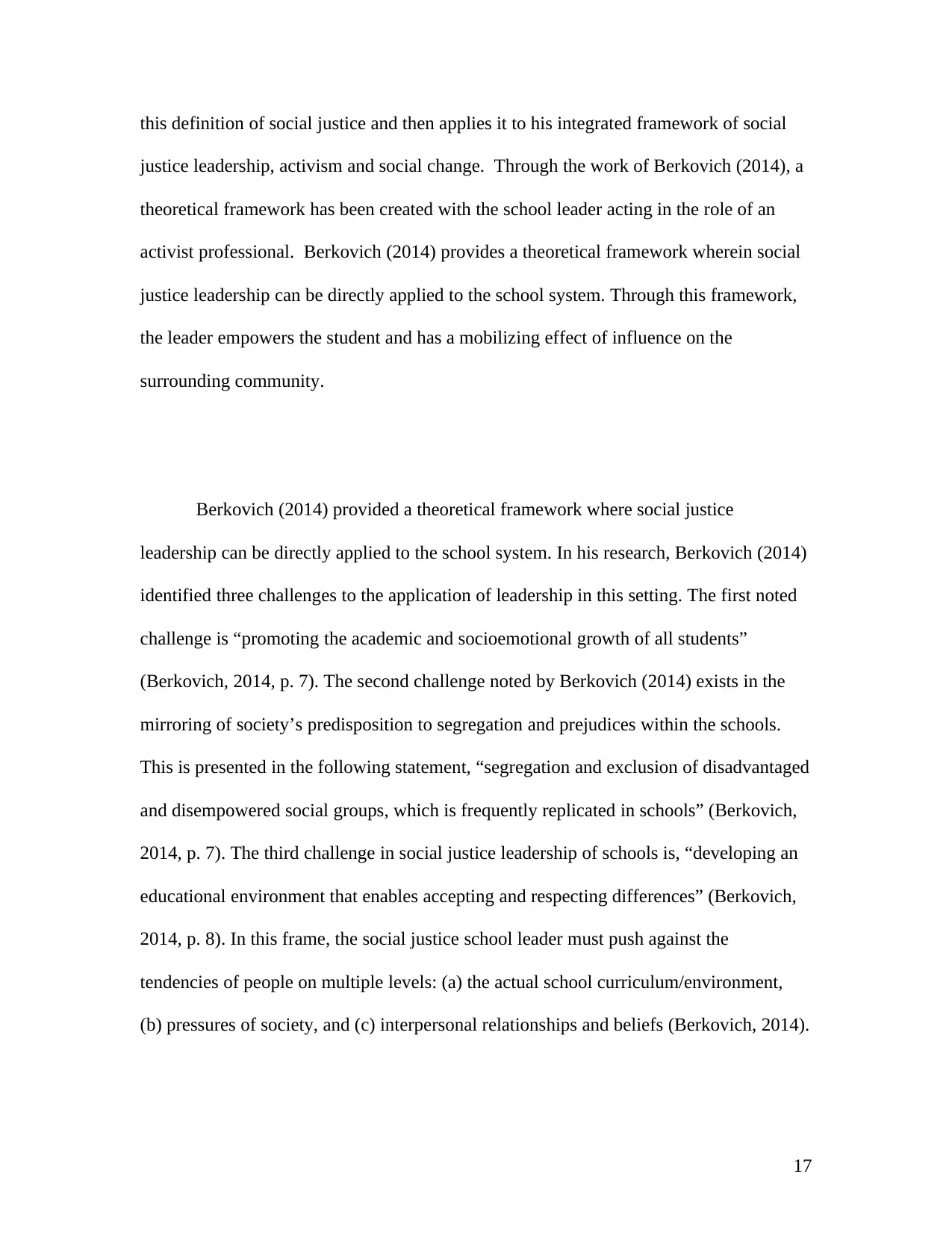
this definition of social justice and then applies it to his integrated framework of social
justice leadership, activism and social change. Through the work of Berkovich (2014), a
theoretical framework has been created with the school leader acting in the role of an
activist professional. Berkovich (2014) provides a theoretical framework wherein social
justice leadership can be directly applied to the school system. Through this framework,
the leader empowers the student and has a mobilizing effect of influence on the
surrounding community.
Berkovich (2014) provided a theoretical framework where social justice
leadership can be directly applied to the school system. In his research, Berkovich (2014)
identified three challenges to the application of leadership in this setting. The first noted
challenge is “promoting the academic and socioemotional growth of all students”
(Berkovich, 2014, p. 7). The second challenge noted by Berkovich (2014) exists in the
mirroring of society’s predisposition to segregation and prejudices within the schools.
This is presented in the following statement, “segregation and exclusion of disadvantaged
and disempowered social groups, which is frequently replicated in schools” (Berkovich,
2014, p. 7). The third challenge in social justice leadership of schools is, “developing an
educational environment that enables accepting and respecting differences” (Berkovich,
2014, p. 8). In this frame, the social justice school leader must push against the
tendencies of people on multiple levels: (a) the actual school curriculum/environment,
(b) pressures of society, and (c) interpersonal relationships and beliefs (Berkovich, 2014).
17
justice leadership, activism and social change. Through the work of Berkovich (2014), a
theoretical framework has been created with the school leader acting in the role of an
activist professional. Berkovich (2014) provides a theoretical framework wherein social
justice leadership can be directly applied to the school system. Through this framework,
the leader empowers the student and has a mobilizing effect of influence on the
surrounding community.
Berkovich (2014) provided a theoretical framework where social justice
leadership can be directly applied to the school system. In his research, Berkovich (2014)
identified three challenges to the application of leadership in this setting. The first noted
challenge is “promoting the academic and socioemotional growth of all students”
(Berkovich, 2014, p. 7). The second challenge noted by Berkovich (2014) exists in the
mirroring of society’s predisposition to segregation and prejudices within the schools.
This is presented in the following statement, “segregation and exclusion of disadvantaged
and disempowered social groups, which is frequently replicated in schools” (Berkovich,
2014, p. 7). The third challenge in social justice leadership of schools is, “developing an
educational environment that enables accepting and respecting differences” (Berkovich,
2014, p. 8). In this frame, the social justice school leader must push against the
tendencies of people on multiple levels: (a) the actual school curriculum/environment,
(b) pressures of society, and (c) interpersonal relationships and beliefs (Berkovich, 2014).
17
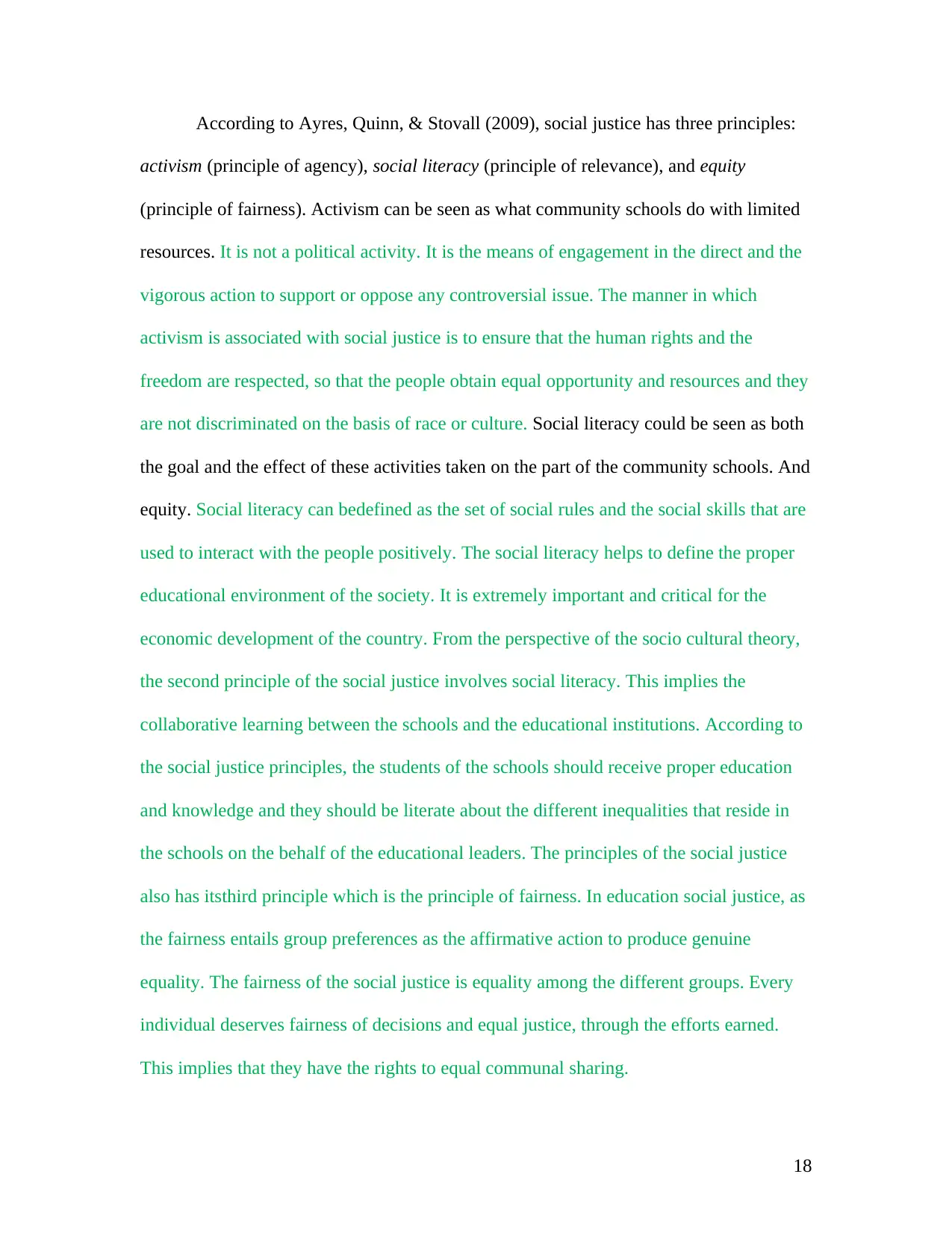
According to Ayres, Quinn, & Stovall (2009), social justice has three principles:
activism (principle of agency), social literacy (principle of relevance), and equity
(principle of fairness). Activism can be seen as what community schools do with limited
resources. It is not a political activity. It is the means of engagement in the direct and the
vigorous action to support or oppose any controversial issue. The manner in which
activism is associated with social justice is to ensure that the human rights and the
freedom are respected, so that the people obtain equal opportunity and resources and they
are not discriminated on the basis of race or culture. Social literacy could be seen as both
the goal and the effect of these activities taken on the part of the community schools. And
equity. Social literacy can bedefined as the set of social rules and the social skills that are
used to interact with the people positively. The social literacy helps to define the proper
educational environment of the society. It is extremely important and critical for the
economic development of the country. From the perspective of the socio cultural theory,
the second principle of the social justice involves social literacy. This implies the
collaborative learning between the schools and the educational institutions. According to
the social justice principles, the students of the schools should receive proper education
and knowledge and they should be literate about the different inequalities that reside in
the schools on the behalf of the educational leaders. The principles of the social justice
also has itsthird principle which is the principle of fairness. In education social justice, as
the fairness entails group preferences as the affirmative action to produce genuine
equality. The fairness of the social justice is equality among the different groups. Every
individual deserves fairness of decisions and equal justice, through the efforts earned.
This implies that they have the rights to equal communal sharing.
18
activism (principle of agency), social literacy (principle of relevance), and equity
(principle of fairness). Activism can be seen as what community schools do with limited
resources. It is not a political activity. It is the means of engagement in the direct and the
vigorous action to support or oppose any controversial issue. The manner in which
activism is associated with social justice is to ensure that the human rights and the
freedom are respected, so that the people obtain equal opportunity and resources and they
are not discriminated on the basis of race or culture. Social literacy could be seen as both
the goal and the effect of these activities taken on the part of the community schools. And
equity. Social literacy can bedefined as the set of social rules and the social skills that are
used to interact with the people positively. The social literacy helps to define the proper
educational environment of the society. It is extremely important and critical for the
economic development of the country. From the perspective of the socio cultural theory,
the second principle of the social justice involves social literacy. This implies the
collaborative learning between the schools and the educational institutions. According to
the social justice principles, the students of the schools should receive proper education
and knowledge and they should be literate about the different inequalities that reside in
the schools on the behalf of the educational leaders. The principles of the social justice
also has itsthird principle which is the principle of fairness. In education social justice, as
the fairness entails group preferences as the affirmative action to produce genuine
equality. The fairness of the social justice is equality among the different groups. Every
individual deserves fairness of decisions and equal justice, through the efforts earned.
This implies that they have the rights to equal communal sharing.
18
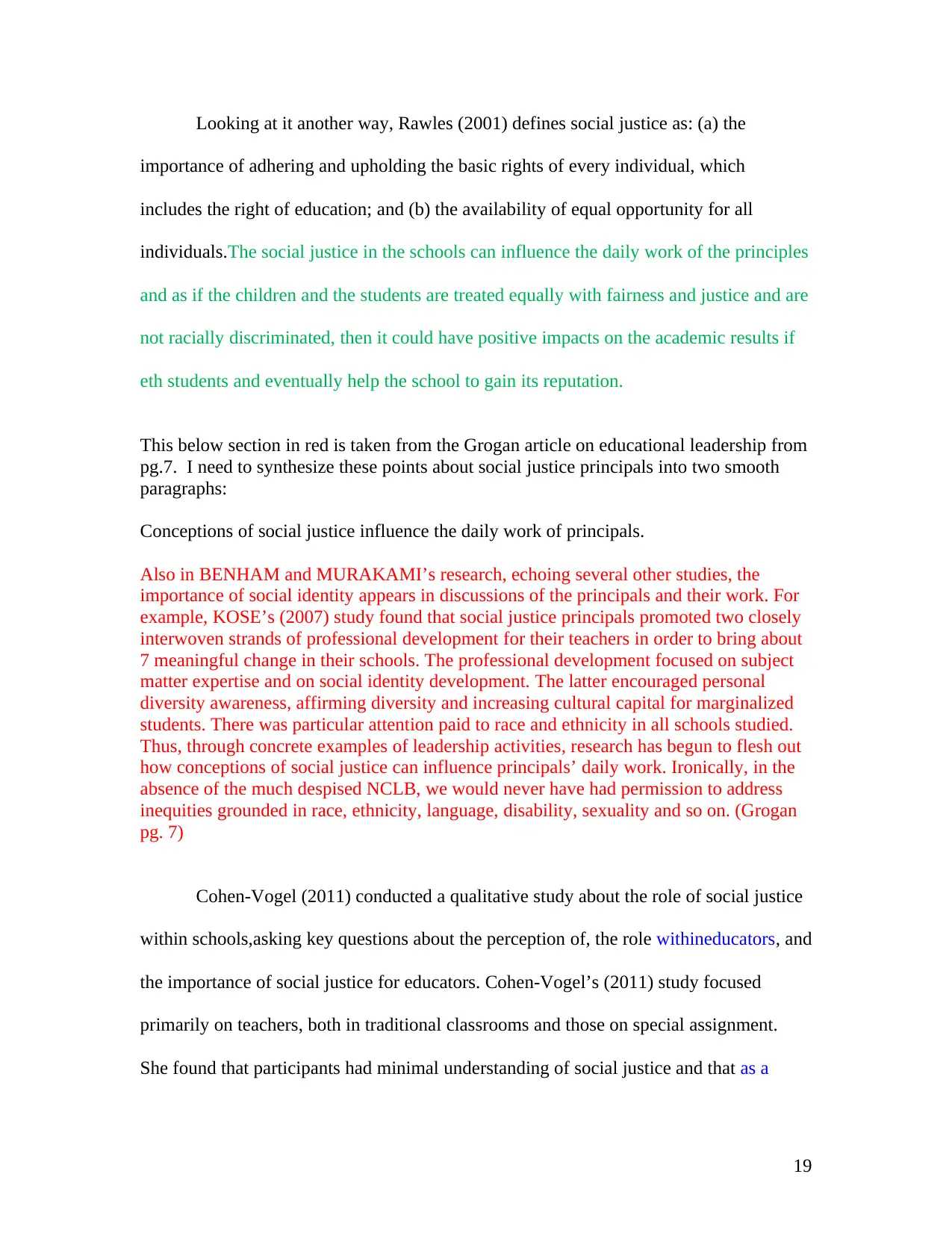
Looking at it another way, Rawles (2001) defines social justice as: (a) the
importance of adhering and upholding the basic rights of every individual, which
includes the right of education; and (b) the availability of equal opportunity for all
individuals.The social justice in the schools can influence the daily work of the principles
and as if the children and the students are treated equally with fairness and justice and are
not racially discriminated, then it could have positive impacts on the academic results if
eth students and eventually help the school to gain its reputation.
This below section in red is taken from the Grogan article on educational leadership from
pg.7. I need to synthesize these points about social justice principals into two smooth
paragraphs:
Conceptions of social justice influence the daily work of principals.
Also in BENHAM and MURAKAMI’s research, echoing several other studies, the
importance of social identity appears in discussions of the principals and their work. For
example, KOSE’s (2007) study found that social justice principals promoted two closely
interwoven strands of professional development for their teachers in order to bring about
7 meaningful change in their schools. The professional development focused on subject
matter expertise and on social identity development. The latter encouraged personal
diversity awareness, affirming diversity and increasing cultural capital for marginalized
students. There was particular attention paid to race and ethnicity in all schools studied.
Thus, through concrete examples of leadership activities, research has begun to flesh out
how conceptions of social justice can influence principals’ daily work. Ironically, in the
absence of the much despised NCLB, we would never have had permission to address
inequities grounded in race, ethnicity, language, disability, sexuality and so on. (Grogan
pg. 7)
Cohen-Vogel (2011) conducted a qualitative study about the role of social justice
within schools,asking key questions about the perception of, the role withineducators, and
the importance of social justice for educators. Cohen-Vogel’s (2011) study focused
primarily on teachers, both in traditional classrooms and those on special assignment.
She found that participants had minimal understanding of social justice and that as a
19
importance of adhering and upholding the basic rights of every individual, which
includes the right of education; and (b) the availability of equal opportunity for all
individuals.The social justice in the schools can influence the daily work of the principles
and as if the children and the students are treated equally with fairness and justice and are
not racially discriminated, then it could have positive impacts on the academic results if
eth students and eventually help the school to gain its reputation.
This below section in red is taken from the Grogan article on educational leadership from
pg.7. I need to synthesize these points about social justice principals into two smooth
paragraphs:
Conceptions of social justice influence the daily work of principals.
Also in BENHAM and MURAKAMI’s research, echoing several other studies, the
importance of social identity appears in discussions of the principals and their work. For
example, KOSE’s (2007) study found that social justice principals promoted two closely
interwoven strands of professional development for their teachers in order to bring about
7 meaningful change in their schools. The professional development focused on subject
matter expertise and on social identity development. The latter encouraged personal
diversity awareness, affirming diversity and increasing cultural capital for marginalized
students. There was particular attention paid to race and ethnicity in all schools studied.
Thus, through concrete examples of leadership activities, research has begun to flesh out
how conceptions of social justice can influence principals’ daily work. Ironically, in the
absence of the much despised NCLB, we would never have had permission to address
inequities grounded in race, ethnicity, language, disability, sexuality and so on. (Grogan
pg. 7)
Cohen-Vogel (2011) conducted a qualitative study about the role of social justice
within schools,asking key questions about the perception of, the role withineducators, and
the importance of social justice for educators. Cohen-Vogel’s (2011) study focused
primarily on teachers, both in traditional classrooms and those on special assignment.
She found that participants had minimal understanding of social justice and that as a
19
Paraphrase This Document
Need a fresh take? Get an instant paraphrase of this document with our AI Paraphraser
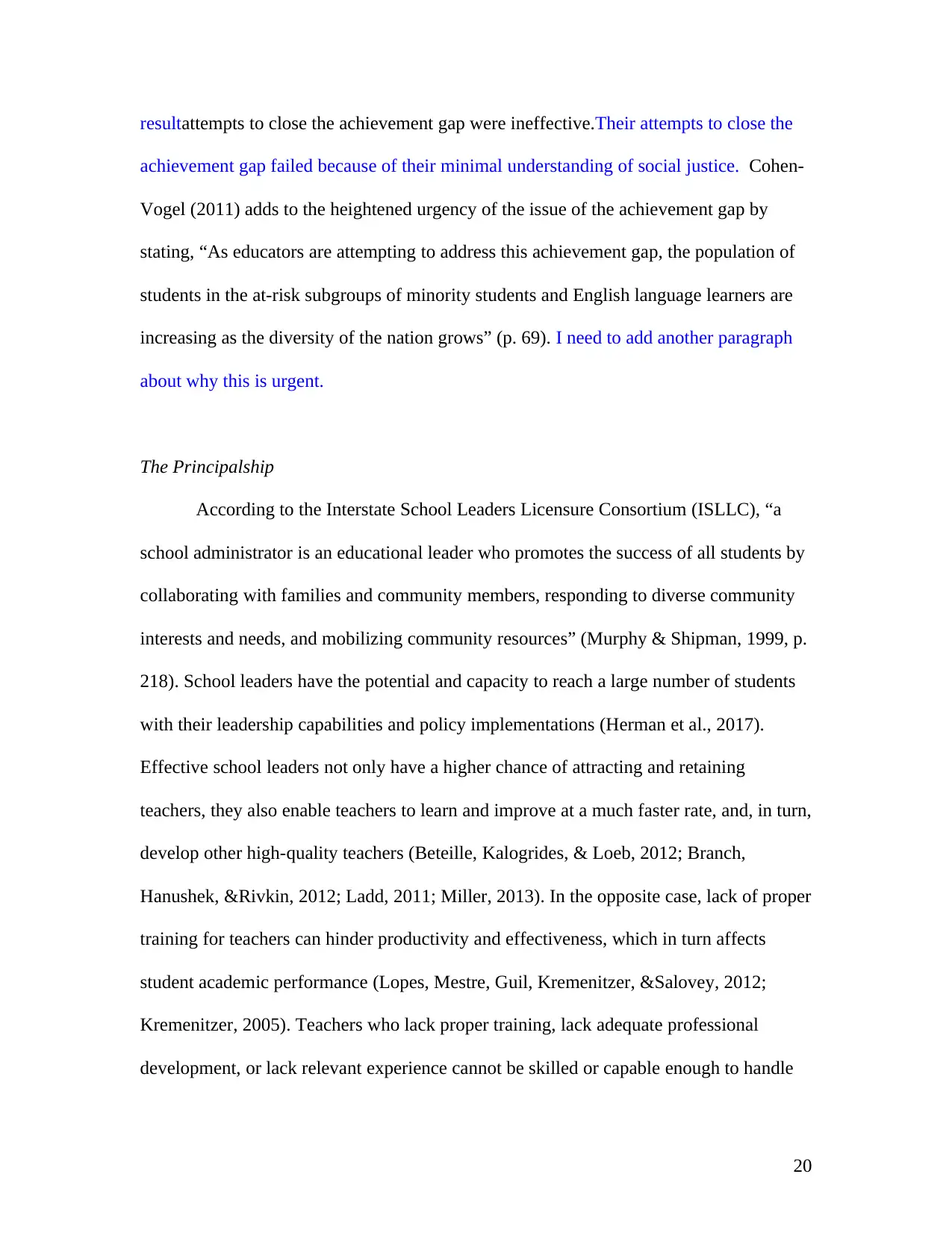
resultattempts to close the achievement gap were ineffective.Their attempts to close the
achievement gap failed because of their minimal understanding of social justice. Cohen-
Vogel (2011) adds to the heightened urgency of the issue of the achievement gap by
stating, “As educators are attempting to address this achievement gap, the population of
students in the at-risk subgroups of minority students and English language learners are
increasing as the diversity of the nation grows” (p. 69). I need to add another paragraph
about why this is urgent.
The Principalship
According to the Interstate School Leaders Licensure Consortium (ISLLC), “a
school administrator is an educational leader who promotes the success of all students by
collaborating with families and community members, responding to diverse community
interests and needs, and mobilizing community resources” (Murphy & Shipman, 1999, p.
218). School leaders have the potential and capacity to reach a large number of students
with their leadership capabilities and policy implementations (Herman et al., 2017).
Effective school leaders not only have a higher chance of attracting and retaining
teachers, they also enable teachers to learn and improve at a much faster rate, and, in turn,
develop other high-quality teachers (Beteille, Kalogrides, & Loeb, 2012; Branch,
Hanushek, &Rivkin, 2012; Ladd, 2011; Miller, 2013). In the opposite case, lack of proper
training for teachers can hinder productivity and effectiveness, which in turn affects
student academic performance (Lopes, Mestre, Guil, Kremenitzer, &Salovey, 2012;
Kremenitzer, 2005). Teachers who lack proper training, lack adequate professional
development, or lack relevant experience cannot be skilled or capable enough to handle
20
achievement gap failed because of their minimal understanding of social justice. Cohen-
Vogel (2011) adds to the heightened urgency of the issue of the achievement gap by
stating, “As educators are attempting to address this achievement gap, the population of
students in the at-risk subgroups of minority students and English language learners are
increasing as the diversity of the nation grows” (p. 69). I need to add another paragraph
about why this is urgent.
The Principalship
According to the Interstate School Leaders Licensure Consortium (ISLLC), “a
school administrator is an educational leader who promotes the success of all students by
collaborating with families and community members, responding to diverse community
interests and needs, and mobilizing community resources” (Murphy & Shipman, 1999, p.
218). School leaders have the potential and capacity to reach a large number of students
with their leadership capabilities and policy implementations (Herman et al., 2017).
Effective school leaders not only have a higher chance of attracting and retaining
teachers, they also enable teachers to learn and improve at a much faster rate, and, in turn,
develop other high-quality teachers (Beteille, Kalogrides, & Loeb, 2012; Branch,
Hanushek, &Rivkin, 2012; Ladd, 2011; Miller, 2013). In the opposite case, lack of proper
training for teachers can hinder productivity and effectiveness, which in turn affects
student academic performance (Lopes, Mestre, Guil, Kremenitzer, &Salovey, 2012;
Kremenitzer, 2005). Teachers who lack proper training, lack adequate professional
development, or lack relevant experience cannot be skilled or capable enough to handle
20
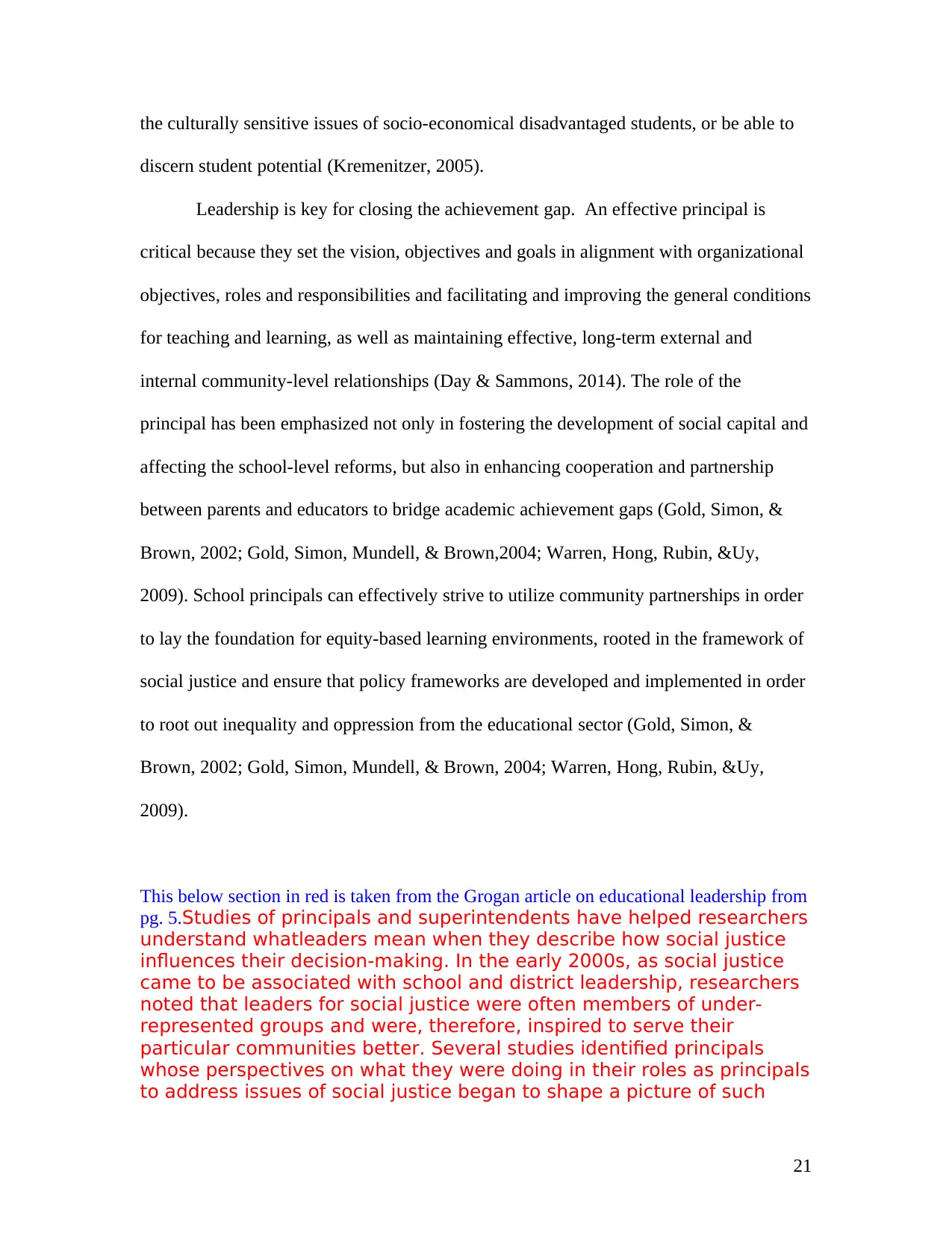
the culturally sensitive issues of socio-economical disadvantaged students, or be able to
discern student potential (Kremenitzer, 2005).
Leadership is key for closing the achievement gap. An effective principal is
critical because they set the vision, objectives and goals in alignment with organizational
objectives, roles and responsibilities and facilitating and improving the general conditions
for teaching and learning, as well as maintaining effective, long-term external and
internal community-level relationships (Day & Sammons, 2014). The role of the
principal has been emphasized not only in fostering the development of social capital and
affecting the school-level reforms, but also in enhancing cooperation and partnership
between parents and educators to bridge academic achievement gaps (Gold, Simon, &
Brown, 2002; Gold, Simon, Mundell, & Brown,2004; Warren, Hong, Rubin, &Uy,
2009). School principals can effectively strive to utilize community partnerships in order
to lay the foundation for equity-based learning environments, rooted in the framework of
social justice and ensure that policy frameworks are developed and implemented in order
to root out inequality and oppression from the educational sector (Gold, Simon, &
Brown, 2002; Gold, Simon, Mundell, & Brown, 2004; Warren, Hong, Rubin, &Uy,
2009).
This below section in red is taken from the Grogan article on educational leadership from
pg. 5.Studies of principals and superintendents have helped researchers
understand whatleaders mean when they describe how social justice
influences their decision-making. In the early 2000s, as social justice
came to be associated with school and district leadership, researchers
noted that leaders for social justice were often members of under-
represented groups and were, therefore, inspired to serve their
particular communities better. Several studies identified principals
whose perspectives on what they were doing in their roles as principals
to address issues of social justice began to shape a picture of such
21
discern student potential (Kremenitzer, 2005).
Leadership is key for closing the achievement gap. An effective principal is
critical because they set the vision, objectives and goals in alignment with organizational
objectives, roles and responsibilities and facilitating and improving the general conditions
for teaching and learning, as well as maintaining effective, long-term external and
internal community-level relationships (Day & Sammons, 2014). The role of the
principal has been emphasized not only in fostering the development of social capital and
affecting the school-level reforms, but also in enhancing cooperation and partnership
between parents and educators to bridge academic achievement gaps (Gold, Simon, &
Brown, 2002; Gold, Simon, Mundell, & Brown,2004; Warren, Hong, Rubin, &Uy,
2009). School principals can effectively strive to utilize community partnerships in order
to lay the foundation for equity-based learning environments, rooted in the framework of
social justice and ensure that policy frameworks are developed and implemented in order
to root out inequality and oppression from the educational sector (Gold, Simon, &
Brown, 2002; Gold, Simon, Mundell, & Brown, 2004; Warren, Hong, Rubin, &Uy,
2009).
This below section in red is taken from the Grogan article on educational leadership from
pg. 5.Studies of principals and superintendents have helped researchers
understand whatleaders mean when they describe how social justice
influences their decision-making. In the early 2000s, as social justice
came to be associated with school and district leadership, researchers
noted that leaders for social justice were often members of under-
represented groups and were, therefore, inspired to serve their
particular communities better. Several studies identified principals
whose perspectives on what they were doing in their roles as principals
to address issues of social justice began to shape a picture of such
21
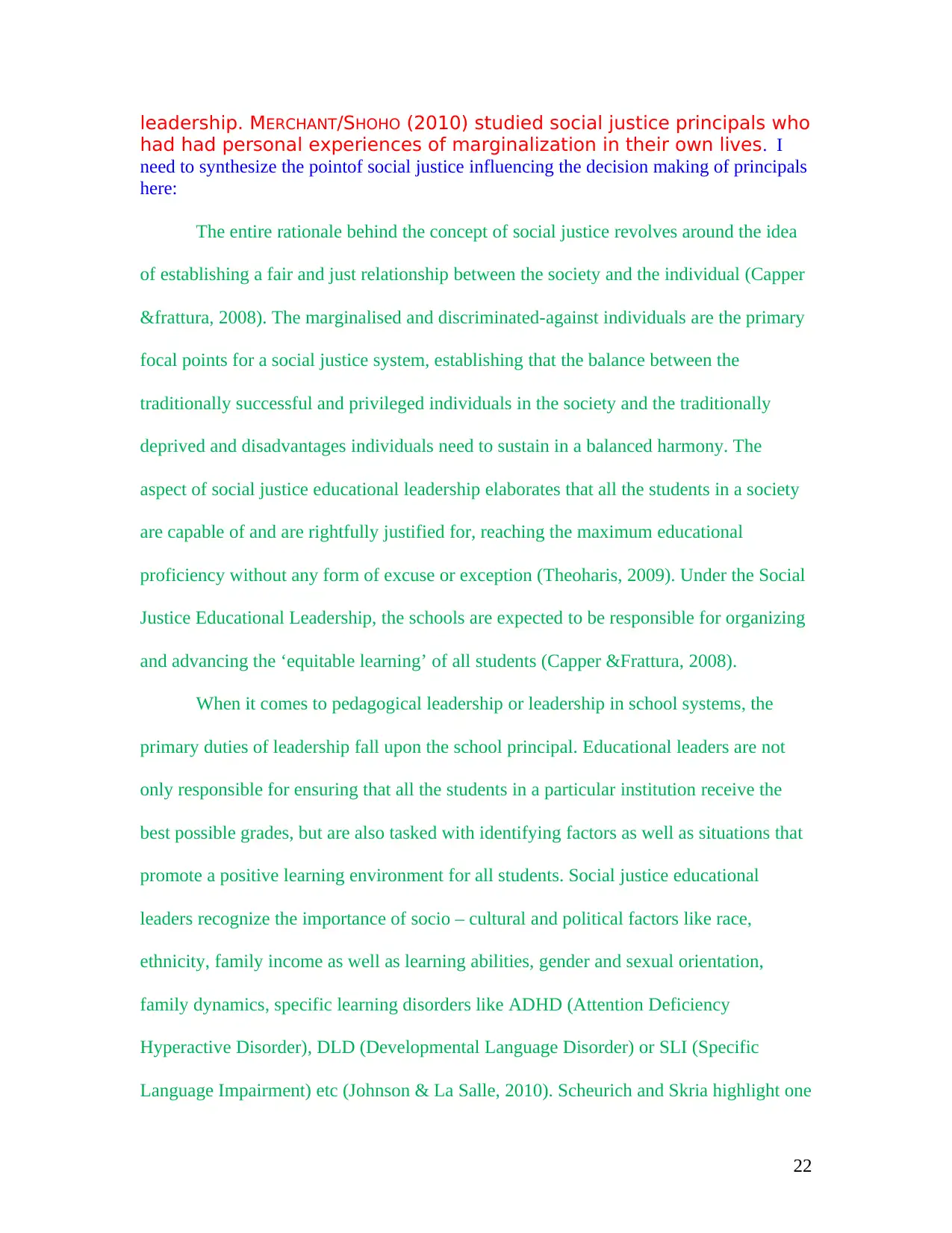
leadership. MERCHANT/SHOHO (2010) studied social justice principals who
had had personal experiences of marginalization in their own lives. I
need to synthesize the pointof social justice influencing the decision making of principals
here:
The entire rationale behind the concept of social justice revolves around the idea
of establishing a fair and just relationship between the society and the individual (Capper
&frattura, 2008). The marginalised and discriminated-against individuals are the primary
focal points for a social justice system, establishing that the balance between the
traditionally successful and privileged individuals in the society and the traditionally
deprived and disadvantages individuals need to sustain in a balanced harmony. The
aspect of social justice educational leadership elaborates that all the students in a society
are capable of and are rightfully justified for, reaching the maximum educational
proficiency without any form of excuse or exception (Theoharis, 2009). Under the Social
Justice Educational Leadership, the schools are expected to be responsible for organizing
and advancing the ‘equitable learning’ of all students (Capper &Frattura, 2008).
When it comes to pedagogical leadership or leadership in school systems, the
primary duties of leadership fall upon the school principal. Educational leaders are not
only responsible for ensuring that all the students in a particular institution receive the
best possible grades, but are also tasked with identifying factors as well as situations that
promote a positive learning environment for all students. Social justice educational
leaders recognize the importance of socio – cultural and political factors like race,
ethnicity, family income as well as learning abilities, gender and sexual orientation,
family dynamics, specific learning disorders like ADHD (Attention Deficiency
Hyperactive Disorder), DLD (Developmental Language Disorder) or SLI (Specific
Language Impairment) etc (Johnson & La Salle, 2010). Scheurich and Skria highlight one
22
had had personal experiences of marginalization in their own lives. I
need to synthesize the pointof social justice influencing the decision making of principals
here:
The entire rationale behind the concept of social justice revolves around the idea
of establishing a fair and just relationship between the society and the individual (Capper
&frattura, 2008). The marginalised and discriminated-against individuals are the primary
focal points for a social justice system, establishing that the balance between the
traditionally successful and privileged individuals in the society and the traditionally
deprived and disadvantages individuals need to sustain in a balanced harmony. The
aspect of social justice educational leadership elaborates that all the students in a society
are capable of and are rightfully justified for, reaching the maximum educational
proficiency without any form of excuse or exception (Theoharis, 2009). Under the Social
Justice Educational Leadership, the schools are expected to be responsible for organizing
and advancing the ‘equitable learning’ of all students (Capper &Frattura, 2008).
When it comes to pedagogical leadership or leadership in school systems, the
primary duties of leadership fall upon the school principal. Educational leaders are not
only responsible for ensuring that all the students in a particular institution receive the
best possible grades, but are also tasked with identifying factors as well as situations that
promote a positive learning environment for all students. Social justice educational
leaders recognize the importance of socio – cultural and political factors like race,
ethnicity, family income as well as learning abilities, gender and sexual orientation,
family dynamics, specific learning disorders like ADHD (Attention Deficiency
Hyperactive Disorder), DLD (Developmental Language Disorder) or SLI (Specific
Language Impairment) etc (Johnson & La Salle, 2010). Scheurich and Skria highlight one
22
Secure Best Marks with AI Grader
Need help grading? Try our AI Grader for instant feedback on your assignments.
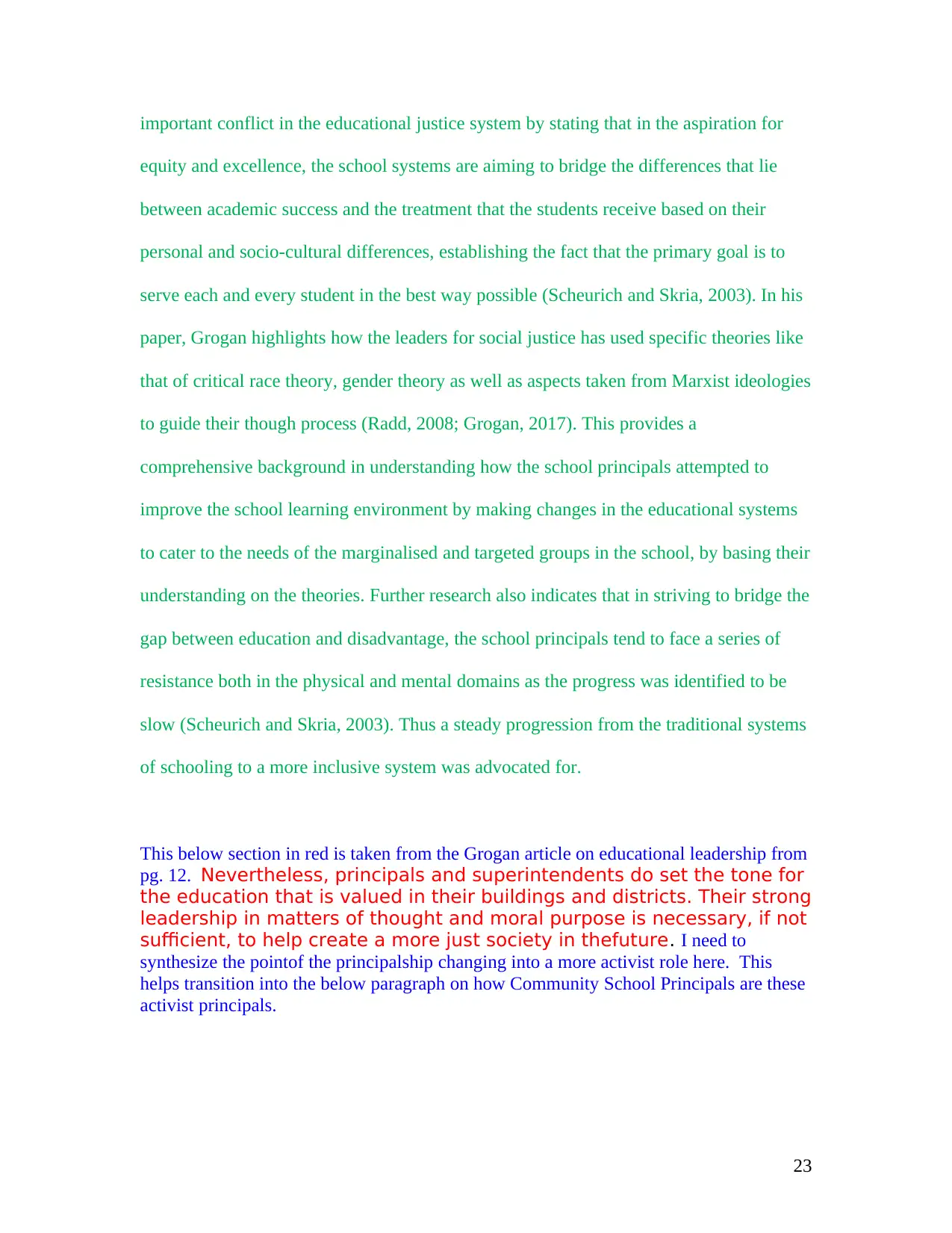
important conflict in the educational justice system by stating that in the aspiration for
equity and excellence, the school systems are aiming to bridge the differences that lie
between academic success and the treatment that the students receive based on their
personal and socio-cultural differences, establishing the fact that the primary goal is to
serve each and every student in the best way possible (Scheurich and Skria, 2003). In his
paper, Grogan highlights how the leaders for social justice has used specific theories like
that of critical race theory, gender theory as well as aspects taken from Marxist ideologies
to guide their though process (Radd, 2008; Grogan, 2017). This provides a
comprehensive background in understanding how the school principals attempted to
improve the school learning environment by making changes in the educational systems
to cater to the needs of the marginalised and targeted groups in the school, by basing their
understanding on the theories. Further research also indicates that in striving to bridge the
gap between education and disadvantage, the school principals tend to face a series of
resistance both in the physical and mental domains as the progress was identified to be
slow (Scheurich and Skria, 2003). Thus a steady progression from the traditional systems
of schooling to a more inclusive system was advocated for.
This below section in red is taken from the Grogan article on educational leadership from
pg. 12. Nevertheless, principals and superintendents do set the tone for
the education that is valued in their buildings and districts. Their strong
leadership in matters of thought and moral purpose is necessary, if not
sufficient, to help create a more just society in thefuture. I need to
synthesize the pointof the principalship changing into a more activist role here. This
helps transition into the below paragraph on how Community School Principals are these
activist principals.
23
equity and excellence, the school systems are aiming to bridge the differences that lie
between academic success and the treatment that the students receive based on their
personal and socio-cultural differences, establishing the fact that the primary goal is to
serve each and every student in the best way possible (Scheurich and Skria, 2003). In his
paper, Grogan highlights how the leaders for social justice has used specific theories like
that of critical race theory, gender theory as well as aspects taken from Marxist ideologies
to guide their though process (Radd, 2008; Grogan, 2017). This provides a
comprehensive background in understanding how the school principals attempted to
improve the school learning environment by making changes in the educational systems
to cater to the needs of the marginalised and targeted groups in the school, by basing their
understanding on the theories. Further research also indicates that in striving to bridge the
gap between education and disadvantage, the school principals tend to face a series of
resistance both in the physical and mental domains as the progress was identified to be
slow (Scheurich and Skria, 2003). Thus a steady progression from the traditional systems
of schooling to a more inclusive system was advocated for.
This below section in red is taken from the Grogan article on educational leadership from
pg. 12. Nevertheless, principals and superintendents do set the tone for
the education that is valued in their buildings and districts. Their strong
leadership in matters of thought and moral purpose is necessary, if not
sufficient, to help create a more just society in thefuture. I need to
synthesize the pointof the principalship changing into a more activist role here. This
helps transition into the below paragraph on how Community School Principals are these
activist principals.
23
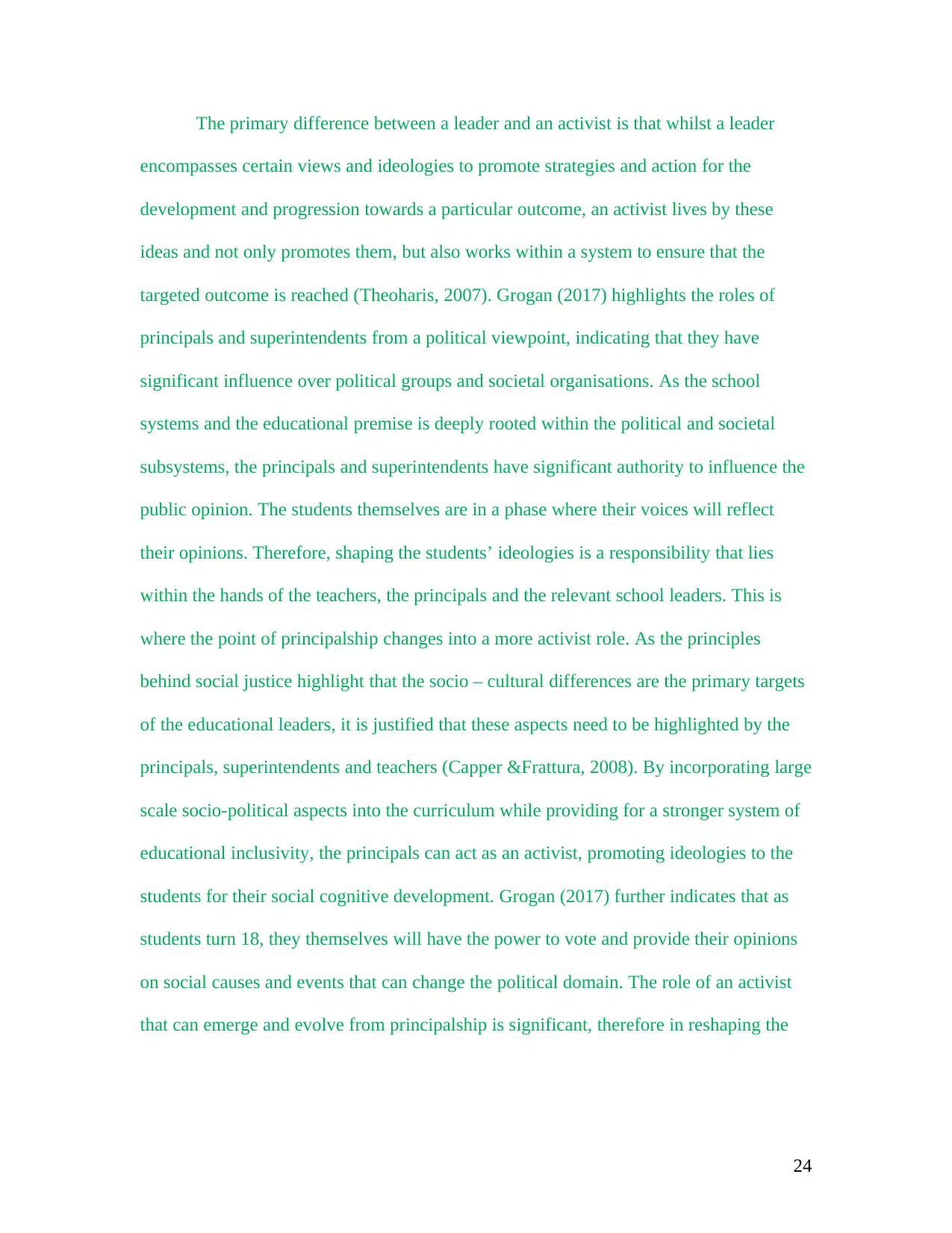
The primary difference between a leader and an activist is that whilst a leader
encompasses certain views and ideologies to promote strategies and action for the
development and progression towards a particular outcome, an activist lives by these
ideas and not only promotes them, but also works within a system to ensure that the
targeted outcome is reached (Theoharis, 2007). Grogan (2017) highlights the roles of
principals and superintendents from a political viewpoint, indicating that they have
significant influence over political groups and societal organisations. As the school
systems and the educational premise is deeply rooted within the political and societal
subsystems, the principals and superintendents have significant authority to influence the
public opinion. The students themselves are in a phase where their voices will reflect
their opinions. Therefore, shaping the students’ ideologies is a responsibility that lies
within the hands of the teachers, the principals and the relevant school leaders. This is
where the point of principalship changes into a more activist role. As the principles
behind social justice highlight that the socio – cultural differences are the primary targets
of the educational leaders, it is justified that these aspects need to be highlighted by the
principals, superintendents and teachers (Capper &Frattura, 2008). By incorporating large
scale socio-political aspects into the curriculum while providing for a stronger system of
educational inclusivity, the principals can act as an activist, promoting ideologies to the
students for their social cognitive development. Grogan (2017) further indicates that as
students turn 18, they themselves will have the power to vote and provide their opinions
on social causes and events that can change the political domain. The role of an activist
that can emerge and evolve from principalship is significant, therefore in reshaping the
24
encompasses certain views and ideologies to promote strategies and action for the
development and progression towards a particular outcome, an activist lives by these
ideas and not only promotes them, but also works within a system to ensure that the
targeted outcome is reached (Theoharis, 2007). Grogan (2017) highlights the roles of
principals and superintendents from a political viewpoint, indicating that they have
significant influence over political groups and societal organisations. As the school
systems and the educational premise is deeply rooted within the political and societal
subsystems, the principals and superintendents have significant authority to influence the
public opinion. The students themselves are in a phase where their voices will reflect
their opinions. Therefore, shaping the students’ ideologies is a responsibility that lies
within the hands of the teachers, the principals and the relevant school leaders. This is
where the point of principalship changes into a more activist role. As the principles
behind social justice highlight that the socio – cultural differences are the primary targets
of the educational leaders, it is justified that these aspects need to be highlighted by the
principals, superintendents and teachers (Capper &Frattura, 2008). By incorporating large
scale socio-political aspects into the curriculum while providing for a stronger system of
educational inclusivity, the principals can act as an activist, promoting ideologies to the
students for their social cognitive development. Grogan (2017) further indicates that as
students turn 18, they themselves will have the power to vote and provide their opinions
on social causes and events that can change the political domain. The role of an activist
that can emerge and evolve from principalship is significant, therefore in reshaping the
24
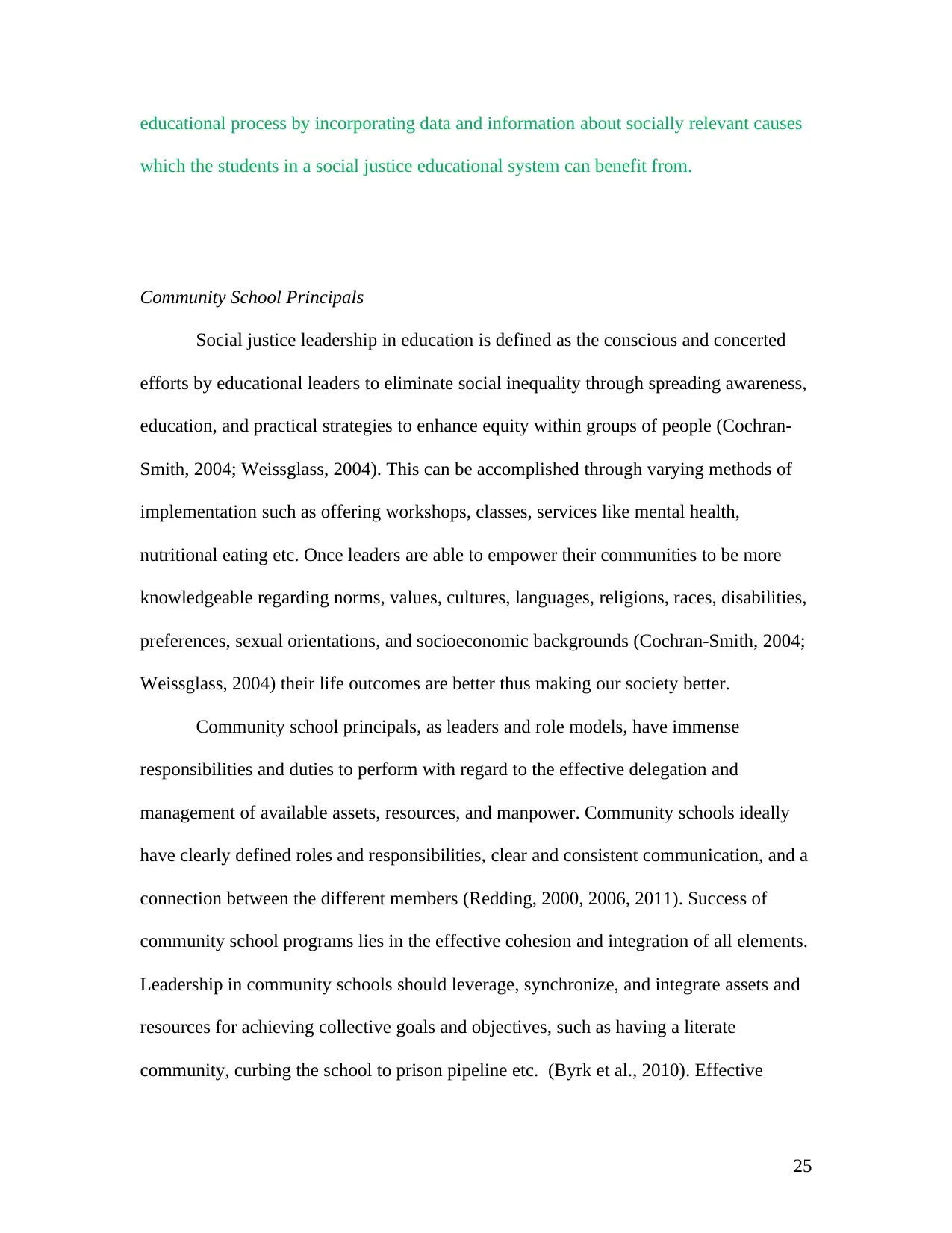
educational process by incorporating data and information about socially relevant causes
which the students in a social justice educational system can benefit from.
Community School Principals
Social justice leadership in education is defined as the conscious and concerted
efforts by educational leaders to eliminate social inequality through spreading awareness,
education, and practical strategies to enhance equity within groups of people (Cochran-
Smith, 2004; Weissglass, 2004). This can be accomplished through varying methods of
implementation such as offering workshops, classes, services like mental health,
nutritional eating etc. Once leaders are able to empower their communities to be more
knowledgeable regarding norms, values, cultures, languages, religions, races, disabilities,
preferences, sexual orientations, and socioeconomic backgrounds (Cochran-Smith, 2004;
Weissglass, 2004) their life outcomes are better thus making our society better.
Community school principals, as leaders and role models, have immense
responsibilities and duties to perform with regard to the effective delegation and
management of available assets, resources, and manpower. Community schools ideally
have clearly defined roles and responsibilities, clear and consistent communication, and a
connection between the different members (Redding, 2000, 2006, 2011). Success of
community school programs lies in the effective cohesion and integration of all elements.
Leadership in community schools should leverage, synchronize, and integrate assets and
resources for achieving collective goals and objectives, such as having a literate
community, curbing the school to prison pipeline etc. (Byrk et al., 2010). Effective
25
which the students in a social justice educational system can benefit from.
Community School Principals
Social justice leadership in education is defined as the conscious and concerted
efforts by educational leaders to eliminate social inequality through spreading awareness,
education, and practical strategies to enhance equity within groups of people (Cochran-
Smith, 2004; Weissglass, 2004). This can be accomplished through varying methods of
implementation such as offering workshops, classes, services like mental health,
nutritional eating etc. Once leaders are able to empower their communities to be more
knowledgeable regarding norms, values, cultures, languages, religions, races, disabilities,
preferences, sexual orientations, and socioeconomic backgrounds (Cochran-Smith, 2004;
Weissglass, 2004) their life outcomes are better thus making our society better.
Community school principals, as leaders and role models, have immense
responsibilities and duties to perform with regard to the effective delegation and
management of available assets, resources, and manpower. Community schools ideally
have clearly defined roles and responsibilities, clear and consistent communication, and a
connection between the different members (Redding, 2000, 2006, 2011). Success of
community school programs lies in the effective cohesion and integration of all elements.
Leadership in community schools should leverage, synchronize, and integrate assets and
resources for achieving collective goals and objectives, such as having a literate
community, curbing the school to prison pipeline etc. (Byrk et al., 2010). Effective
25
Paraphrase This Document
Need a fresh take? Get an instant paraphrase of this document with our AI Paraphraser
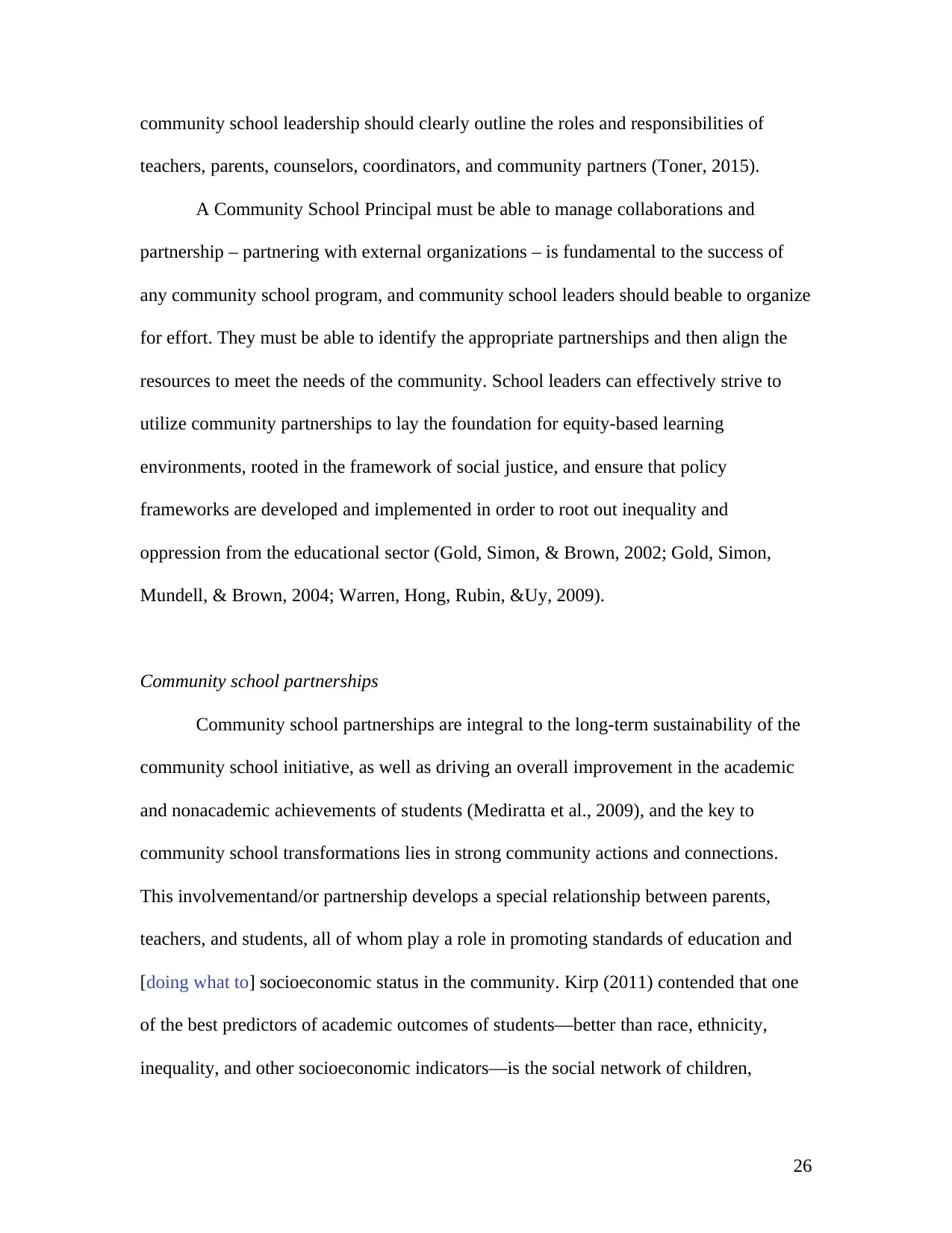
community school leadership should clearly outline the roles and responsibilities of
teachers, parents, counselors, coordinators, and community partners (Toner, 2015).
A Community School Principal must be able to manage collaborations and
partnership – partnering with external organizations – is fundamental to the success of
any community school program, and community school leaders should beable to organize
for effort. They must be able to identify the appropriate partnerships and then align the
resources to meet the needs of the community. School leaders can effectively strive to
utilize community partnerships to lay the foundation for equity-based learning
environments, rooted in the framework of social justice, and ensure that policy
frameworks are developed and implemented in order to root out inequality and
oppression from the educational sector (Gold, Simon, & Brown, 2002; Gold, Simon,
Mundell, & Brown, 2004; Warren, Hong, Rubin, &Uy, 2009).
Community school partnerships
Community school partnerships are integral to the long-term sustainability of the
community school initiative, as well as driving an overall improvement in the academic
and nonacademic achievements of students (Mediratta et al., 2009), and the key to
community school transformations lies in strong community actions and connections.
This involvementand/or partnership develops a special relationship between parents,
teachers, and students, all of whom play a role in promoting standards of education and
[doing what to] socioeconomic status in the community. Kirp (2011) contended that one
of the best predictors of academic outcomes of students—better than race, ethnicity,
inequality, and other socioeconomic indicators—is the social network of children,
26
teachers, parents, counselors, coordinators, and community partners (Toner, 2015).
A Community School Principal must be able to manage collaborations and
partnership – partnering with external organizations – is fundamental to the success of
any community school program, and community school leaders should beable to organize
for effort. They must be able to identify the appropriate partnerships and then align the
resources to meet the needs of the community. School leaders can effectively strive to
utilize community partnerships to lay the foundation for equity-based learning
environments, rooted in the framework of social justice, and ensure that policy
frameworks are developed and implemented in order to root out inequality and
oppression from the educational sector (Gold, Simon, & Brown, 2002; Gold, Simon,
Mundell, & Brown, 2004; Warren, Hong, Rubin, &Uy, 2009).
Community school partnerships
Community school partnerships are integral to the long-term sustainability of the
community school initiative, as well as driving an overall improvement in the academic
and nonacademic achievements of students (Mediratta et al., 2009), and the key to
community school transformations lies in strong community actions and connections.
This involvementand/or partnership develops a special relationship between parents,
teachers, and students, all of whom play a role in promoting standards of education and
[doing what to] socioeconomic status in the community. Kirp (2011) contended that one
of the best predictors of academic outcomes of students—better than race, ethnicity,
inequality, and other socioeconomic indicators—is the social network of children,
26
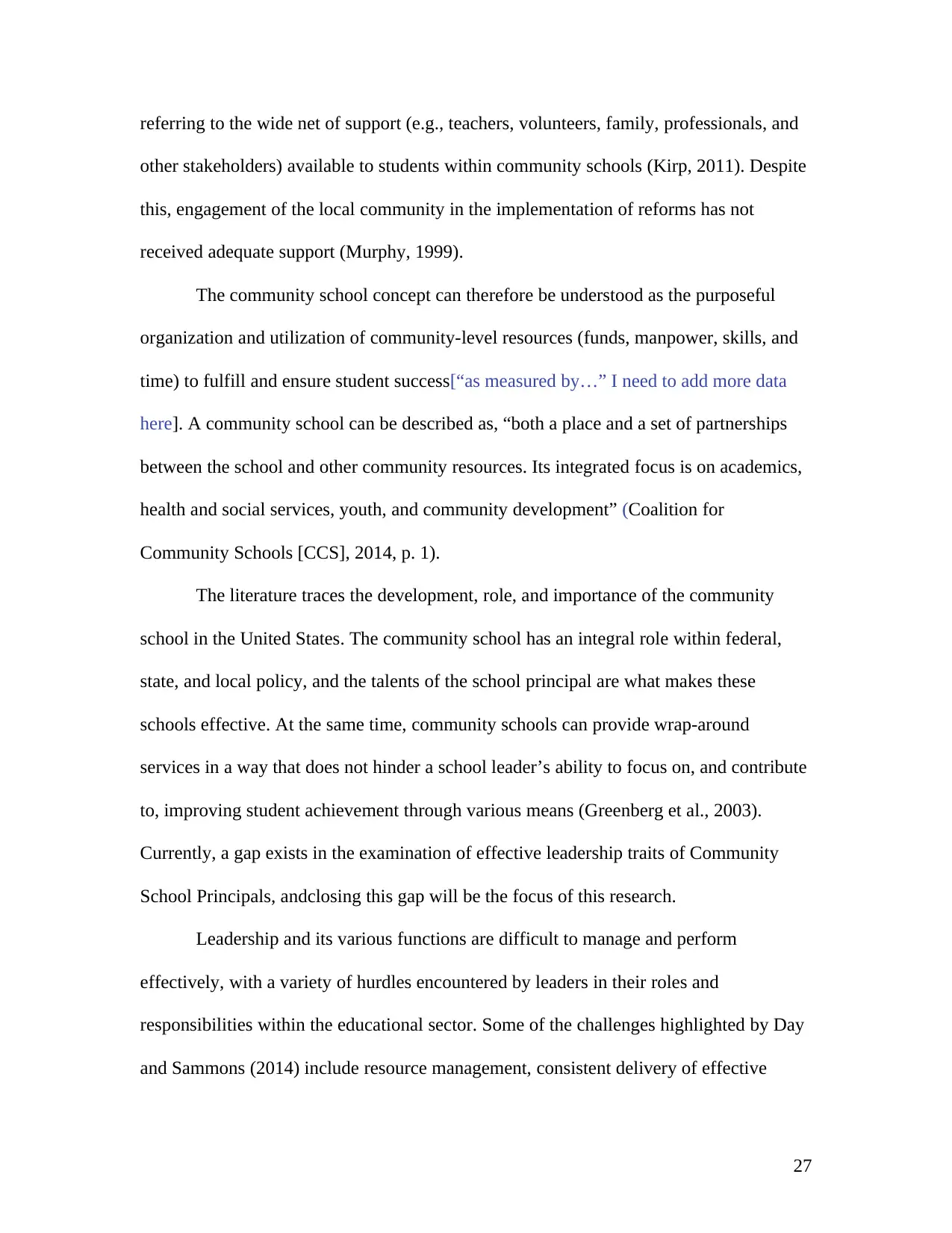
referring to the wide net of support (e.g., teachers, volunteers, family, professionals, and
other stakeholders) available to students within community schools (Kirp, 2011). Despite
this, engagement of the local community in the implementation of reforms has not
received adequate support (Murphy, 1999).
The community school concept can therefore be understood as the purposeful
organization and utilization of community-level resources (funds, manpower, skills, and
time) to fulfill and ensure student success[“as measured by…” I need to add more data
here]. A community school can be described as, “both a place and a set of partnerships
between the school and other community resources. Its integrated focus is on academics,
health and social services, youth, and community development” (Coalition for
Community Schools [CCS], 2014, p. 1).
The literature traces the development, role, and importance of the community
school in the United States. The community school has an integral role within federal,
state, and local policy, and the talents of the school principal are what makes these
schools effective. At the same time, community schools can provide wrap-around
services in a way that does not hinder a school leader’s ability to focus on, and contribute
to, improving student achievement through various means (Greenberg et al., 2003).
Currently, a gap exists in the examination of effective leadership traits of Community
School Principals, andclosing this gap will be the focus of this research.
Leadership and its various functions are difficult to manage and perform
effectively, with a variety of hurdles encountered by leaders in their roles and
responsibilities within the educational sector. Some of the challenges highlighted by Day
and Sammons (2014) include resource management, consistent delivery of effective
27
other stakeholders) available to students within community schools (Kirp, 2011). Despite
this, engagement of the local community in the implementation of reforms has not
received adequate support (Murphy, 1999).
The community school concept can therefore be understood as the purposeful
organization and utilization of community-level resources (funds, manpower, skills, and
time) to fulfill and ensure student success[“as measured by…” I need to add more data
here]. A community school can be described as, “both a place and a set of partnerships
between the school and other community resources. Its integrated focus is on academics,
health and social services, youth, and community development” (Coalition for
Community Schools [CCS], 2014, p. 1).
The literature traces the development, role, and importance of the community
school in the United States. The community school has an integral role within federal,
state, and local policy, and the talents of the school principal are what makes these
schools effective. At the same time, community schools can provide wrap-around
services in a way that does not hinder a school leader’s ability to focus on, and contribute
to, improving student achievement through various means (Greenberg et al., 2003).
Currently, a gap exists in the examination of effective leadership traits of Community
School Principals, andclosing this gap will be the focus of this research.
Leadership and its various functions are difficult to manage and perform
effectively, with a variety of hurdles encountered by leaders in their roles and
responsibilities within the educational sector. Some of the challenges highlighted by Day
and Sammons (2014) include resource management, consistent delivery of effective
27
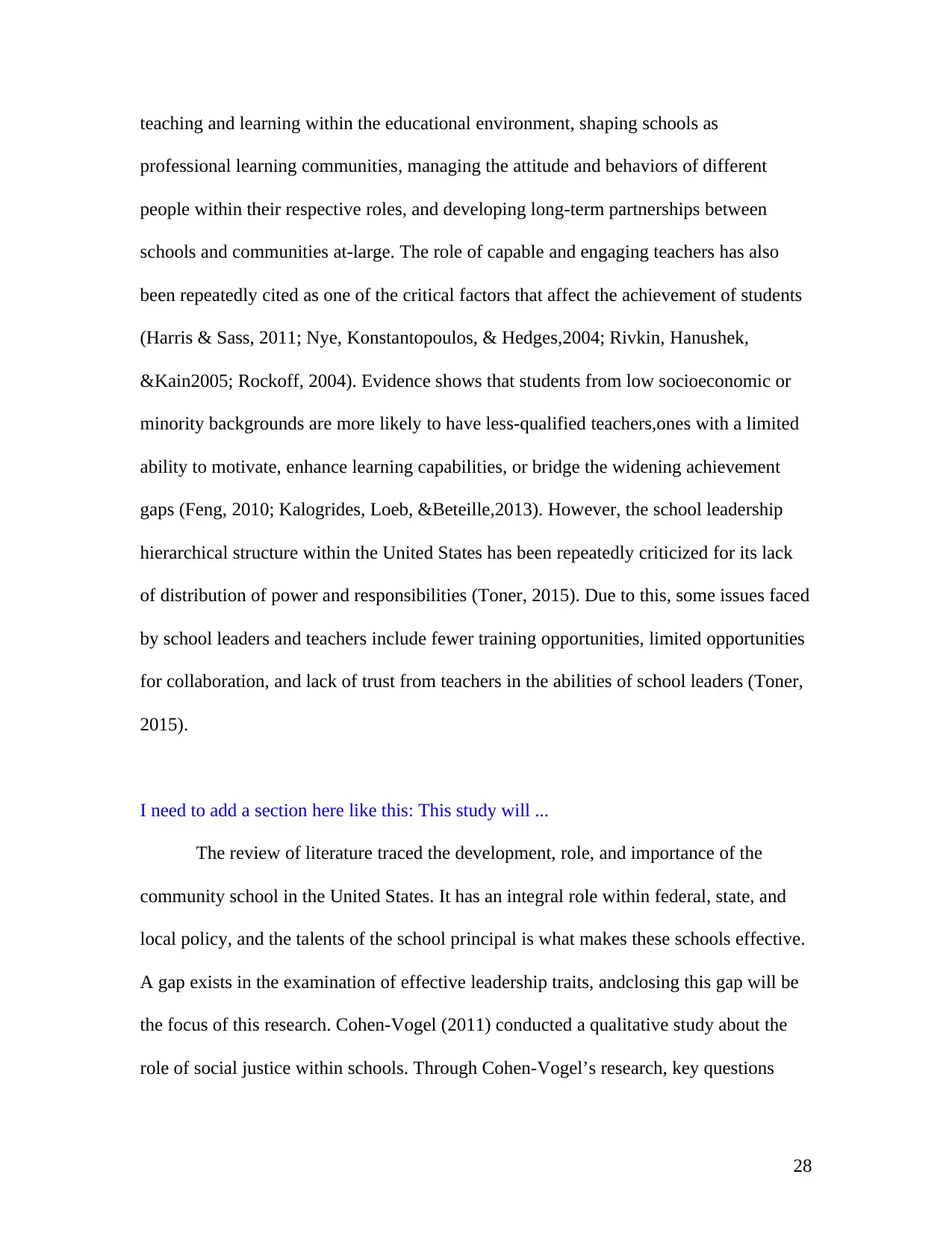
teaching and learning within the educational environment, shaping schools as
professional learning communities, managing the attitude and behaviors of different
people within their respective roles, and developing long-term partnerships between
schools and communities at-large. The role of capable and engaging teachers has also
been repeatedly cited as one of the critical factors that affect the achievement of students
(Harris & Sass, 2011; Nye, Konstantopoulos, & Hedges,2004; Rivkin, Hanushek,
&Kain2005; Rockoff, 2004). Evidence shows that students from low socioeconomic or
minority backgrounds are more likely to have less-qualified teachers,ones with a limited
ability to motivate, enhance learning capabilities, or bridge the widening achievement
gaps (Feng, 2010; Kalogrides, Loeb, &Beteille,2013). However, the school leadership
hierarchical structure within the United States has been repeatedly criticized for its lack
of distribution of power and responsibilities (Toner, 2015). Due to this, some issues faced
by school leaders and teachers include fewer training opportunities, limited opportunities
for collaboration, and lack of trust from teachers in the abilities of school leaders (Toner,
2015).
I need to add a section here like this: This study will ...
The review of literature traced the development, role, and importance of the
community school in the United States. It has an integral role within federal, state, and
local policy, and the talents of the school principal is what makes these schools effective.
A gap exists in the examination of effective leadership traits, andclosing this gap will be
the focus of this research. Cohen-Vogel (2011) conducted a qualitative study about the
role of social justice within schools. Through Cohen-Vogel’s research, key questions
28
professional learning communities, managing the attitude and behaviors of different
people within their respective roles, and developing long-term partnerships between
schools and communities at-large. The role of capable and engaging teachers has also
been repeatedly cited as one of the critical factors that affect the achievement of students
(Harris & Sass, 2011; Nye, Konstantopoulos, & Hedges,2004; Rivkin, Hanushek,
&Kain2005; Rockoff, 2004). Evidence shows that students from low socioeconomic or
minority backgrounds are more likely to have less-qualified teachers,ones with a limited
ability to motivate, enhance learning capabilities, or bridge the widening achievement
gaps (Feng, 2010; Kalogrides, Loeb, &Beteille,2013). However, the school leadership
hierarchical structure within the United States has been repeatedly criticized for its lack
of distribution of power and responsibilities (Toner, 2015). Due to this, some issues faced
by school leaders and teachers include fewer training opportunities, limited opportunities
for collaboration, and lack of trust from teachers in the abilities of school leaders (Toner,
2015).
I need to add a section here like this: This study will ...
The review of literature traced the development, role, and importance of the
community school in the United States. It has an integral role within federal, state, and
local policy, and the talents of the school principal is what makes these schools effective.
A gap exists in the examination of effective leadership traits, andclosing this gap will be
the focus of this research. Cohen-Vogel (2011) conducted a qualitative study about the
role of social justice within schools. Through Cohen-Vogel’s research, key questions
28
Secure Best Marks with AI Grader
Need help grading? Try our AI Grader for instant feedback on your assignments.
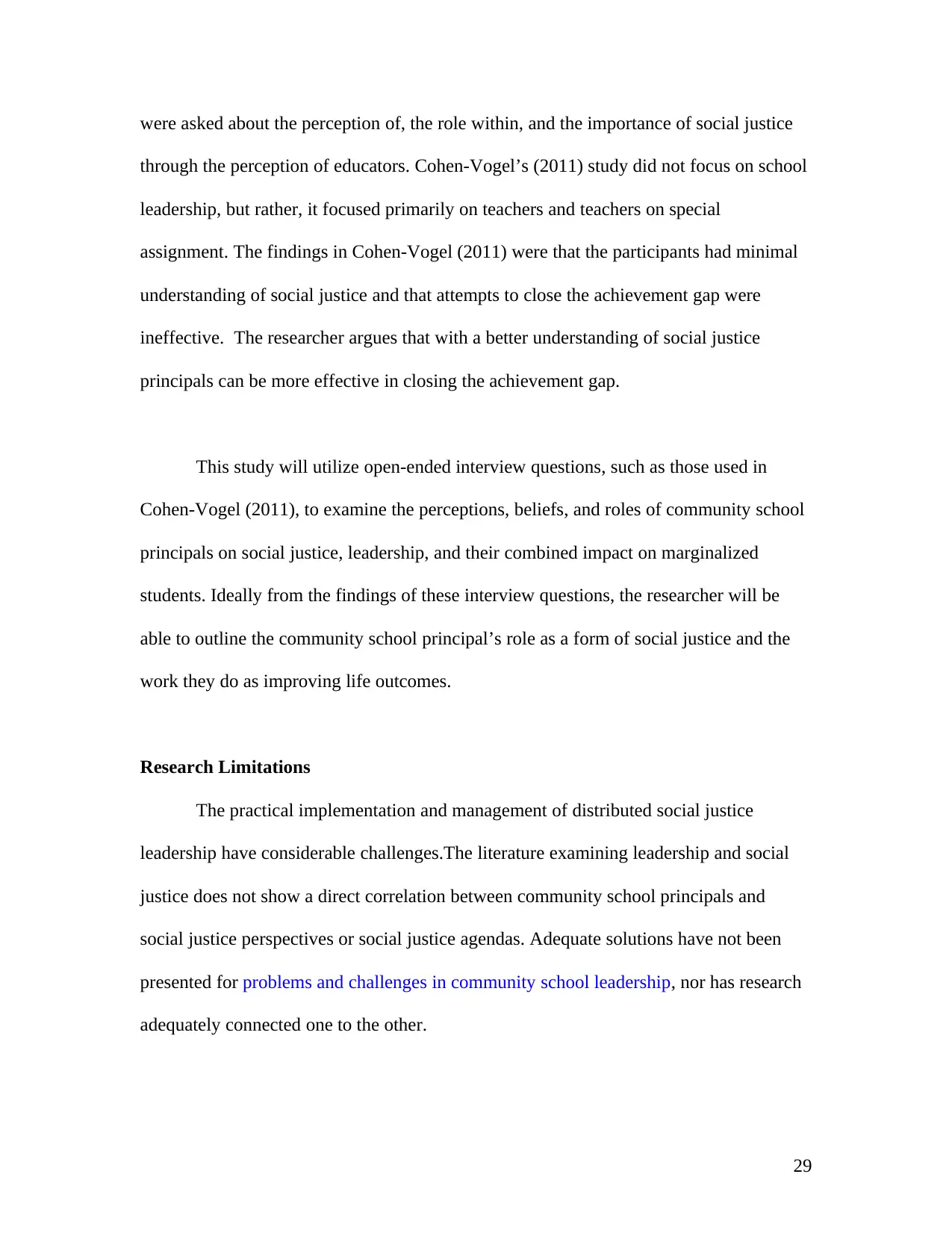
were asked about the perception of, the role within, and the importance of social justice
through the perception of educators. Cohen-Vogel’s (2011) study did not focus on school
leadership, but rather, it focused primarily on teachers and teachers on special
assignment. The findings in Cohen-Vogel (2011) were that the participants had minimal
understanding of social justice and that attempts to close the achievement gap were
ineffective. The researcher argues that with a better understanding of social justice
principals can be more effective in closing the achievement gap.
This study will utilize open-ended interview questions, such as those used in
Cohen-Vogel (2011), to examine the perceptions, beliefs, and roles of community school
principals on social justice, leadership, and their combined impact on marginalized
students. Ideally from the findings of these interview questions, the researcher will be
able to outline the community school principal’s role as a form of social justice and the
work they do as improving life outcomes.
Research Limitations
The practical implementation and management of distributed social justice
leadership have considerable challenges.The literature examining leadership and social
justice does not show a direct correlation between community school principals and
social justice perspectives or social justice agendas. Adequate solutions have not been
presented for problems and challenges in community school leadership, nor has research
adequately connected one to the other.
29
through the perception of educators. Cohen-Vogel’s (2011) study did not focus on school
leadership, but rather, it focused primarily on teachers and teachers on special
assignment. The findings in Cohen-Vogel (2011) were that the participants had minimal
understanding of social justice and that attempts to close the achievement gap were
ineffective. The researcher argues that with a better understanding of social justice
principals can be more effective in closing the achievement gap.
This study will utilize open-ended interview questions, such as those used in
Cohen-Vogel (2011), to examine the perceptions, beliefs, and roles of community school
principals on social justice, leadership, and their combined impact on marginalized
students. Ideally from the findings of these interview questions, the researcher will be
able to outline the community school principal’s role as a form of social justice and the
work they do as improving life outcomes.
Research Limitations
The practical implementation and management of distributed social justice
leadership have considerable challenges.The literature examining leadership and social
justice does not show a direct correlation between community school principals and
social justice perspectives or social justice agendas. Adequate solutions have not been
presented for problems and challenges in community school leadership, nor has research
adequately connected one to the other.
29
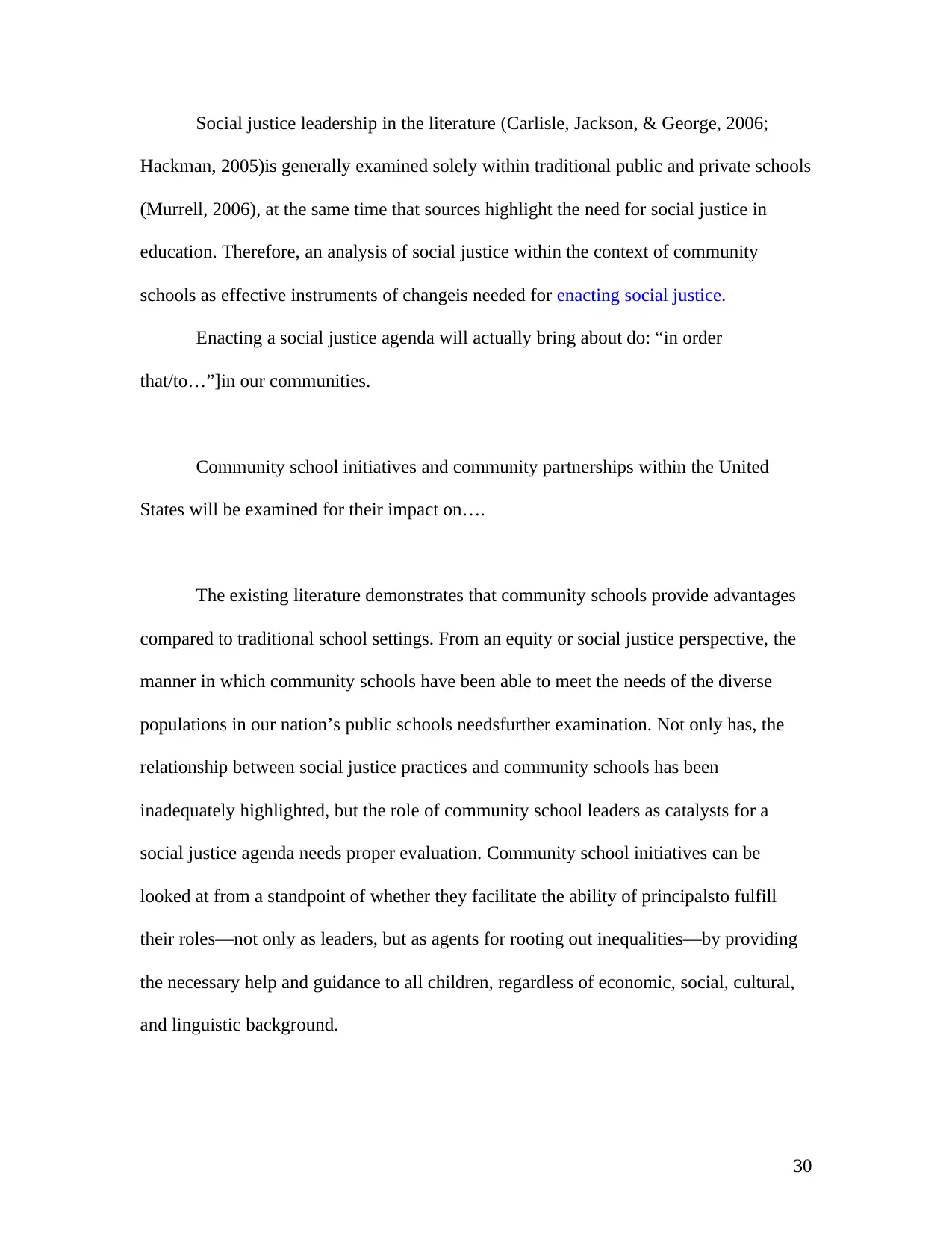
Social justice leadership in the literature (Carlisle, Jackson, & George, 2006;
Hackman, 2005)is generally examined solely within traditional public and private schools
(Murrell, 2006), at the same time that sources highlight the need for social justice in
education. Therefore, an analysis of social justice within the context of community
schools as effective instruments of changeis needed for enacting social justice.
Enacting a social justice agenda will actually bring about do: “in order
that/to…”]in our communities.
Community school initiatives and community partnerships within the United
States will be examined for their impact on….
The existing literature demonstrates that community schools provide advantages
compared to traditional school settings. From an equity or social justice perspective, the
manner in which community schools have been able to meet the needs of the diverse
populations in our nation’s public schools needsfurther examination. Not only has, the
relationship between social justice practices and community schools has been
inadequately highlighted, but the role of community school leaders as catalysts for a
social justice agenda needs proper evaluation. Community school initiatives can be
looked at from a standpoint of whether they facilitate the ability of principalsto fulfill
their roles—not only as leaders, but as agents for rooting out inequalities—by providing
the necessary help and guidance to all children, regardless of economic, social, cultural,
and linguistic background.
30
Hackman, 2005)is generally examined solely within traditional public and private schools
(Murrell, 2006), at the same time that sources highlight the need for social justice in
education. Therefore, an analysis of social justice within the context of community
schools as effective instruments of changeis needed for enacting social justice.
Enacting a social justice agenda will actually bring about do: “in order
that/to…”]in our communities.
Community school initiatives and community partnerships within the United
States will be examined for their impact on….
The existing literature demonstrates that community schools provide advantages
compared to traditional school settings. From an equity or social justice perspective, the
manner in which community schools have been able to meet the needs of the diverse
populations in our nation’s public schools needsfurther examination. Not only has, the
relationship between social justice practices and community schools has been
inadequately highlighted, but the role of community school leaders as catalysts for a
social justice agenda needs proper evaluation. Community school initiatives can be
looked at from a standpoint of whether they facilitate the ability of principalsto fulfill
their roles—not only as leaders, but as agents for rooting out inequalities—by providing
the necessary help and guidance to all children, regardless of economic, social, cultural,
and linguistic background.
30
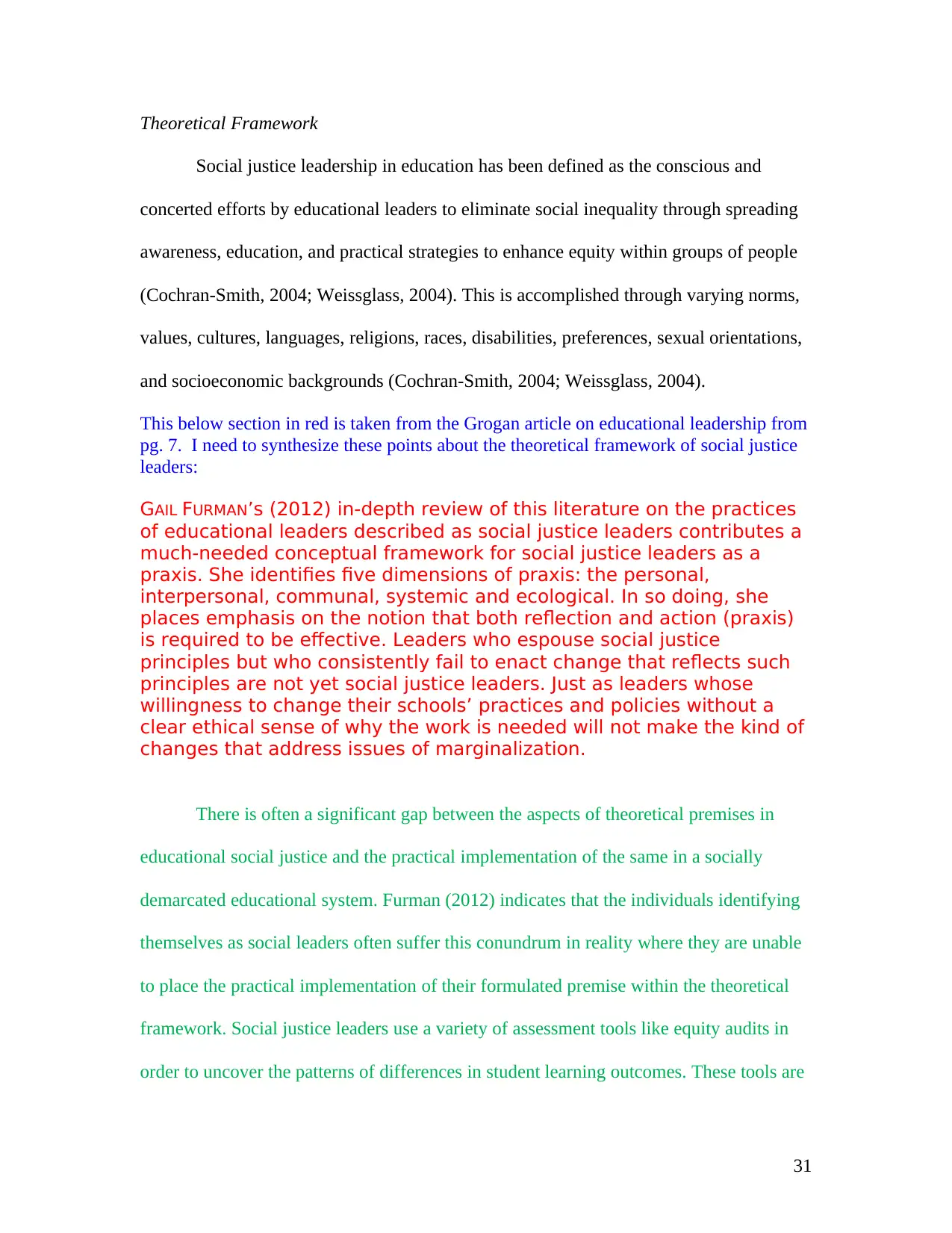
Theoretical Framework
Social justice leadership in education has been defined as the conscious and
concerted efforts by educational leaders to eliminate social inequality through spreading
awareness, education, and practical strategies to enhance equity within groups of people
(Cochran-Smith, 2004; Weissglass, 2004). This is accomplished through varying norms,
values, cultures, languages, religions, races, disabilities, preferences, sexual orientations,
and socioeconomic backgrounds (Cochran-Smith, 2004; Weissglass, 2004).
This below section in red is taken from the Grogan article on educational leadership from
pg. 7. I need to synthesize these points about the theoretical framework of social justice
leaders:
GAIL FURMAN’s (2012) in-depth review of this literature on the practices
of educational leaders described as social justice leaders contributes a
much-needed conceptual framework for social justice leaders as a
praxis. She identifies five dimensions of praxis: the personal,
interpersonal, communal, systemic and ecological. In so doing, she
places emphasis on the notion that both reflection and action (praxis)
is required to be effective. Leaders who espouse social justice
principles but who consistently fail to enact change that reflects such
principles are not yet social justice leaders. Just as leaders whose
willingness to change their schools’ practices and policies without a
clear ethical sense of why the work is needed will not make the kind of
changes that address issues of marginalization.
There is often a significant gap between the aspects of theoretical premises in
educational social justice and the practical implementation of the same in a socially
demarcated educational system. Furman (2012) indicates that the individuals identifying
themselves as social leaders often suffer this conundrum in reality where they are unable
to place the practical implementation of their formulated premise within the theoretical
framework. Social justice leaders use a variety of assessment tools like equity audits in
order to uncover the patterns of differences in student learning outcomes. These tools are
31
Social justice leadership in education has been defined as the conscious and
concerted efforts by educational leaders to eliminate social inequality through spreading
awareness, education, and practical strategies to enhance equity within groups of people
(Cochran-Smith, 2004; Weissglass, 2004). This is accomplished through varying norms,
values, cultures, languages, religions, races, disabilities, preferences, sexual orientations,
and socioeconomic backgrounds (Cochran-Smith, 2004; Weissglass, 2004).
This below section in red is taken from the Grogan article on educational leadership from
pg. 7. I need to synthesize these points about the theoretical framework of social justice
leaders:
GAIL FURMAN’s (2012) in-depth review of this literature on the practices
of educational leaders described as social justice leaders contributes a
much-needed conceptual framework for social justice leaders as a
praxis. She identifies five dimensions of praxis: the personal,
interpersonal, communal, systemic and ecological. In so doing, she
places emphasis on the notion that both reflection and action (praxis)
is required to be effective. Leaders who espouse social justice
principles but who consistently fail to enact change that reflects such
principles are not yet social justice leaders. Just as leaders whose
willingness to change their schools’ practices and policies without a
clear ethical sense of why the work is needed will not make the kind of
changes that address issues of marginalization.
There is often a significant gap between the aspects of theoretical premises in
educational social justice and the practical implementation of the same in a socially
demarcated educational system. Furman (2012) indicates that the individuals identifying
themselves as social leaders often suffer this conundrum in reality where they are unable
to place the practical implementation of their formulated premise within the theoretical
framework. Social justice leaders use a variety of assessment tools like equity audits in
order to uncover the patterns of differences in student learning outcomes. These tools are
31
Paraphrase This Document
Need a fresh take? Get an instant paraphrase of this document with our AI Paraphraser
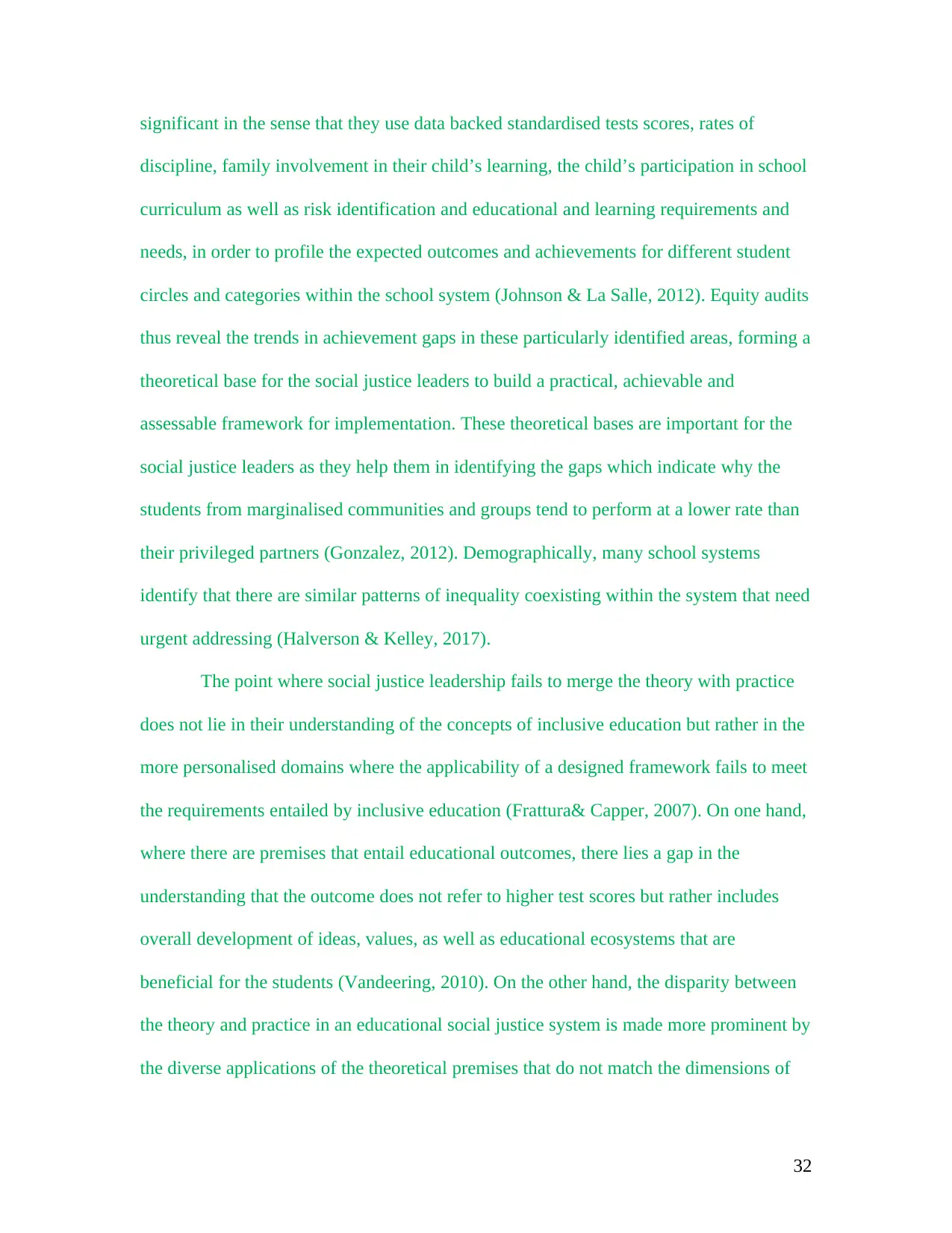
significant in the sense that they use data backed standardised tests scores, rates of
discipline, family involvement in their child’s learning, the child’s participation in school
curriculum as well as risk identification and educational and learning requirements and
needs, in order to profile the expected outcomes and achievements for different student
circles and categories within the school system (Johnson & La Salle, 2012). Equity audits
thus reveal the trends in achievement gaps in these particularly identified areas, forming a
theoretical base for the social justice leaders to build a practical, achievable and
assessable framework for implementation. These theoretical bases are important for the
social justice leaders as they help them in identifying the gaps which indicate why the
students from marginalised communities and groups tend to perform at a lower rate than
their privileged partners (Gonzalez, 2012). Demographically, many school systems
identify that there are similar patterns of inequality coexisting within the system that need
urgent addressing (Halverson & Kelley, 2017).
The point where social justice leadership fails to merge the theory with practice
does not lie in their understanding of the concepts of inclusive education but rather in the
more personalised domains where the applicability of a designed framework fails to meet
the requirements entailed by inclusive education (Frattura& Capper, 2007). On one hand,
where there are premises that entail educational outcomes, there lies a gap in the
understanding that the outcome does not refer to higher test scores but rather includes
overall development of ideas, values, as well as educational ecosystems that are
beneficial for the students (Vandeering, 2010). On the other hand, the disparity between
the theory and practice in an educational social justice system is made more prominent by
the diverse applications of the theoretical premises that do not match the dimensions of
32
discipline, family involvement in their child’s learning, the child’s participation in school
curriculum as well as risk identification and educational and learning requirements and
needs, in order to profile the expected outcomes and achievements for different student
circles and categories within the school system (Johnson & La Salle, 2012). Equity audits
thus reveal the trends in achievement gaps in these particularly identified areas, forming a
theoretical base for the social justice leaders to build a practical, achievable and
assessable framework for implementation. These theoretical bases are important for the
social justice leaders as they help them in identifying the gaps which indicate why the
students from marginalised communities and groups tend to perform at a lower rate than
their privileged partners (Gonzalez, 2012). Demographically, many school systems
identify that there are similar patterns of inequality coexisting within the system that need
urgent addressing (Halverson & Kelley, 2017).
The point where social justice leadership fails to merge the theory with practice
does not lie in their understanding of the concepts of inclusive education but rather in the
more personalised domains where the applicability of a designed framework fails to meet
the requirements entailed by inclusive education (Frattura& Capper, 2007). On one hand,
where there are premises that entail educational outcomes, there lies a gap in the
understanding that the outcome does not refer to higher test scores but rather includes
overall development of ideas, values, as well as educational ecosystems that are
beneficial for the students (Vandeering, 2010). On the other hand, the disparity between
the theory and practice in an educational social justice system is made more prominent by
the diverse applications of the theoretical premises that do not match the dimensions of
32
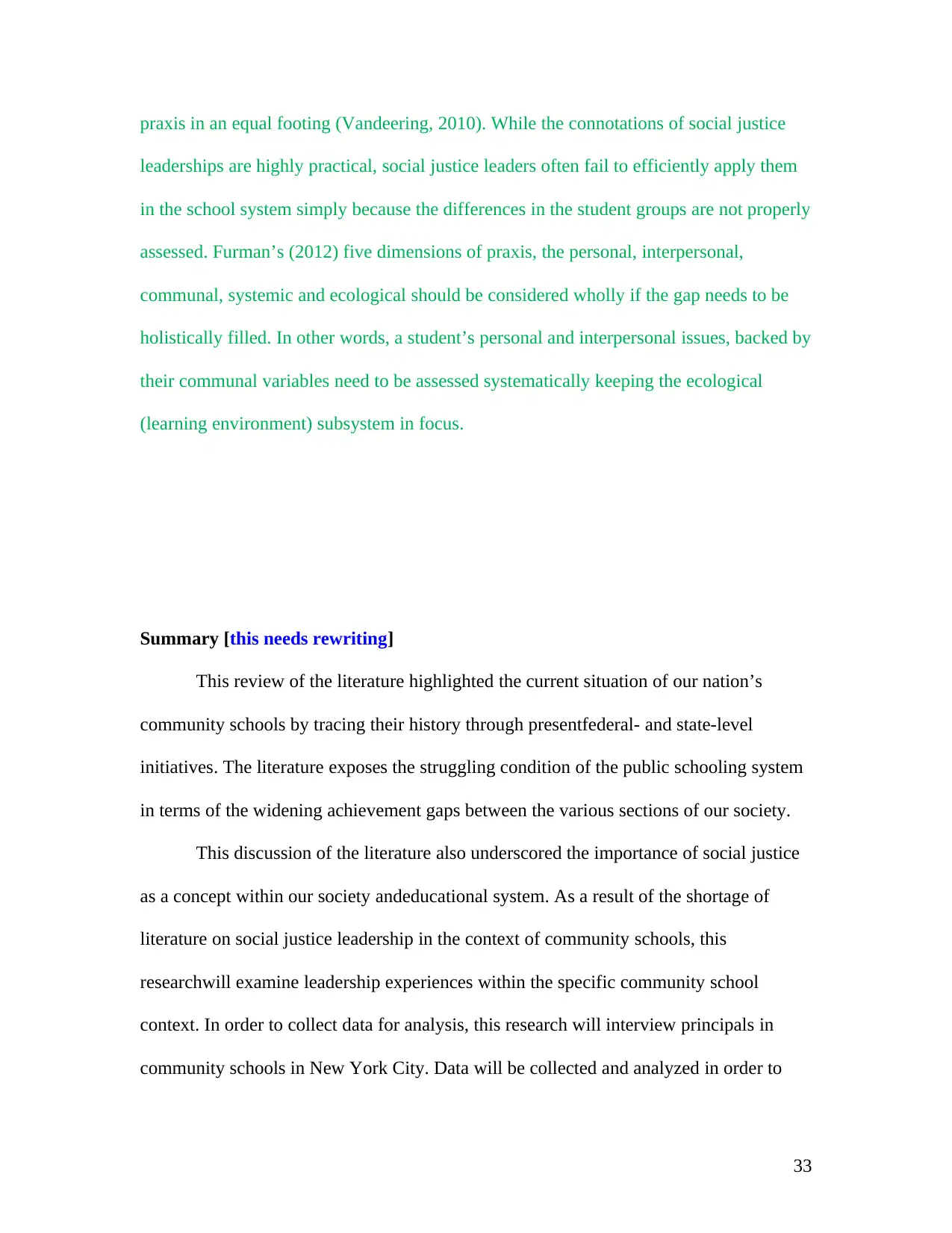
praxis in an equal footing (Vandeering, 2010). While the connotations of social justice
leaderships are highly practical, social justice leaders often fail to efficiently apply them
in the school system simply because the differences in the student groups are not properly
assessed. Furman’s (2012) five dimensions of praxis, the personal, interpersonal,
communal, systemic and ecological should be considered wholly if the gap needs to be
holistically filled. In other words, a student’s personal and interpersonal issues, backed by
their communal variables need to be assessed systematically keeping the ecological
(learning environment) subsystem in focus.
Summary [this needs rewriting]
This review of the literature highlighted the current situation of our nation’s
community schools by tracing their history through presentfederal- and state-level
initiatives. The literature exposes the struggling condition of the public schooling system
in terms of the widening achievement gaps between the various sections of our society.
This discussion of the literature also underscored the importance of social justice
as a concept within our society andeducational system. As a result of the shortage of
literature on social justice leadership in the context of community schools, this
researchwill examine leadership experiences within the specific community school
context. In order to collect data for analysis, this research will interview principals in
community schools in New York City. Data will be collected and analyzed in order to
33
leaderships are highly practical, social justice leaders often fail to efficiently apply them
in the school system simply because the differences in the student groups are not properly
assessed. Furman’s (2012) five dimensions of praxis, the personal, interpersonal,
communal, systemic and ecological should be considered wholly if the gap needs to be
holistically filled. In other words, a student’s personal and interpersonal issues, backed by
their communal variables need to be assessed systematically keeping the ecological
(learning environment) subsystem in focus.
Summary [this needs rewriting]
This review of the literature highlighted the current situation of our nation’s
community schools by tracing their history through presentfederal- and state-level
initiatives. The literature exposes the struggling condition of the public schooling system
in terms of the widening achievement gaps between the various sections of our society.
This discussion of the literature also underscored the importance of social justice
as a concept within our society andeducational system. As a result of the shortage of
literature on social justice leadership in the context of community schools, this
researchwill examine leadership experiences within the specific community school
context. In order to collect data for analysis, this research will interview principals in
community schools in New York City. Data will be collected and analyzed in order to
33
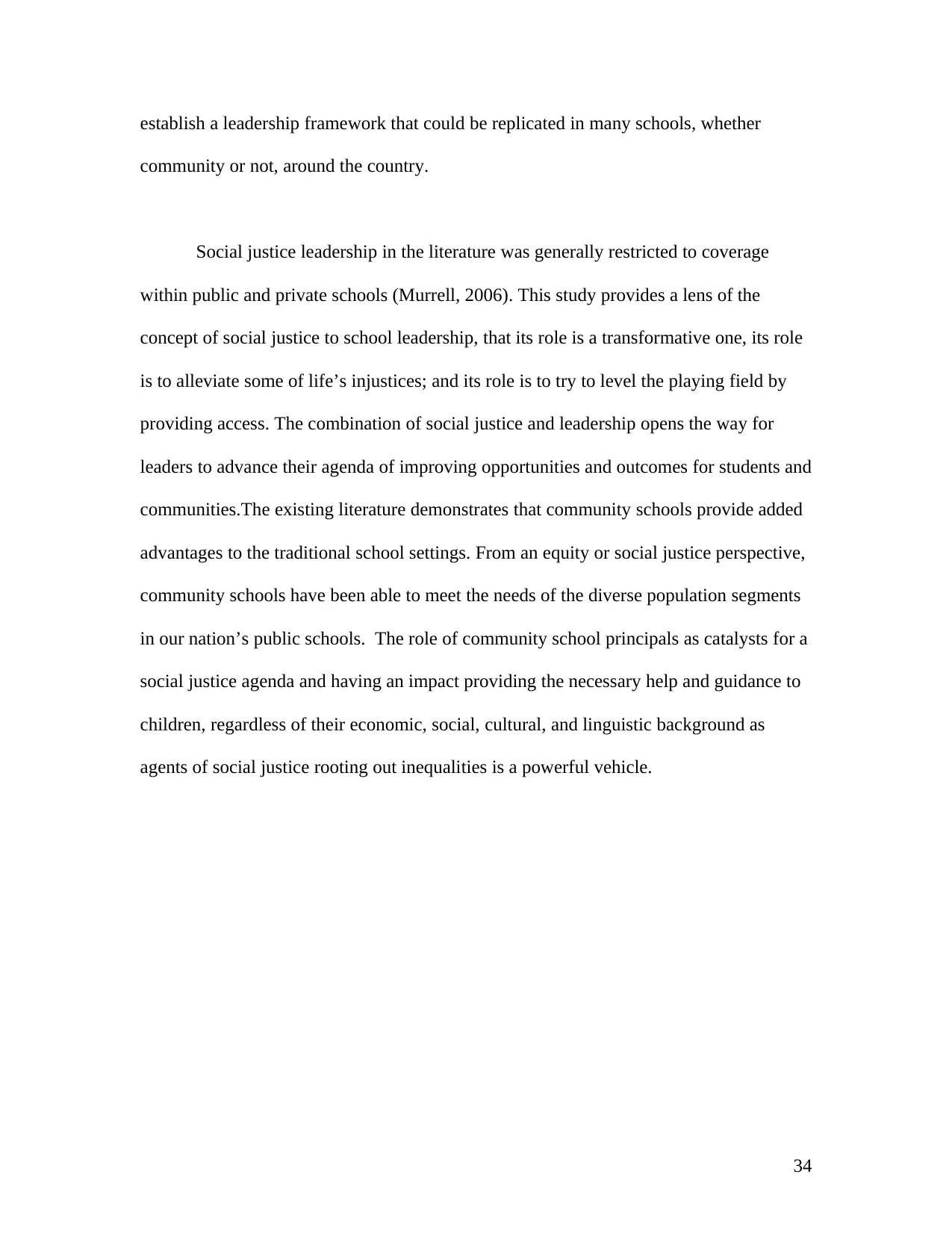
establish a leadership framework that could be replicated in many schools, whether
community or not, around the country.
Social justice leadership in the literature was generally restricted to coverage
within public and private schools (Murrell, 2006). This study provides a lens of the
concept of social justice to school leadership, that its role is a transformative one, its role
is to alleviate some of life’s injustices; and its role is to try to level the playing field by
providing access. The combination of social justice and leadership opens the way for
leaders to advance their agenda of improving opportunities and outcomes for students and
communities.The existing literature demonstrates that community schools provide added
advantages to the traditional school settings. From an equity or social justice perspective,
community schools have been able to meet the needs of the diverse population segments
in our nation’s public schools. The role of community school principals as catalysts for a
social justice agenda and having an impact providing the necessary help and guidance to
children, regardless of their economic, social, cultural, and linguistic background as
agents of social justice rooting out inequalities is a powerful vehicle.
34
community or not, around the country.
Social justice leadership in the literature was generally restricted to coverage
within public and private schools (Murrell, 2006). This study provides a lens of the
concept of social justice to school leadership, that its role is a transformative one, its role
is to alleviate some of life’s injustices; and its role is to try to level the playing field by
providing access. The combination of social justice and leadership opens the way for
leaders to advance their agenda of improving opportunities and outcomes for students and
communities.The existing literature demonstrates that community schools provide added
advantages to the traditional school settings. From an equity or social justice perspective,
community schools have been able to meet the needs of the diverse population segments
in our nation’s public schools. The role of community school principals as catalysts for a
social justice agenda and having an impact providing the necessary help and guidance to
children, regardless of their economic, social, cultural, and linguistic background as
agents of social justice rooting out inequalities is a powerful vehicle.
34
Secure Best Marks with AI Grader
Need help grading? Try our AI Grader for instant feedback on your assignments.
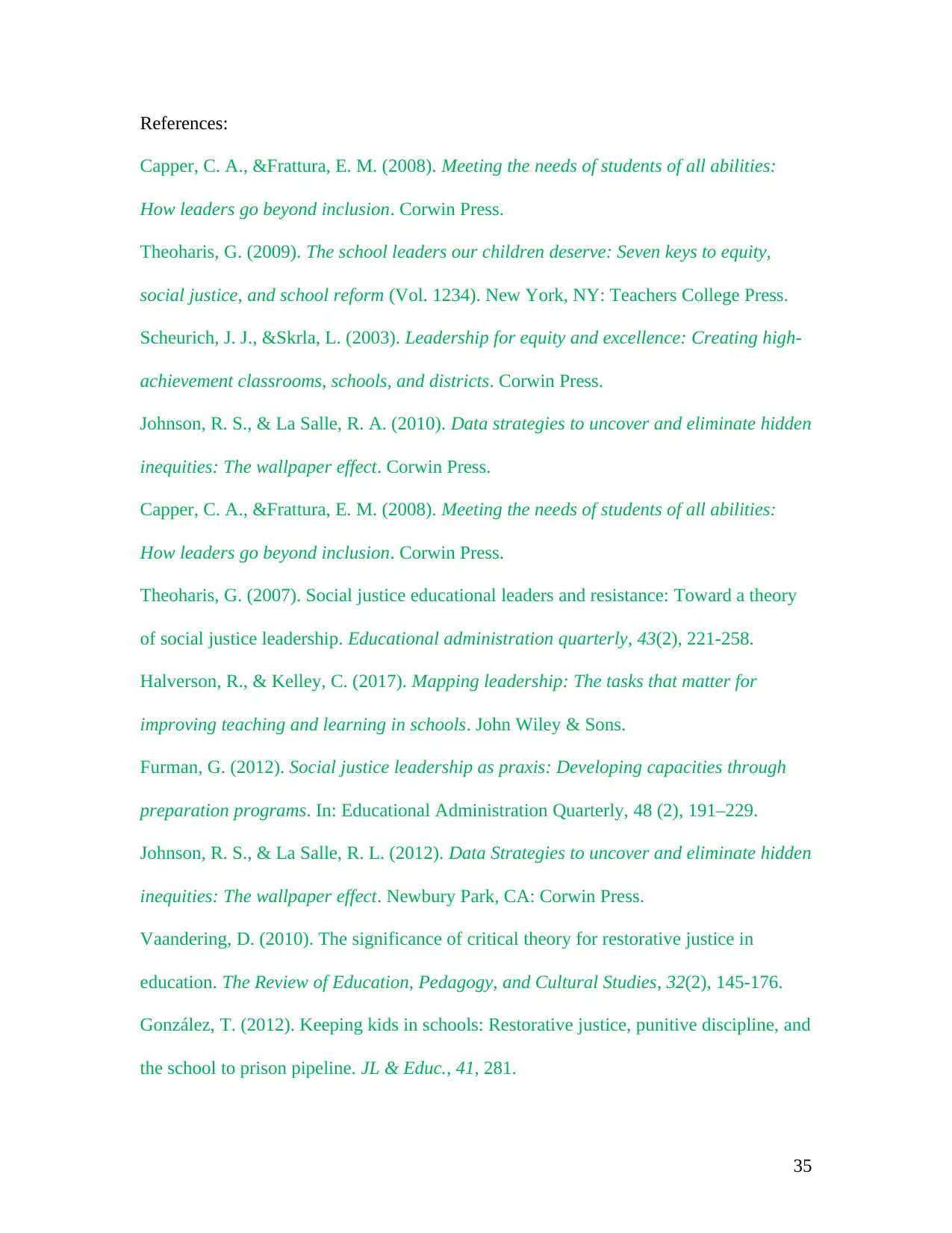
References:
Capper, C. A., &Frattura, E. M. (2008). Meeting the needs of students of all abilities:
How leaders go beyond inclusion. Corwin Press.
Theoharis, G. (2009). The school leaders our children deserve: Seven keys to equity,
social justice, and school reform (Vol. 1234). New York, NY: Teachers College Press.
Scheurich, J. J., &Skrla, L. (2003). Leadership for equity and excellence: Creating high-
achievement classrooms, schools, and districts. Corwin Press.
Johnson, R. S., & La Salle, R. A. (2010). Data strategies to uncover and eliminate hidden
inequities: The wallpaper effect. Corwin Press.
Capper, C. A., &Frattura, E. M. (2008). Meeting the needs of students of all abilities:
How leaders go beyond inclusion. Corwin Press.
Theoharis, G. (2007). Social justice educational leaders and resistance: Toward a theory
of social justice leadership. Educational administration quarterly, 43(2), 221-258.
Halverson, R., & Kelley, C. (2017). Mapping leadership: The tasks that matter for
improving teaching and learning in schools. John Wiley & Sons.
Furman, G. (2012). Social justice leadership as praxis: Developing capacities through
preparation programs. In: Educational Administration Quarterly, 48 (2), 191–229.
Johnson, R. S., & La Salle, R. L. (2012). Data Strategies to uncover and eliminate hidden
inequities: The wallpaper effect. Newbury Park, CA: Corwin Press.
Vaandering, D. (2010). The significance of critical theory for restorative justice in
education. The Review of Education, Pedagogy, and Cultural Studies, 32(2), 145-176.
González, T. (2012). Keeping kids in schools: Restorative justice, punitive discipline, and
the school to prison pipeline. JL & Educ., 41, 281.
35
Capper, C. A., &Frattura, E. M. (2008). Meeting the needs of students of all abilities:
How leaders go beyond inclusion. Corwin Press.
Theoharis, G. (2009). The school leaders our children deserve: Seven keys to equity,
social justice, and school reform (Vol. 1234). New York, NY: Teachers College Press.
Scheurich, J. J., &Skrla, L. (2003). Leadership for equity and excellence: Creating high-
achievement classrooms, schools, and districts. Corwin Press.
Johnson, R. S., & La Salle, R. A. (2010). Data strategies to uncover and eliminate hidden
inequities: The wallpaper effect. Corwin Press.
Capper, C. A., &Frattura, E. M. (2008). Meeting the needs of students of all abilities:
How leaders go beyond inclusion. Corwin Press.
Theoharis, G. (2007). Social justice educational leaders and resistance: Toward a theory
of social justice leadership. Educational administration quarterly, 43(2), 221-258.
Halverson, R., & Kelley, C. (2017). Mapping leadership: The tasks that matter for
improving teaching and learning in schools. John Wiley & Sons.
Furman, G. (2012). Social justice leadership as praxis: Developing capacities through
preparation programs. In: Educational Administration Quarterly, 48 (2), 191–229.
Johnson, R. S., & La Salle, R. L. (2012). Data Strategies to uncover and eliminate hidden
inequities: The wallpaper effect. Newbury Park, CA: Corwin Press.
Vaandering, D. (2010). The significance of critical theory for restorative justice in
education. The Review of Education, Pedagogy, and Cultural Studies, 32(2), 145-176.
González, T. (2012). Keeping kids in schools: Restorative justice, punitive discipline, and
the school to prison pipeline. JL & Educ., 41, 281.
35

36
1 out of 36
Your All-in-One AI-Powered Toolkit for Academic Success.
+13062052269
info@desklib.com
Available 24*7 on WhatsApp / Email
![[object Object]](/_next/static/media/star-bottom.7253800d.svg)
Unlock your academic potential
© 2024 | Zucol Services PVT LTD | All rights reserved.

